Field Test Recruitment Materials
Appendix A-1 - PISA 2022 Field Test Recruitment Materials v25.docx
Program for International Student Assessment 2021 (PISA 2021) Main Study Recruitment and Field Test
Field Test Recruitment Materials
OMB: 1850-0755
Program for International Student Assessment 2022 (PISA 2022) Main Study Recruitment and Field Test
Appendix A-1
Field Test Recruitment Materials
OMB# 1850-0755 v.25
National Center for Education Statistics (NCES)
U.S. Department of Education
Institute of Education Sciences
Washington, DC
October 2019
revised December 2019
Throughout this document are screenshots that show the web content of MyPISA.us for schools and school coordinators from the field test in PISA 2022, along with text for the PISA 2022 field test. The last section of this document, “MyPISA project website for School Coordinators and schools,” documents the contents of the website most extensively, but MyPISA screenshots also appear throughout the sections, “Instructions for School Coordinators to E-file student lists,” and “PISA 2022 Field Test School Coordinator Handbook”. MyPISA.us is described in Part B of the main study package.
The systems for the PISA 2022 Field Test are currently inactive, but will be reactivated in the spring of 2021. Additional changes will be needed after the field test on fall 2021 to update references to the PISA Main Study that will now occur in 2022, such as the appropriate birth year of students within the sample and the number of students to be sampled. These changes will be made to Appendix A-2 Main Study Recruitment Materials in change requests by May 2021.
TABLE OF CONTENTS
State PISA 2022 Field Test Letter 3
School District PISA 2022 Field Test Letter 4
School PISA 2022 Field Test Letter 6
PISA 2022 Field Test Brochure 8
PISA 2022 Field Test FAQ for school administrators - Front Page 10
PISA 2022 Field Test FAQ for Students 12
PISA 2022 Field Test Timeline of Activities 14
School Coordinator Email announcing E-Filing for Field Test 17
Instructions for School Coordinators to E-file student lists 18
PISA E-file reminder email to School Coordinator 26
Email to School Coordinator when student samples are complete and Student Tracking and School
Logon Forms have been posted to MyPISA.us 27
PISA 2022 Field Test – Principal Questionnaire Invitation 28
PISA 2022 Field Test Questionnaire Login Pages - School 29
PISA 2022 Field Test– Principal Reminder 1 30
PISA 2022 Field Test– Principal Reminder 2 31
PISA 2022 Field Test Student Login From 32
PISA 2022 Field Test School Coordinator Handbook Cover Letter 33
PISA 2022 Field Test School Coordinator Handbook 34
MyPISA project website for School Coordinators and schools 71
PISA 2022 Field Test Student Presentation Video 93

State PISA 2022 Field Test Letter
[Date]
[Title] [Name First] [Name Last]
[Title/Department]
[State]
[Address 1]
[Address 2]
[City], [State] [Zip code]
Dear [Title] [Name Last]:
The United States and more than 80 other countries and education systems will participate in the 2022 Program for International Student Assessment (PISA). PISA is the largest international education study in the world and measures the mathematics, reading, science, and financial literacy of students nearing the end of compulsory education. I am writing to thank you for supporting the PISA field test this past spring when, due to the pandemic, PISA was suspend before data collection could commence. I am asking your agency to support the participation of the schools in your state that have been randomly selected to take the PISA field test rescheduled for the fall of 2021.
While participation is voluntary, your state’s participation ensures that the U.S. results are complete, accurate, and representative of all students across the country. Researchers and policymakers use PISA results to compare national progress against international standards and the educational progress of our global economic peers and competitors. The purposes of the field test are to refine operational processes and ensure new questions accurately measure students’ knowledge and skills and are unbiased toward U.S. students.
To acknowledge their time and effort, participating schools, school coordinators (a school staff person designated to communicate with PISA staff), and students will receive an honorarium for their participation in the PISA field test.
PISA is conducted in the United States by the National Center for Education Statistics (NCES) within the U.S. Department of Education and is administered by Westat, a research firm in Rockville, Maryland. The U.S. Office of Management and Budget (OMB) has approved the data collection under OMB# 1850-0755. You can find more details about PISA, including information on the confidentiality of the data collected, in the enclosed materials.
Westat will contact sampled school districts and schools in the next few weeks to discuss participation. We understand the ongoing challenges schools face due to COVID-19, and the health and safety of students and school staff is our top priority. PISA representatives will provide significant assistance to schools by administering the field test and bringing all necessary materials and equipment. Information about our protocols is included in the enclosed COVID-19 Protocols document.
We are also in contact with your state assessment director and NAEP State Coordinator to try to ensure we do not conflict with other state efforts and to help districts and schools understand how the PISA field test fits in with other NCES data collections.
If you have questions about the study in the meantime, please call David Kastberg at 301-294-3811 or send an email to [email protected]. You may also get more information by contacting Samantha Burg at NCES at 202-245-7537 or [email protected], or by visiting the PISA website at http://nces.ed.gov/surveys/pisa.
Thank you for your time and support.
Sincerely,
Peggy Carr, Ph.D.
Associate Commissioner, National Center for Education Statistics
cc: [State assessment coordinator name]
Enclosures
The National Center for Education Statistics (NCES) is authorized to conduct the Program for International Student Assessment (PISA) by the Education Sciences Reform Act of 2002 (ESRA 2002, 20 U.S.C. §9543), and to collect students’ education records from educational agencies or institutions for the purpose of evaluating federally supported education programs under the Family Educational Rights and Privacy Act (FERPA, 34 CFR §§ 99.31(a)(3)(iii) and 99.35). The data are being collected for NCES by Westat, a U.S.-based research organization. All of the information you provide may be used only for statistical purposes and may not be disclosed, or used, in identifiable form for any other purpose except as required by law (20 U.S.C. §9573 and 6 U.S.C. §151).

School District PISA 2022 Field Test Letter
[Date]
[Title] [Name First] [Name Last], [Title/Department]
[School District]
[Address 1]
[City], [State] [Zip code]
Dear [Title] [Name Last]:
The United States and more than 80 other countries and education systems will participate in the 2022 Program for International Student Assessment (PISA). PISA is the largest international education study in the world and measures the mathematics, reading, science, and financial literacy of students nearing the end of compulsory education. I am writing to [thank you for supporting the PISA field test this past spring when, due to the pandemic, PISA was suspend before data collection could commence. I am asking/] ask your agency to support the participation of the schools in your district that have been randomly selected to take the PISA field test rescheduled for the fall of 2021 and to include the assessment window (September 20–October 29, 2021) on your district calendar.
While participation is voluntary, your district’s participation ensures that the U.S. results are complete, accurate, and representative of all students across the country. PISA results are used by researchers and policymakers to chart national progress against international standards and the educational progress of our global economic peers and competitors. The purposes of the field test are to refine operational processes and try out new questions to ensure they accurately measure students’ knowledge and skills, and are unbiased toward U.S. students.
While participation in this study is voluntary, your school plays an important role in ensuring that the U.S. sample is representative of the knowledge and skills of all students across the country. As a thank you for your time and effort to participate in the PISA field test, your school will receive $250 for participating.
Your school’s PISA school coordinator (a school staff person designated to communicate with PISA staff) will receive $200 as a thank you for their time and effort.
Each participating student will be eligible to receive $25 and a volunteer service certificate of 4 hours from the U.S. Department of Education.
PISA is conducted in the United States by the National Center for Education Statistics (NCES) within the U.S. Department of Education and is administered by Westat, a research firm in Rockville, Maryland. The U.S. Office of Management and Budget has approved the data collection under OMB# 1850-0755. You can find more details about PISA, including information on the confidentiality of the data collected, in the enclosed materials.
Within the next few days, Westat will contact the following school(s) in your district that have been selected for PISA: [LIST SAMPLED SCHOOLS HERE…].
We understand the ongoing challenges schools face due to COVID-19, and the health and safety of students and school staff is our top priority. PISA representatives will provide significant assistance to schools by administering the field test and bringing all necessary materials and equipment. Information about our protocols is included in the enclosed COVID-19 Protocols document.
If you have any questions, please do not hesitate to call 1-888-638-2597 or email [email protected]. You may also get more information by contacting Samantha Burg at NCES at 202-245-7537 or [email protected], or by visiting the PISA website at http://nces.ed.gov/surveys/pisa.
Thank you for your time and support.
Sincerely,
Peggy Carr, Ph.D.
Associate Commissioner, National Center for Education Statistics
cc: [State assessment coordinator name]
Enclosures
The National Center for Education Statistics (NCES) is authorized to conduct the Program for International Student Assessment (PISA) by the Education Sciences Reform Act of 2002 (ESRA 2002, 20 U.S.C. §9543), and to collect students’ education records from educational agencies or institutions for the purpose of evaluating federally supported education programs under the Family Educational Rights and Privacy Act (FERPA, 34 CFR §§ 99.31(a)(3)(iii) and 99.35). The data are being collected for NCES by Westat, a U.S.-based research organization. All of the information you provide may be used only for statistical purposes and may not be disclosed, or used, in identifiable form for any other purpose except as required by law (20 U.S.C. §9573 and 6 U.S.C. §151).

School PISA 2022 Field Test Letter
[Date]
[Title] [Name First] [Name Last], [Title/Department]
[School District]
[Address 1]
[City], [State] [Zip code]
Dear [Title] [Name Last]:
The United States and more than 80 other countries and education systems will participate in the 2022 Program for International Student Assessment (PISA). PISA is the largest international education study in the world and measures the reading, mathematics, science, and financial literacy of students nearing the end of compulsory education. [I want to thank you for your commitment to participate in PISA this past spring when, due to the pandemic, the field test was suspended before data collection could commence.] Your school is one of about 50 schools across the United States that has been randomly selected to take part in the PISA field test [rescheduled] for fall 2021.
PISA provides comparative information on the performance of U.S. students with their peers in other countries. It fosters international engagement across education systems, allowing teachers, education professionals, and policy experts to compare shared experiences in the global learning community. The financial literacy component of PISA provides a range of contextual data that offer insight into students’ school and home environments, socioeconomic advantages and disadvantages, sense of well-being, and use of time outside of school. The purposes of the field test are to refine operational processes and ensure new questions accurately measure students’ knowledge and skills and are unbiased toward U.S. students.
While participation in this study is voluntary, your school plays an important role in ensuring that the U.S. sample is representative of the knowledge and skills of all students across the country. As a thank you for your time and effort to participate in the PISA field test, your school will receive $250 for participating.
Your school’s PISA school coordinator (a school staff person designated to communicate with PISA staff) will receive $200 as a thank you for their time and effort.
Each participating student will be eligible to receive $25 and a volunteer service certificate of 4 hours from the U.S. Department of Education.
Please review the enclosed materials to learn more about the PISA assessment experience and the benefits of participating. PISA is conducted in the United States by the National Center for Education Statistics (NCES) within the U.S. Department of Education and is administered by Westat, a research firm in Rockville, Maryland. The U.S. Office of Management and Budget (OMB) has approved the data collection under OMB# 1850-0755. Please see the enclosed FAQ for more information on the confidentiality of the data collected.
The PISA field test window is September 20–October 29, 2021. Within the next few days, Westat will contact you to discuss your school’s participation. We understand the ongoing challenges your school faces due to COVID-19, and the health and safety of your students and school staff is our top priority. We will provide significant support to your school by administering the field test and bringing all necessary materials and equipment. Information about our protocols is included in the enclosed COVID-19 Protocols document.
If you have any questions, please do not hesitate to call 1-888-638-2597 or email [email protected]. You may also get more information by contacting Samantha Burg at NCES at 202-245-7537 or [email protected], or by visiting the PISA website at http://nces.ed.gov/surveys/pisa.
Your school’s participation in the PISA field test is vital to ensuring a fair and valid assessment for all U.S. students. Thank you for your time and for supporting this important international education study.
Sincerely,
Peggy Carr, Ph.D.
Associate Commissioner, National Center for Education Statistics
cc: [State assessment coordinator name]
Enclosures
The National Center for Education Statistics (NCES) is authorized to conduct the Program for International Student Assessment (PISA) by the Education Sciences Reform Act of 2002 (ESRA 2002, 20 U.S.C. §9543), and to collect students’ education records from educational agencies or institutions for the purpose of evaluating federally supported education programs under the Family Educational Rights and Privacy Act (FERPA, 34 CFR §§ 99.31(a)(3)(iii) and 99.35). The data are being collected for NCES by Westat, a U.S.-based research organization. All of the information you provide may be used only for statistical purposes and may not be disclosed, or used, in identifiable form for any other purpose except as required by law (20 U.S.C. §9573 and 6 U.S.C. §151).
PISA
2022 Field Test Brochure –Front Cover
What is PISA?
The Program for International Student Assessment (PISA) is an international assessment of students nearing the end of compulsory education that measures how well students apply their knowledge and skills in mathematics, reading, science, and financial literacy to problems set in real-life contexts. Conducted seven times since 2000, the next round of PISA in 2022 will include students from more than 80 countries and education systems around the world, including the United States. PISA is coordinated by the Organization for Economic Cooperation and Development (OECD) and conducted in the United States by the National Center for Education Statistics (NCES) within the U.S. Department of Education.
Why is PISA important and what are the benefits of participating?
PISA provides a unique opportunity for the United States to understand how well students nearing the end of compulsory education are prepared to enter the workforce or post-secondary education in comparison to their peers from more than 80 countries. Through participating in PISA, schools, and students contribute to ongoing efforts to improve education in our country. PISA helps identify U.S. students’ strengths and weaknesses in the domains of mathematics, reading, science, and financial literacy and offers insights into successful policies and practices in other countries.
Each school and student that participates in PISA plays a vital role in representing other schools and students that are similar. It is essential that sampled schools contribute to this important measurement of educational progress to ensure the U.S. sample reflects the knowledge and skills of all students across the country.
As a token of appreciation for participating, schools will receive $250, the school coordinator will receive $200, students who participate will each receive $25 as well as 4 hours of volunteer service time.
What is the purpose of the PISA Field Test in fall 2021?
PISA conducts a field test (a small-scale, trial run of the assessment) in every participating country to determine if any of the test questions are biased because of national, social, or cultural differences and whether field operations worked as planned. Analyses of student responses are conducted to check for evidence of unanticipated differences in student performance across countries that could indicate a linguistic or conceptual translation problem. Test items found to be problematic are revised to mitigate identified issues or dropped from the assessment altogether. In fall 2021, the United States will participate in the PISA 2022 field test. Assessments will be conducted using computers. The field test data will provide valuable information to ensure that the PISA 2022 assessment is unbiased and fair to U.S. students.
What will schools and students be asked to do in the PISA field test?
The PISA 2022 field test has three primary components: (1) a computer-based student assessment, (2) a computer-based student questionnaire, and (3) an online school questionnaire.
Up to 60 students in each school will be selected to participate in the PISA assessment, which takes about 3 hours, including instructions, breaks, and a questionnaire. Students will answer questions in various combinations of mathematics, reading, science, and financial literacy.
The principal of each school will be asked to appoint a staff member to act as the PISA school coordinator. The school coordinator will work with Westat staff to coordinate the assessment and submit a student list for sampling. The principal of each school will also be asked to complete a 45-minute online questionnaire about school and student body characteristics and policies.
PISA
2022 Field Test Brochure – (Continued Inside Cover)
How is PISA developed?
PISA is developed through an international collaborative process involving input from U.S. and international experts in science, reading, mathematics, financial literacy, and educational measurement. The PISA assessment materials are thoroughly reviewed by within-country experts to make sure the materials are appropriate for each country’s students. Finally, the final assessment materials are endorsed by all participating countries.
What do PISA questions look like?
Some items require students to select from among possible responses, while others require students solve problems and provide written answers. Examples of PISA assessment questions are available at http://nces.ed.gov/surveys/pisa/educators.asp and https://www.oecd.org/pisa/pisaproducts/pisa-test-questions.htm.
Which countries are participating in PISA 2022?
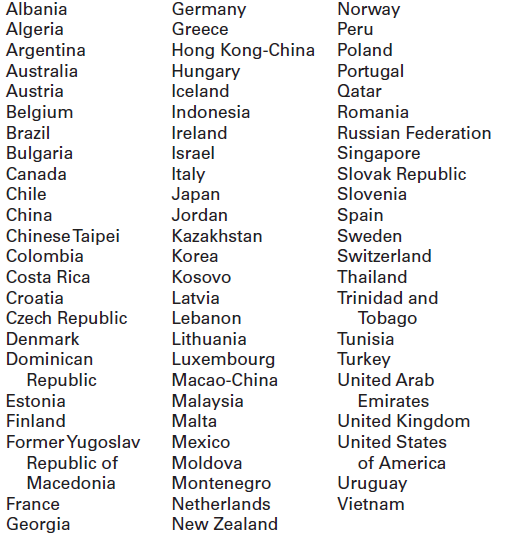
Where do I find more information?
Visit the PISA website at http://nces.ed.gov/surveys/pisa.
For additional questions about PISA 2022, contact the PISA U.S. home office at 1-888-638-2597 or email [email protected].
The National Center for Education Statistics (NCES) is authorized to conduct the Program for International Student Assessment (PISA) by the Education Sciences Reform Act of 2002 (ESRA 2002, 20 U.S.C. §9543), and to collect students’ education records from educational agencies or institutions for the purpose of evaluating federally supported education programs under the Family Educational Rights and Privacy Act (FERPA, 34 CFR §§ 99.31(a)(3)(iii) and 99.35). The data are being collected for NCES by Westat, a U.S.-based research organization. All of the information you provide may be used only for statistical purposes and may not be disclosed, or used, in identifiable form for any other purpose except as required by law (20 U.S.C. §9573 and 6 U.S.C. §151).

PISA 2022 Field Test FAQ
for school administrators –Front Page
Program for International Student Assessment
FREQUENTLY ASKED QUESTIONS
PISA 2022 Field Test (Fall 2021)
Information for Schools
PISA is an international assessment of students nearing the end of compulsory education that measures how well students apply their knowledge and skills to solve problems related to mathematics, reading, and science, and financial literacy in real-life contexts. In the PISA 2022 field test, students will be assessed in mathematics, reading, science, financial literacy, or some combination of these subjects. The PISA 2022 field test will be administered in the fall 2021.
What does participating in PISA entail?
Each school is asked to designate a school coordinator to work with Westat and to submit a list of all students born on or between July 1, 2005 and June 30, 2006. Up to 60 students in each school will be sampled to participate in the PISA assessment, which takes about 3 hours of total time, including instructions, breaks, and a questionnaire. The principal of each school will also be asked to complete an online questionnaire about school and student body characteristics and policies.
What is the field test for?
Field tests are a critical part of the development of test questions for international assessments like PISA. These small-scale, trial runs of an assessment allow assessment developers to try out new questions to determine their performance when administered to students around the world. The results of the U.S. field test will help assessment developers to eliminate wording or topics that would put U.S. students at a disadvantage relative to students in other countries. The field test also ensures that data collection procedures are done efficiently and correctly.
Why should my school and students participate?
Your school was randomly selected so that the overall U.S. field test sample would be representative of the overall U.S. school population. Field-testing on a diverse sample of students from a variety of schools, locations, and backgrounds ensures that the assessment wording and concepts are not regionally, culturally, or socially biased. The participation of selected schools in the United States is vital to ensuring an accurate representation of the overall population of students nearing the end of compulsory education across the country—including U.S. public and private schools. Although the assessment is voluntary, we rely on school and student participation to ensure the results are complete and accurate. We cannot do that without the support of schools like yours.
As a token of appreciation for participating, schools will receive $250, the school coordinator will receive $200, and students who participate will each receive $25 as well as 4 hours of volunteer service time.
What are the benefits to participating?
PISA informs national discussions about education as well as international competitiveness. By participating, students ensure fairness in the questions that will be used in the main study in 2022. Field-testing the assessment questions will identify wording and concepts that could disadvantage U.S. students in the main study. Students’ efforts in the field test ensure that the achievement of our nation’s 15-year-olds is accurately and fairly reported.
Is it possible that my school will be selected for the main study as well as the field test?
It is extremely unlikely that a school selected for the field test will be selected for the main study.
Will all of our students be asked to participate?
Probably not. In each school, all students born on or between July 1, 2005 and June 30, 2006 and enrolled in grade 7 or higher will have an equal chance of selection. Up to 60 students in each school will be selected to participate. Only in very small schools will the school sample likely include all eligible students. In addition, some students with disabilities or limited English proficiency may be offered a limited set of accommodations to enable their participation; otherwise, they may be excused from the assessment.
PISA 2022 Field Test FAQ for
school administrators – Back Page
Who conducts the PISA assessment?
The National Center for Education Statistics (NCES), within the U.S. Department of Education, conducts this study as authorized by the Education Sciences Reform Act of 2002 (ESRA 2002, 20 U.S.C. §9543) and with the approval of the U.S. Office of Management and Budget under OMB# 1850-0755. The assessment process will be undertaken by trained staff from Westat, a research organization under contract to NCES. In compliance with standard protocols, Westat field staff undergoes FBI background checks.
How is the school questionnaire administered?
The school questionnaire is administered online from a secure website. The school questionnaire, which looks at school characteristics such as enrollment and school practices, takes less than an hour to complete.
Do teachers or other school staff need to help administer the assessment?
No. Westat field staff will visit the school on the day of the assessment, bringing with them all the materials required, and will handle the entire administration of the assessment. Field staff will also bring all of the necessary computer equipment. There is no requirement for school resources such as school computers or access to the internet. All that is required is adequate space to set up the equipment and assess the students.
When will the PISA field test be conducted?
The PISA field test will be conducted between September 20 and October 29, 2021. Westat will work with schools to identify an assessment date convenient for the school in that time period.
How long does PISA take?
Students will take a computer-based assessment. This approximately 4-hour session includes time for instructions, the assessment, breaks, and a questionnaire that students complete about themselves. The assessment location will be used for about 5 hours total, including setup and breakdown by Westat staff. All assessment activities will take place in one day.
What will happen with the collected data?
The data collected for PISA will be used to report on students’ knowledge and skills as group descriptions at the national level. All of the information provided by school staff and students may be used only for statistical purposes and may not be disclosed, or used, in identifiable form for any other purpose except as required by law (20 U.S.C. §9573 and 6 U.S.C. §151). The U.S. Office of Management and Budget has approved this data collection under OMB# 1850-0755. Reports of the findings from PISA will not identify participating districts, schools, students, or individual staff. Individual responses will be combined with those from other participants to produce summary statistics and reports.
Where can I find more information?
Visit the PISA website at http://nces.ed.gov/surveys/pisa. For additional questions about PISA 2022, contact the PISA U.S. home office at 1-888-638-2597 or email [email protected].
The National Center for Education Statistics (NCES) is authorized to conduct the Program for International Student Assessment (PISA) by the Education Sciences Reform Act of 2002 (ESRA 2002, 20 U.S.C. §9543), and to collect students’ education records from educational agencies or institutions for the purpose of evaluating federally supported education programs under the Family Educational Rights and Privacy Act (FERPA, 34 CFR §§ 99.31(a)(3)(iii) and 99.35). The data are being collected for NCES by Westat, a U.S.-based research organization. All of the information you provide may be used only for statistical purposes and may not be disclosed, or used, in identifiable form for any other purpose except as required by law (20 U.S.C. §9573 and 6 U.S.C. §151).

PISA 2022 Field Test FAQ for Students
Program for International Student Assessment
FREQUENTLY ASKED QUESTIONS
PISA 2022 Field Test (Fall 2021)
Information for Students
What is PISA?
The Program for International Student Assessment (PISA) is an international assessment of students nearing the end of mandatory schooling that measures how well students apply their knowledge and skills in solving problems in reading, mathematics, science, and financial literacy. Conducted every three years, PISA presents problems that students are likely to encounter in the real world. This spring, students like you from more than 80 countries and education systems, including the United States, will participate in the PISA field test.
Why should I participate in PISA?
You are one of up to 60 students in your school who have been selected to participate in PISA. Participation in PISA is voluntary, but each student who participates plays a vital role in ensuring the U.S. results are representative of all types of schools and education environments across the country—including public and private schools. Plus, if you participate in PISA you will…
• Receive a certificate for 4-hours of volunteer service from the U.S. Department of Education;
• Represent students like you across the country; and
• Make an important contribution to this global effort to understand students’ ability by representing other
students just like you across the United States.
Only 3,000 students will have the unique opportunity to participate in PISA across the United States. How often do you get the chance to represent your country? Participating in PISA is a national service. You can have an impact on the bigger picture of education in the United States and around the world.
What subjects are assessed in PISA?
Each student participating in PISA will be assessed in various combinations of the following subjects: reading, mathematics, science, and financial literacy.
What types of questions will I see on PISA?
PISA questions assess the knowledge and skills students have learned, both in and out of school, based on situations you may encounter in real life. Some PISA questions require that you select from a set of provided answers; other PISA questions require that you write out your response. PISA is administered on computer and many of the items are interactive, where you manipulate different pieces of information. To try PISA items on your own, please visit http://www.oecd.org/pisa/test/.
How long does PISA take?
The PISA assessment takes approximately 4 hours to complete. This includes time for instructions, the assessment, breaks, and a survey about you.
How did my school get selected to take PISA?
The schools that participate in PISA in the United States are randomly selected from a list of all schools in the country that enroll age-eligible students. This is done to ensure that U.S. participants accurately represent the entire population of students nearing the end of compulsory education and not just particular types of schools or groups of students.
How did I get selected to take PISA?
The only criteria for being eligible to be selected for PISA are being born on or between July 1, 2005 and June 30, 2006 and enrolled in grade 7 or higher. From a list of all eligible students provided by your school, up to 60 students were randomly selected to participate. Every eligible student enrolled in a PISA selected school has an equal chance of being selected. Students in other countries are selected in the same way to make sure each country is fairly represented and no country is advantaged or disadvantaged because of the types of schools or groups of students selected.
What is done with the information you collect from me?
PISA is not designed to produce individual test scores and your individual performance is not shared with your teachers, school, or district in any way. Student responses are combined with other student responses and are only used for statistical purposes. The data collected for PISA will be used to report on students’ knowledge and skills as group descriptions at the national level. All of the information you provide may be used only for statistical purposes and may not be disclosed, or used, in identifiable form for any other purpose except as required by law (20 U.S.C. §9573 and 6 U.S.C. §151). The U.S. Office of Management and Budget has approved this data collection under OMB# 1850-0755.
Where can I find more information?
Visit the PISA website at http://nces.ed.gov/surveys/pisa. For additional questions about PISA, contact the PISA U.S. home office at 1-888-638-2597 or email [email protected].
The National Center for Education Statistics (NCES) is authorized to conduct the Program for International Student Assessment (PISA) by the Education Sciences Reform Act of 2002 (ESRA 2002, 20 U.S.C. §9543), and to collect students’ education records from educational agencies or institutions for the purpose of evaluating federally supported education programs under the Family Educational Rights and Privacy Act (FERPA, 34 CFR §§ 99.31(a)(3)(iii) and 99.35). The data are being collected for NCES by Westat, a U.S.-based research organization. All of the information you provide may be used only for statistical purposes and may not be disclosed, or used, in identifiable form for any other purpose except as required by law (20 U.S.C. §9573 and 6 U.S.C. §151).
PISA
2022 Field Test Timeline of Activities

|
May-June 2021 |
August-September 2021 Pre-assessment Contact |
September-October 2021 Assessment Visit |
Acknowledgements and Benefits |
|
Principal
|
|
|
|
|
|
School Coordinator |
|
|
|
|
|
Students |
|
|
|
|
|
PISA Staff |
|
|
|
|
|
Find Out More |
|||||
PISA
2022 Field Test COVID-19 Protocols

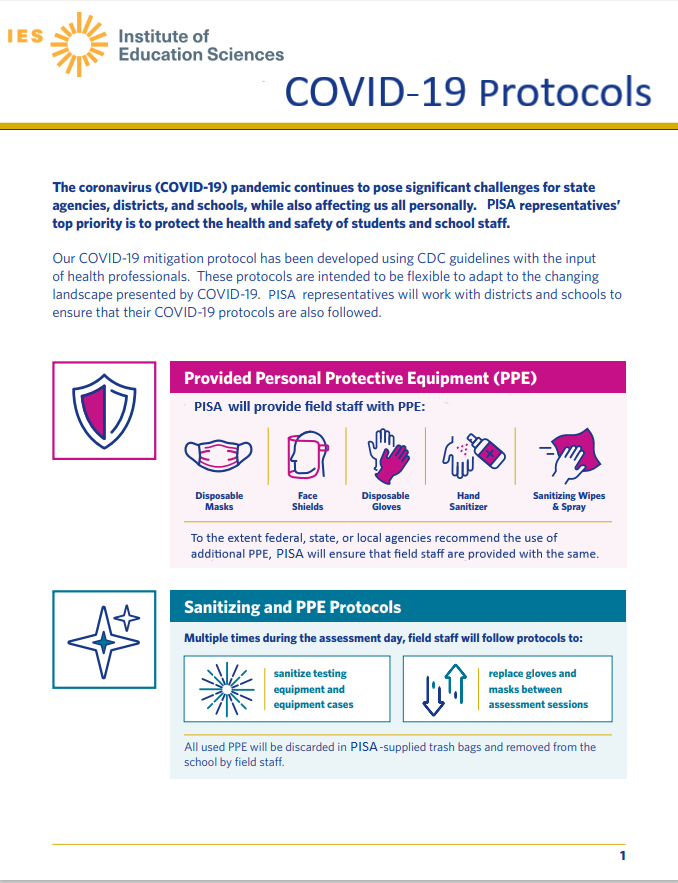
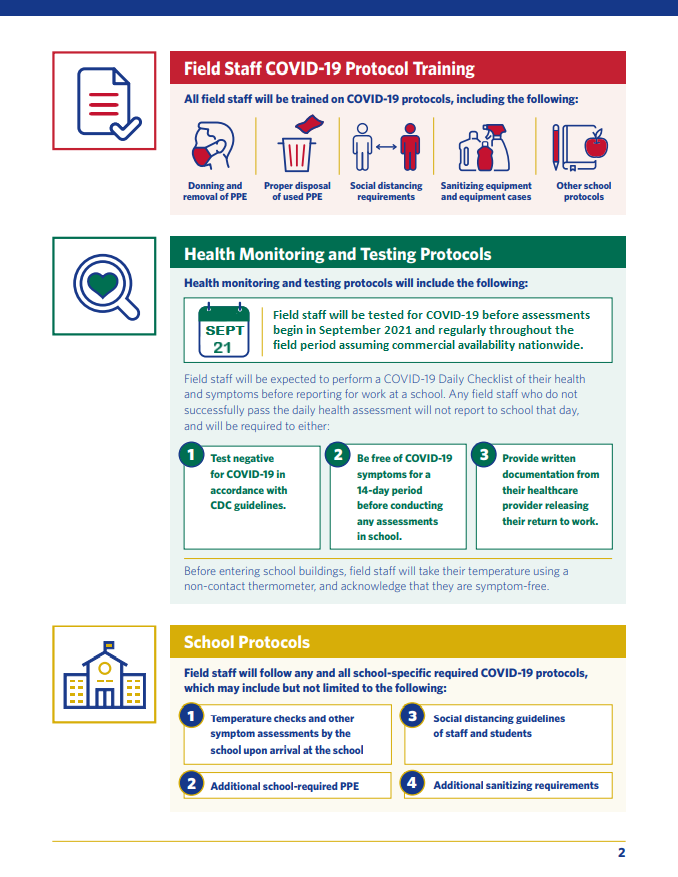

School Coordinator Email announcing E-Filing for Field Test
Subject: PISA E-Filing open
Attachment: PISA 2022 Field Test E-Filing Instructions
Dear,
Thank you for your time and effort working on the PISA 2022 field test!
We are pleased to announce that WWW.MYPISA.US is now ready to receive student electronic listing files (e-files).
The instructions for preparing and submitting your school’s student listing files are attached to this email. The PISA E-filing Instructions can also be accessed online from the website. Along with the instructions, we’ve prepared a formatted Excel template to make preparing the e-file more convenient.
If you have yet to register on WWW.MYPISA.US, please let us know so we can send you the registration ID for your school.
Reach out to the PISA help desk by phone between 8 a.m. and 8 p.m. Eastern Time at 1-888-638-2597 or email [email protected].
Thanks again for your support.
All the best,
The U.S. PISA Team
The National Center for Education Statistics (NCES) is authorized to conduct the Program for International Student Assessment (PISA) by the Education Sciences Reform Act of 2002 (ESRA 2002, 20 U.S.C. §9543), and to collect students’ education records from educational agencies or institutions for the purpose of evaluating federally supported education programs under the Family Educational Rights and Privacy Act (FERPA, 34 CFR §§ 99.31(a)(3)(iii) and 99.35). The data are being collected for NCES by Westat, a U.S.-based research organization. All of the information you provide may be used only for statistical purposes and may not be disclosed, or used, in identifiable form for any other purpose except as required by law (20 U.S.C. §9573 and 6 U.S.C. §151).

Instructions for School Coordinators to E-file student lists
PREPARE ELECTRONIC STUDENT FILE (E-FILE)........................................................ 1
Step 1: Identify ALL students at your school who meet the eligibility criteria...................................... 1
Step 2: List each of the eligible students................................................................................................ 1
Submitting your Electronic Student File............................................................................................ 2
Student E-File Step 1: Upload your file..................................................................................................... 2
Student E-File Step 2: Identify your column contents.............................................................................. 2
Student E-File Step 3: Match your values to PISA codes.......................................................................... 3
Student E-File Step 4: Verify your E-File............................................................................................... 4
Online Student Data Checks 5
The National Center for Education Statistics (NCES) is authorized to conduct the Program for International Student Assessment (PISA) by the Education Sciences Reform Act of 2002 (ESRA 2002, 20 U.S.C. §9543), and to collect students’ education records from educational agencies or institutions for the purpose of evaluating federally supported education programs under the Family Educational Rights and Privacy Act (FERPA, 34 CFR §§ 99.31(a)(3)(iii) and 99.35). The data are being collected for NCES by Westat, a U.S.-based research organization. All of the information you provide may be used only for statistical purposes and may not be disclosed, or used, in identifiable form for any other purpose except as required by law (20 U.S.C. §9573 and 6 U.S.C. §151). According to the Paperwork Reduction Act of 1995, no persons are required to respond to a collection of information unless such collection displays a valid OMB control number. The valid OMB control number for this voluntary information collection is 1850-0755. The time required to complete this information collection is estimated to average up to 240 minutes per school coordinator, including the time to review instructions, gather the data needed, and complete and review the information collection. If you have any comments or concerns regarding the accuracy of the time estimate(s), suggestions for improving the form, or questions about the status of your individual submission of this form, write directly to: The Program for International Student Assessment (PISA) 2022, National Center for Education Statistics (NCES), Potomac Center Plaza, 550 12th Street, SW, Room 4007, Washington, DC 20202.
PISA 2022: Student Records Collection: 4 hours
OMB Clearance Number 1850-0755
Expiration Date: xx/xx/xxxx
Preparing the PISA Electronic Student File (E-File)
Step 1: Identify ALL students at your school who meet the eligibility criteria
Criteria for PISA student eligibility are:
Enrolled in Grade 7 or higher, AND
Born between July 1, 2005 and June 30, 2006.
PISA needs accurate information about all students at your school who meet the above criteria for student eligibility. Include all students, even those students who typically may be excluded from other testing programs, such as students with IEPs or 504 plans (SD), English language learners (ELL), or students with limited English proficiency (LEP). Do not include students who are known to be withdrawn on your list. All other eligible students must be added to your list of students.
Step 2: List each of the eligible students along with their demographic information (see Figure 1 below for an example)
Using the Excel template provided on the MyPISA.us website (www.MyPISA.us), list students in your school who are eligible for PISA along with their demographic information.
Student first name
Student middle name (not required)
Student last name
Grade in school (Grade 7 – Grade 12 as applicable)
Month of birth (M or MM; must be submitted in numeric format, not text (1 or 01 for JAN))
Year of birth (YYYY: 2005 or 2006)
Sex (numeric or text (1/2, F/M))
Figure 1: Example of Electronic Student File

Submitting the PISA Electronic Student File (E-File)
Step 1: Upload file. After you have created and saved your student E-File, proceed to www.MyPISA.us. Once you have logged in, click the ‘Submit Student List’ link on the left side of the page (Box 1 below). Then click the “Browse” button to locate your file (box 2 below). Once you’ve located the file and clicked ok, click “Upload” (box 3 below).
Exhibit 1. Submit Student List - initial screen
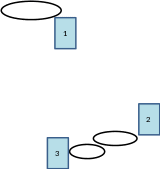
![]()
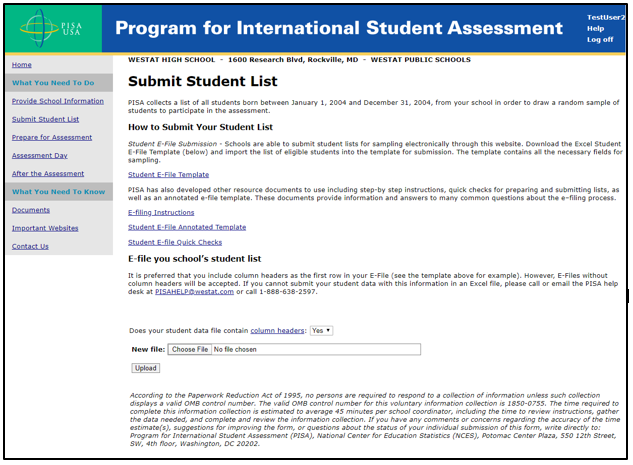
![]()
Step 2: Map Columns. The column headings in your file are shown in rows on the left side of the page. In each row, for each heading on the left, click on the down arrow next to the words in the table that read "Column Contains..." on the right. If there is no appropriate description in the drop-down list for your column heading, select N/A.
Exhibit 2. Submit Student List – Identify Your Columns



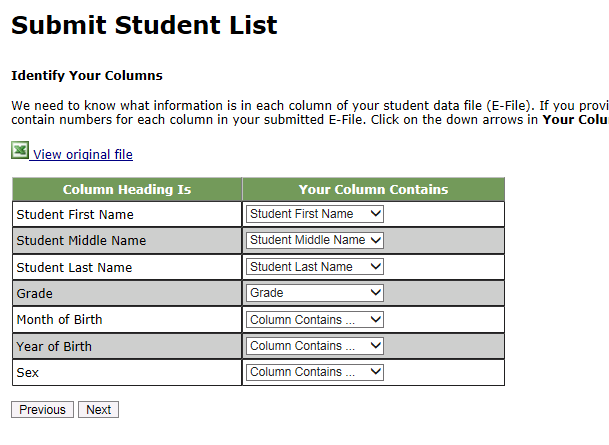
Step 3: Match Values to PISA Codes. The next step is matching the values on your file to PISA codes. The values in your columns will again be displayed on the left. Select the corresponding PISA code from the drop down list on the right (see exhibit 3). If there is no appropriate description in the drop-down list for your column heading, select N/A. When you are finished matching your values to PISA codes, click next. Repeat the above instructions to assign male/female codes and click next (see exhibit 4).
Exhibit 3. Submit Student List - Match your Values to PISA Codes (grade mapping)
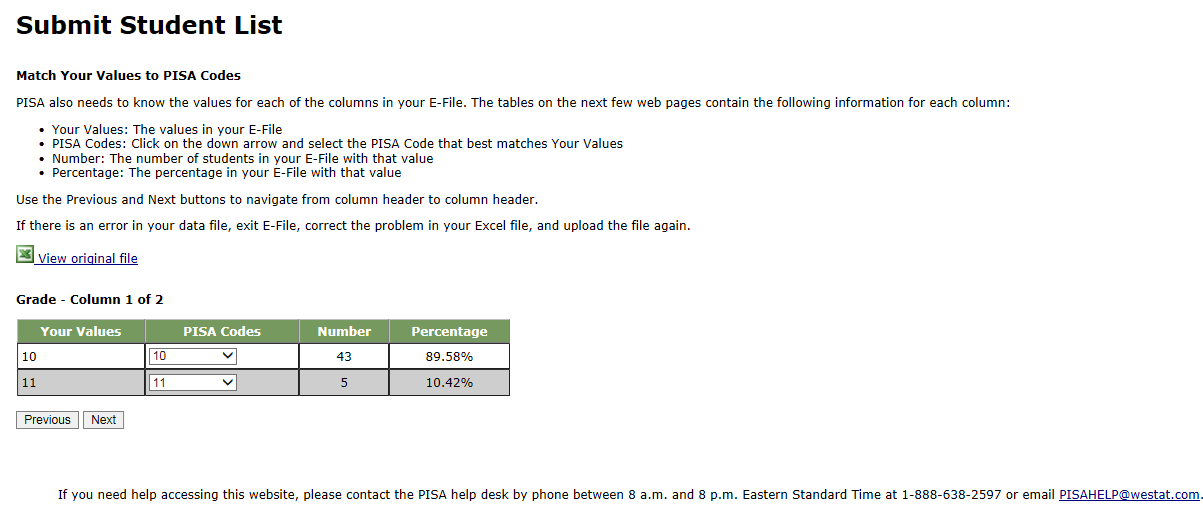
Exhibit 4. Submit Student List - Match
your Values to PISA Codes (sex mapping)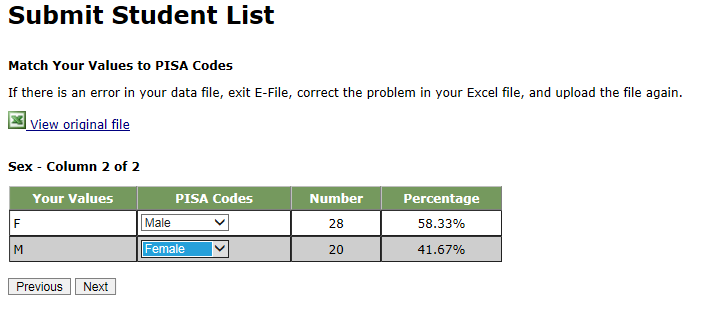
Step 4: Verify your E-file. The final step is to verify that the information is correct and submit your file. Check that the distribution of students by grade and sex match the total number of students you submitted. Indicate whether this information is correct and click “Submit.” If the information is incorrect click “Incorrect” and then click on the “Submit Student List” link on the left side of the screen. This will save your progress and exit the current e-file. You can access this file again or upload a new corrected file and start over using the same file upload process described in Step 1.
Exhibit 5. Submit Student List –Verify your E-file
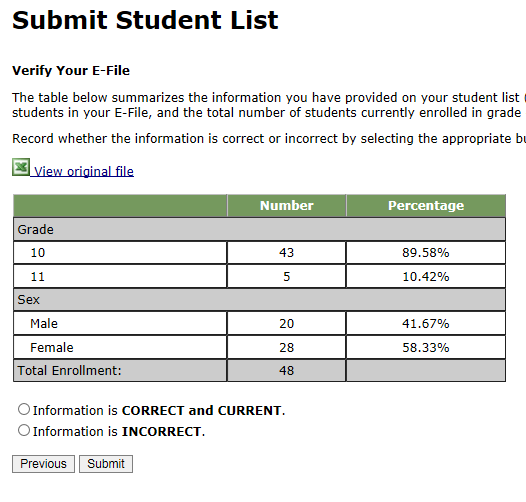
Online Student Data Checks - After you click “Submit” a number of online data validation checks are performed by our programs. These checks include checking the number of listed students against statistical estimates, making sure there is an accurate distribution of students by grade based on statistical estimates, checking that all students included are birth-year eligible (born in 2005 or 2006), and checking for any missing data. If the data fail these online checks, you will be presented with a screen that describes the issue, the location of the row(s) in your file that contains the errant data, and will need to correct the file and upload a new version. Exhibit 6 (below) provides an example of a file with missing data. Notice that the affected row is provided for each instance where the check failed. This is designed to help you efficiently locate and ameliorate any issues. Exhibit 7 provides an example of a file where ineligible students were included.
Exhibit 6. Online data checks
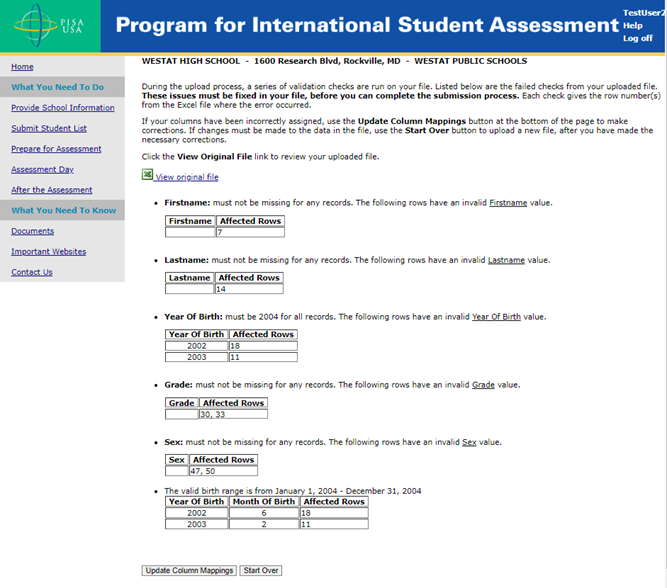

Along with the file validation checks, the total number of students is compared to the statistical estimate of eligible students. If there is a 10% or more difference in enrollment, which is typical for most every school, international standards for data collection require that we ask school coordinators for a possible reason. Typical reasons include redistricting, the schools being located within a growing or shrinking community, or near an army base. Exhibit 8 provides a screen shot of the enrollment verification check and comment box. This check does not prohibit you from completing your e-file. Simply provide a comment in the box and continue.
Exhibit 7. Online data check – enrollment verification
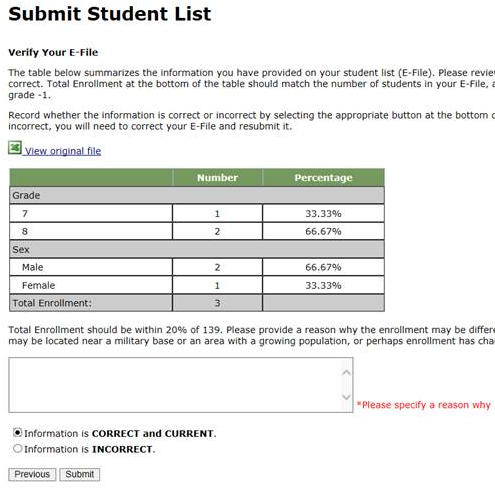
If at any time you realize that every eligible student was not listed, you can exit e-filing, correct the file, and upload a new one. If you have any questions or would like to talk with someone about e-filing, please reach out to the PISA help desk by phone between 8 a.m. and 8 p.m. Eastern Standard Time at 1-888-638-2597 or email [email protected].
PISA E-file reminder email to School Coordinator
Subject: PISA E-File Reminder
Attachment: PISA 2020 Field Test E-Filing Instructions
Dear School Coordinator:
Welcome and thank you for your efforts as the school coordinator for the Program for International Student Assessment (PISA) 2022 field test at your school!
We are nearing the deadline for your student lists to be submitted for sampling (September 17, 2021). Please upload your school’s list as soon as possible so that sampled students can be notified about the study.
Detailed instructions for submitting your list to PISA are included in the enclosed document titled PISA 2022 E-Filing Instructions.
If you have any questions about the instructions, please contact the PISA Help Desk 1-888-638-2597, or send an email to [email protected]. The e-filing instructions are also posted on the MyPISA.us website (www.mypisa.us).
Sincerely,
The PISA USA Team
The National Center for Education Statistics (NCES) is authorized to conduct the Program for International Student Assessment (PISA) by the Education Sciences Reform Act of 2002 (ESRA 2002, 20 U.S.C. §9543), and to collect students’ education records from educational agencies or institutions for the purpose of evaluating federally supported education programs under the Family Educational Rights and Privacy Act (FERPA, 34 CFR §§ 99.31(a)(3)(iii) and 99.35). The data are being collected for NCES by Westat, a U.S.-based research organization. All of the information you provide may be used only for statistical purposes and may not be disclosed, or used, in identifiable form for any other purpose except as required by law (20 U.S.C. §9573 and 6 U.S.C. §151).
Email to School Coordinator when student samples are complete and Student Tracking and School Logon Forms have been posted to MyPISA.us
Subject: PISA Student Sampling Complete
Hello!
We have processed the list of students from your school and selected a sample of students for the assessment. The following materials are now available on www.MyPISA.us:
• Student Tracking Form
• School Questionnaire Logon Form
To access the files:
1. Log into www.MyPISA.us with your username/password.
2. Click the Documents link in the "What you Need to Know" section.
3. Click on the link in the upper center of the page under "Download Your School's materials here:"
To open the files, use the password 1x2y3z45a6
Please review and update the Student Tracking Form following the steps provided in chapter 3, section 3.3 of your School Coordinator Handbook.
Please distribute the School Logon Forms.
Your PISA Test Administrator will be in contact with you to plan for the assessment. He or she can assist you in answering any questions you may have.
If you have any further questions, please feel free to call the PISA Help Desk at 1-888-638-2597, or send an email to [email protected]
Thank you again!
The PISA Team
The National Center for Education Statistics (NCES) is authorized to conduct the Program for International Student Assessment (PISA) by the Education Sciences Reform Act of 2002 (ESRA 2002, 20 U.S.C. §9543), and to collect students’ education records from educational agencies or institutions for the purpose of evaluating federally supported education programs under the Family Educational Rights and Privacy Act (FERPA, 34 CFR §§ 99.31(a)(3)(iii) and 99.35). The data are being collected for NCES by Westat, a U.S.-based research organization. All of the information you provide may be used only for statistical purposes and may not be disclosed, or used, in identifiable form for any other purpose except as required by law (20 U.S.C. §9573 and 6 U.S.C. §151).
PISA 2022 Field Test Respondent Communications
PISA 2022 Field Test– Principal Questionnaire Invitation
Dear «principal»:
The United States is participating in an important international study: the Program for International Student Assessment (PISA). PISA is the largest international assessment of education in the world, with more than 80 countries and education systems participating in each cycle. It provides comparative information on the performance of U.S. 15-year-old students in mathematics, reading, and science with 15-year-old students in other countries.
Your school is one of 50 schools across the United States that are taking part in the PISA 2022 field test. The results of the U.S. field test will help assessment developers to eliminate wording or topics that would put U.S. students at a disadvantage relative to students in other countries. The field test also ensures that data collection procedures are done efficiently and correctly. Part of the field test is an online school questionnaire that the principals of the selected schools complete. The questionnaire takes less than an hour to complete. This information, combined with responses from students, helps to provide a more complete understanding of student achievement and contexts for learning.
Use the provided link and unique account information below to complete your questionnaire.

Link: https://portal.mypisa.us/SchoolQuestionnaire
Username:840-00-99-001
Password:
1234567
PISA is conducted in the United States by the National Center for Education Statistics (NCES), within the U.S. Department of Education, and is administered by Westat, a firm in Rockville, Maryland. The U.S. Office of Management and Budget has approved the data collection under OMB #1850-0755.
If you have any questions, please do not hesitate to call 1-888-638-2597 or send an email to [email protected]
You may also get more information about this study by visiting the PISA website at http://nces.ed.gov/surveys/pisa
Thank you for your time and for supporting this important international study.
Sincerely,
The PISA USA Team
The National Center for Education Statistics (NCES) is authorized to conduct the Program for International Student Assessment (PISA) by the Education Sciences Reform Act of 2002 (ESRA 2002, 20 U.S.C. §9543), and to collect students’ education records from educational agencies or institutions for the purpose of evaluating federally supported education programs under the Family Educational Rights and Privacy Act (FERPA, 34 CFR §§ 99.31(a)(3)(iii) and 99.35). The data are being collected for NCES by Westat, a U.S.-based research organization. All of the information you provide may be used only for statistical purposes and may not be disclosed, or used, in identifiable form for any other purpose except as required by law (20 U.S.C. §9573 and 6 U.S.C. §151).
PISA Questionnaire Login Page – School
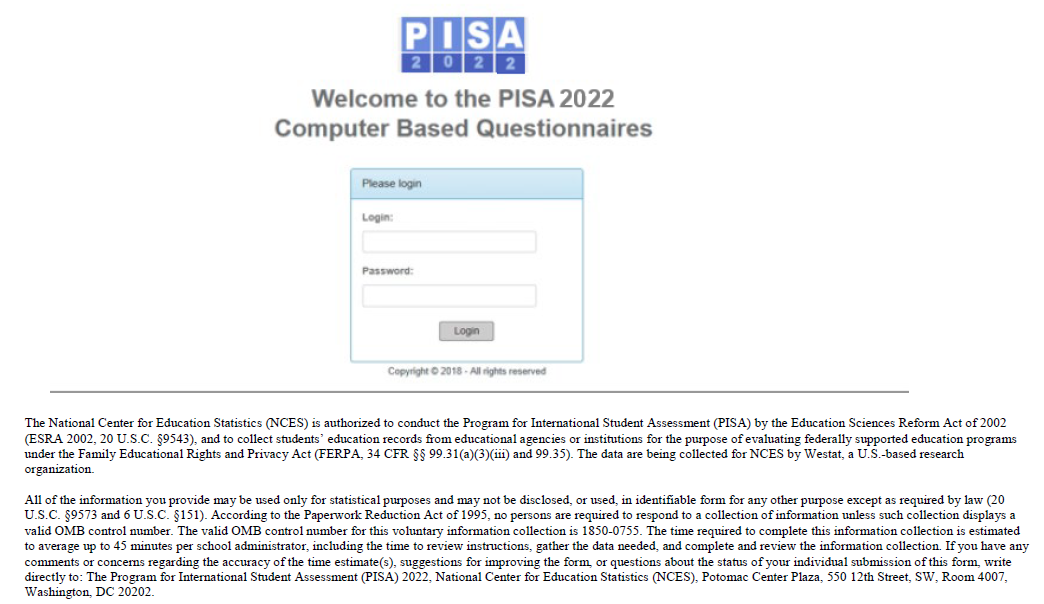
School questionnaire login page text for field test
The National Center for Education Statistics (NCES) is authorized to conduct the Program for International Student Assessment (PISA) by the Education Sciences Reform Act of 2002 (ESRA 2002, 20 U.S.C. §9543), and to collect students’ education records from educational agencies or institutions for the purpose of evaluating federally supported education programs under the Family Educational Rights and Privacy Act (FERPA, 34 CFR §§ 99.31(a)(3)(iii) and 99.35). The data are being collected for NCES by Westat, a U.S.-based research organization. All of the information you provide may be used only for statistical purposes and may not be disclosed, or used, in identifiable form for any other purpose except as required by law (20 U.S.C. §9573 and 6 U.S.C. §151). According to the Paperwork Reduction Act of 1995, no persons are required to respond to a collection of information unless such collection displays a valid OMB control number. The valid OMB control number for this voluntary information collection is 1850-0755. The time required to complete this information collection is estimated to average up to 53 minutes per school administrator, including the time to review instructions, gather the data needed, and complete and review the information collection. If you have any comments or concerns regarding the accuracy of the time estimate(s), suggestions for improving the form, or questions about the status of your individual submission of this form, write directly to: The Program for International Student Assessment (PISA) 2022, National Center for Education Statistics (NCES), Potomac Center Plaza, 550 12th Street, SW, Room 4007, Washington, DC 20202.
PISA 2022 Field Test – Principal Reminder 1
Dear Principal:
Thank you, your students, and colleagues for participating in PISA!
The data collection window is more than half-way through, and closes on October 29. We are reaching out to remind you (or a designee) to complete the school questionnaire for your school prior to October 29.
Use the provided link and unique account information below to access the questionnaire for your school.
Link: https://portal.mypisa.us/SchoolQuestionnaire
Username:«KQID»
Password:
«TEACHPWD»
PISA is conducted in the United States by the National Center for Education Statistics (NCES), within the U.S. Department of Education, and is administered by Westat, a firm in Rockville, Maryland. The U.S. Office of Management and Budget has approved the data collection under OMB #1850-0755.
If you have any questions, please do not hesitate to call 1-888-638-2597 or send an email to [email protected]
You may also get more information about this study by visiting the PISA website at http://nces.ed.gov/surveys/pisa
Thank you for your time and for supporting this important international study.
Sincerely,
The PISA USA Team
The National Center for Education Statistics (NCES) is authorized to conduct the Program for International Student Assessment (PISA) by the Education Sciences Reform Act of 2002 (ESRA 2002, 20 U.S.C. §9543), and to collect students’ education records from educational agencies or institutions for the purpose of evaluating federally supported education programs under the Family Educational Rights and Privacy Act (FERPA, 34 CFR §§ 99.31(a)(3)(iii) and 99.35). The data are being collected for NCES by Westat, a U.S.-based research organization. All of the information you provide may be used only for statistical purposes and may not be disclosed, or used, in identifiable form for any other purpose except as required by law (20 U.S.C. §9573 and 6 U.S.C. §151).
PISA 2022 Field Test– Principal Reminder 2
Dear Principal:
Thank you, your students, and colleagues for participating in PISA!
The data collection window is more than half-way through, and closes on October 29. We are reaching out to remind you (or a designee) to complete the school questionnaire for your school prior to October 29.
Use the provided link and unique account information below to access the questionnaire for your school.
Link: https://portal.mypisa.us/SchoolQuestionnaire
Username:«KQID»
Password:
«TEACHPWD»
PISA is conducted in the United States by the National Center for Education Statistics (NCES), within the U.S. Department of Education, and is administered by Westat, a firm in Rockville, Maryland. The U.S. Office of Management and Budget has approved the data collection under OMB #1850-0755.
If you have any questions, please do not hesitate to call 1-888-638-2597 or send an email to [email protected]
You may also get more information about this study by visiting the PISA website at http://nces.ed.gov/surveys/pisa
Thank you for your time and for supporting this important international study.
Sincerely,
The PISA USA Team
The National Center for Education Statistics (NCES) is authorized to conduct the Program for International Student Assessment (PISA) by the Education Sciences Reform Act of 2002 (ESRA 2002, 20 U.S.C. §9543), and to collect students’ education records from educational agencies or institutions for the purpose of evaluating federally supported education programs under the Family Educational Rights and Privacy Act (FERPA, 34 CFR §§ 99.31(a)(3)(iii) and 99.35). The data are being collected for NCES by Westat, a U.S.-based research organization. All of the information you provide may be used only for statistical purposes and may not be disclosed, or used, in identifiable form for any other purpose except as required by law (20 U.S.C. §9573 and 6 U.S.C. §151).
![]()
Student Name: |
|
School Name: |
|
Student ID: |
|
Password: |
|
Your answers will be combined with answers from other students to calculate totals and averages. The National
Center for Education Statistics (NCES) is authorized to conduct the Program for International Student Assessment
(PISA) by the Education Sciences Reform Act of 2002 (ESRA 2002, 20 U.S.C. §9543), and to collect students’
education records from educational agencies or institutions for the purpose of evaluating federally supported
education programs under the Family Educational Rights and Privacy Act (FERPA, 34 CFR §§ 99.31(a)(3)(iii) and
99.35). The data are being collected for NCES by Westat, a U.S.-based research organization. All of the information
you provide may be used only for statistical purposes and may not be disclosed, or used, in identifiable form for any
other purpose except as required by law (20 U.S.C. §9573 and 6 U.S.C. §151). According to the Paperwork
Reduction Act of 1995, no persons are required to respond to a collection of information unless such collection
displays a valid OMB control number. The valid OMB control number for this voluntary information collection is
1850-0755. The time required to complete this information collection is estimated to average up to 180 minutes per
student, including the time to review instructions. If you have any comments or concerns regarding the accuracy of
the time estimate(s), suggestions for improving the form, or questions about the status of your individual submission
of this form, write directly to: The Program for International Student Assessment (PISA) 2021, National Center for
Education Statistics (NCES), Potomac Center Plaza, 550 12th Street, SW, Room 4007, Washington, DC 20202.
OMB No. 1850-0755, Approval Expires xx/xx/2022
PISA School Coordinator Handbook Cover Letter
Welcome and thank you for your efforts as the school coordinator for Program for International Student Assessment (PISA) 2022 field test at your school. In PISA 2022, the United States will participate along with more than 80 other countries and education systems in a study that produces important international benchmarks in reading, mathematics, science, and financial literacy of 15-year-old students. Your assistance is critical to the success of the study. The results of the U.S. field test will help assessment developers to eliminate wording or topics that would put U.S. students at a disadvantage relative to students in other countries. The field test also ensures that data collection procedures are done efficiently and correctly.
If you have not already done so, the first step is to generate an electronic student list of all 15-year-old students in your school and to submit it to PISA via the MyPISA.us secure website. Detailed instructions for how to submit student lists to PISA are included in a document titled PISA 2022 Field Test E-Filing Instructions that was emailed to you. These instructions can also be found in Appendix C of the enclosed School Coordinator Handbook. If you would like that document emailed to you again, please contact the PISA Help Desk at [email protected] or by calling 1-888-638-2597. The e-filing instructions are also posted on the MyPISA.us website (www.mypisa.us).
After submitting your student list for e-filing, you will receive an email notifying you that your school’s tracking form, which list the selected students, are ready for you to download from MyPISA.us. Once downloaded, please review and update the information as necessary. The enclosed document, PISA 2022 Field Test School Coordinator Handbook, describes what you should do with each form you downloaded.
Your PISA representative will contact you in approximately 2 weeks to review the PISA materials with you, answer any questions you may have, and set up a pre-assessment visit at your school to:
* identify students with special needs who may need accommodations to be tested, or may not be able to participate in the assessment;
* identify other students listed who cannot participate (withdrawn or ineligible for other reasons);
* confirm the date, time, and location for the assessment sessions;
* meet with selected students to introduce them to PISA and motivate them to participate and do their best; and
* review parent/guardian notification.
Thank you for your time and support of this important international study. We look forward to working with you to make PISA a positive experience for your school.
Sincerely,
The PISA USA Team
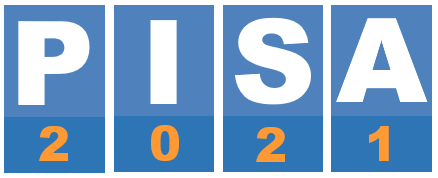

PISA 2022 FIELD TEST
SCHOOL COORDINATOR’S HANDBOOK
Produced by Westat, Core A Survey Operations in collaboration with the international contractors and the OECD
If you have any questions, please contact us at: PISA Help Desk Phone: 1-888-638-2597 Fax: 240-314-2334 Email: [email protected] For more information about PISA, visit the PISA website: http://nces.ed/gov/surveys/pisa |
1.3. Role of the School Coordinator 5
CHAPTER 02: PRELIMINARY TASKS 8
2.1. Confirm date and location for the assessment sessions 8
CHAPTER 03: BEFORE THE ASSESSMENT DAy 10
3.1. Receive and check PISA materials 10
3.2. Notify school staff, students, and parents of the assessment 10
3.3. Review and update the Student Tracking Form 11
3.5. Arrange for support staff to be present throughout each session (if possible) 21
4.1. Meet with the test administrator(s) before the assessment 24
4.2. Meet with the test administrator(s) after the assessment 24
4.3. Arrange for a makeup session, if needed 24
Appendix A: School Questionnaire Questions 26
Appendix B: E-Filing Instructions 40
Thank you for agreeing to be a school coordinator for PISA 2022 field test. As your school has been selected to represent the United States in this large scale international assessment program, you will play a very important role in making sure that the assessment is carried out smoothly and in a standard way. In doing so, you will contribute significantly to the PISA objectives of improving the quality of schooling for students in the United States. This handbook provides instructions on the tasks you will need to complete for implementing PISA in your school.
PISA stands for the Program for International Student Assessment, sponsored by the Organization for Economic Cooperation and Development (OECD). PISA has been conducted since 2000 and involves more than 80 participating countries. The PISA 2022 field test will be conducted in fall 2021.
PISA has the following characteristics:
The world’s largest international survey in education
Surveys students aged about 15 years
Assesses students’ preparedness for adult life
Measures students’ literacy in mathematics, reading, science, and financial matters
Collects context information about educational practices in participating countries
Undertaking PISA is important because the results of the assessment can be used to:
indicate how well prepared students in the United States are for learning once they leave school;
identify areas for improvement over time by schools, education systems, and governments;
allow a comparison of student performance and the learning environment between different countries/economies.
For more details about PISA, refer to the OECD website at https://www.oecd.org/pisa/.
Note on Confidentiality All of the information provided by you, other school staff, and students may be used only for statistical purposes and may not be disclosed, or used, in identifiable form for any other purpose except as required by law (20 U.S.C. §9573 and 6 U.S.C. §151). No participating individual or school will be identified in any report released by the assessment program. |
The following describes the assessment and the different types of questionnaires.
1.2.1. PISA Assessment
Up to 60 students from your school will be randomly sampled to complete a 2-hour computer-based test consisting of questions in mathematics, reading, science, and financial literacy.
1.2.2. Student Questionnaires
Students will return after a break (preferably lunch) and complete a 60-minute Student Questionnaire, which consists of:
The Student Questionnaire – examines students’ attitudes towards learning and their life experiences.
The Financial Literacy Questionnaire – covers questions about students’ experience with money matters in school and outside of school.
The Information and Communication Technology (ICT) Familiarity Questionnaire –explores students’ ICT activities and attitudes.
1.2.3. School Questionnaire
Questionnaires are an important part of PISA and provide valuable information that expands the assessment results. As school coordinator, you are tasked with overseeing the completion of the school questionnaire and monitoring the completion on www.MyPISA.us.
The School Questionnaire collects information about how education systems work within and between countries. The School Questionnaire will be completed online by the school’s head administrator using a school-specific login and password. The questionnaire takes about 53 minutes to complete.
1.3. Role of the School Coordinator
As a school coordinator, you act as the liaison between your school and the PISA test administrator. The actual assessment will be conducted by the test administrator. This section summarizes the tasks you will perform along with the key forms you will need.
1.3.1. PISA Forms
Exhibit 1.1 lists the important forms with which you should be familiar. It is critical that you fill out these forms accurately and completely so that student performance and questionnaire responses can be validly and reliably linked to student demographics.
Exhibit 1.1. Purpose of Forms
Form |
Purpose |
Completed by |
Student List (student E-File) |
To list all students at your school eligible for PISA. |
School Coordinator, submitted via MyPISA.us |
Student Tracking Form |
To indicate all students sampled from the school participating in PISA and to record demographic information about these students and student attendance for the assessment and Student Questionnaire session |
PISA home office, downloaded and updated by school coordinator and test administrator |
School Questionnaire Login Form |
To give to the head administrator to log in to the online School Questionnaire. |
PISA home office, downloaded by school coordinator |
1.3.2. Key activities for the School Coordinator
The school coordinator will assist the test administrator with preparations before and on assessment day.
PISA has provided a website, www.MyPISA.us, to facilitate the communication between your school and the study. One of the key activities as school coordinator is providing an electronic file of students (student E-File) that lists all eligible students at your school. If you have yet to submit this file, instructions for preparing and submitting the file can be found in the “Documents” section on www.MyPISA.us or see Appendix B of this handbook. Alternatively, you can send an email to [email protected] and we will be glad to send them to you directly. Once your student list has been processed and sampled, you will be notified to download your school’s PISA forms from the “Documents” section on www.MyPISA.us. PISA will provide you with the following:
The Student Tracking Form (lists the students selected for the PISA assessment). You may also use this form when notifying school staff and students of the date, time, and location of the assessment session.
Instructions for handling the School Questionnaire along with other informational materials for composing and E-Filing your student list.
It is essential that the procedures described in this manual are followed carefully to ensure that the PISA sessions are administered the same way in all participating countries/economies. Failure to do so might invalidate the results of the study.
A summary of your key activities is presented in Exhibit 1.2.
Exhibit 1.2. Key Activities for PISA School Coordinators
Stage |
Date |
Activity |
Page number |
Preliminary tasks |
3–6 weeks prior to the assessment day |
Confirm assessment date and location for the assessment session Prepare a Student list |
8 |
Before the assessment |
1–2 weeks prior to the assessment day |
Receive and check PISA materials |
10 |
|
|
Notify school staff, students, and parents about the assessment |
10 |
|
|
Review and update the Student Tracking Form |
11 |
|
1–2 weeks prior to assessment |
Organize and confirm assessment plans with school staff, students, parents, and test administrator |
20 |
|
|
Hold preassessment call with the test administrator |
20 |
|
|
Distribute School Questionnaire Login Form to appropriate person at your school |
21 |
|
A few days prior to the assessment |
Confirm School Questionnaire completion |
22 |
During and after the assessment |
Assessment day |
Meet with the test administrator(s) before the assessment |
24 |
|
|
Arrange for support staff to be present throughout each session |
24 |
|
|
Meet with the test administrator(s) after the assessment |
24 |
|
Same week as the main session (if possible) |
Arrange for a makeup session, if needed |
24 |
|
|
Store PISA forms |
24 |
If you have any questions, please contact us at: PISA Help Desk Phone: 1-888-638-2597 Fax: 240-314-2334 Email: [email protected] For more information about PISA, visit the PISA website: http://nces.ed/gov/surveys/pisa |
2.1. Confirm date and location for the assessment sessions
PISA will take place between September 20 and October 29, 2021. It is important when confirming the scheduled assessment date with the test administrator to check that there are no other events (e.g. pep rallies, college fairs, school dances) taking place at your school that could interfere with the assessment session or with the attendance of the selected students. You will then set the location and time of the assessment with the test administrator.
Exhibit 2.1 presents the assessment timings that you should consider when reserving assessment space. This includes time needed for the PISA team to set up the space before students arrive and time for packing up materials and equipment after the assessment.
It is best to schedule the session to start as early in the school day as possible to allow time to conduct the Student Questionnaire session. Occasionally, it may be necessary to conduct one or more sessions on another day.
When scheduling the assessment times and locations, you should expect to reserve the location for the assessment for 6 hours. However, if one location is not available for the full 6 hours, reserve 5 hours for the assessment and an additional 2 hours in the second location for the Student Questionnaire. This will give staff time to pack up and set up all 60 tablets in the new location.
PISA staff will bring in all computer equipment needed for the assessment. When considering an assessment location, keep the following factors in mind:
Depending on your school’s COVID-19 protocols and social distancing guidelines, it may not be possible to assess all 60 students in one location. Choose the appropriate number of locations to suit your school’s situation.
The assessment should take place in an area free of distractions and interruptions.
The space will need 2–4 working electrical outlets.
If the school is multilevel, we would request that the assessment location be assigned on the ground floor or that access to an elevator is available to facilitate moving equipment around easily.
There will need to be enough space to set up 60 tablets, although separate rooms with less than 60 spaces are okay.
If possible, we would prefer to conduct the questionnaire in the same location(s) as the assessment so that we do not have to pack up all of the computer equipment and move it to a new location.
Exhibit 2.1. Timing of Assessment
Activity |
Student Time |
Room Availability Time |
Room setup |
Not applicable |
60 minutes (approximately) |
Student logons, passwords, and introducing the assessment |
15 minutes (approximately) |
15 minutes (approximately) |
General Introduction |
15 minutes (approximately) |
15 minutes (approximately) |
First 60 minutes of assessment |
60 minutes (exactly) |
60 minutes (exactly) |
Short break |
Generally, no more than 5 minutes |
Generally, no more than 5 minutes |
Introducing Section 2 of assessment |
5 minutes (approximately) |
5 minutes (approximately) |
Second 60 minutes of assessment |
60 minutes (exactly) |
60 minutes (exactly) |
Break |
30–60 minutes (approximately) |
30–60 minutes (approximately) |
Student Questionnaire |
66 minutes (approximately) |
66 minutes (approximately) |
End the session, collection, and transfer of data |
5 minutes (approximately) |
5 minutes (approximately) |
Packing up and resetting room |
Not applicable |
30–40 minutes (approximately) |
Total |
Assessment 2 ½ hours
Student Questionnaire 1 hour (approximately)
Total time 4 hours
|
6 hours (approximately) |
CHAPTER 03: BEFORE THE ASSESSMENT DAy
3.1. Receive and check PISA materials
After your student list is submitted and sampled, you will be notified via email when you are able to download the following materials from the MyPISA website (www.MyPISA.us):
Student Tracking Form – lists each student who has been selected to participate in the assessment, including each student’s demographic information. An example of this this is shown in Exhibit 3.5.
School Questionnaire Login Form – provides the principle/designee with the information needed to access the online School Questionnaire.
The test administrator will contact you to verify that you were able to download these forms and to confirm the date and time of the preassessment call. If possible, he or she will also arrange a time for a virtual student meeting (described below).
In the shipment with this handbook, you have also received a red PISA Storage Envelope. Please use this to store all copies of the Student Tracking Form and other sensitive PISA materials.
3.2. Notify school staff, students, and parents of the assessment
Please inform school staff, students, and parents about the assessment according to the school’s policy. It is required that parents be notified of their student’s participation in the PISA assessment. The test administrator will collect a dated copy of the letter used to notify parents prior to the assessment. A sample copy of this letter is available for download from the MyPISA website (www.MyPISA.us). You should also ask participating students to bring a pencil, eraser, and calculator to the assessment and obtain extras of these items. In addition, students who finish the assessment ahead of time may bring a book or magazine to read, so you should let them know that up front.
Student meeting
Likewise, it is important to introduce the aims of PISA to school staff and students prior to the assessment to help engage students and promote their participation. If possible, the test administrator will work with you to plan a virtual meeting with the students,
During this student meeting, the test administrator will show a brief presentation that will introduce the importance of PISA as well as motivate students to participate and do their best on the assessment. The test administrator will provide Student Invitations to the assessment and Student FAQs to be distributed to the students.
Motivating students and achieving a high student participation rate are key to a successful assessment day. If fewer than 90 percent of eligible students participate on the assessment day, it may be necessary to schedule a makeup session to assess students who were absent.
If it is not possible for the test administrator to hold a virtual meeting before assessment day, another possibility is for you or a school staff member to hold the student meeting. The student presentation and instructions will be provided to you along with Student Invitations to the assessment and Student FAQs, both of which are available electronically and as hard copy.
3.3. Review and update the Student Tracking Form
Once you have been notified by email that your school’s materials are available for download from the MyPISA.us website, review and update the Student Tracking Form. The Student Tracking Form lists all sampled students along with their demographic data.
You will need to review this form and enter any missing student demographic data and correct any errors. On the day of the assessment, the test administrator will update his or her version based on your changes to the Student Tracking Form.
This section describes the steps for completing the Student Tracking Form. An example of a completed Student Tracking Form is shown in Exhibit 3.5.
3.3.1 Steps for reviewing and completing the Student Tracking Form
Step 1: Check student details and demographics
Having accurate information on this form is vital for data validity and for preparing certificates of volunteer service and student invitations. Please check to make sure that each
student’s name is spelled correctly,
student’s grade is properly listed, and
student’s month of birth (MOB) and year of birth (YOB) are correctly listed.
If you identify incorrect information, correct the information on the Student Tracking Form and relay this information to the PISA test administrator assigned to work with you.
Step 2: Identify students with special education needs (SEN)
PISA uses a coding system to identify students with special education needs (SEN). Students typically referred to as students with disabilities, or English language learners in the United States, may be categorized as SEN for PISA. The SEN column of the form is used to record the special education needs of eligible students. The codes are defined in Exhibit 3.1. Please identify any student who has a special education need by placing the appropriate code in the SEN column.
Exhibit 3.1. Codes for special education needs – SEN column
Description |
SEN Code |
Functional disability – student has a moderate to severe permanent physical disability |
1 |
Cognitive, behavioral, or emotional disability – in the opinion of qualified staff, student has a cognitive, behavioral, or emotional disability |
2 |
Limited assessment language experience – student is not a native speaker of the language of the assessment in the country and has limited proficiency in this language |
3 |
Home schooled – student is home schooled and does not attend any classes on campus |
5 |
Examples of using special education needs codes
Please refer to Exhibit 3.5 in which the following codes have been applied to the Student Tracking Form:
José Camacho is not a native English speaker and has less than 1 year of instruction in English. Therefore, he is coded as “3” in the SEN column.
Roy Edmonds is not a native speaker of English. While he has received instruction in English for more than 1 year, he still has some difficulties with English expression and requires some extra help. Therefore, he is also coded as “3” in the SEN column.
Sam Fay is blind and is coded as “1” in the SEN column.
Fred Hunt is deaf, so he is coded as “1” in the SEN column.
Lisa Jenkins has been professionally assessed as cognitively delayed and is coded as “2” in the SEN column.
For all other students who do not have any special education needs, the SEN column is left blank. For most students the SEN column will be left blank, meaning they have no special education needs.
Step 3: Identify accommodations for students who require them
If any SEN students require accommodations to be tested, record those in the ACCOM column on the Student Tracking Form. Exhibit 3.2 lists the accommodations allowed on PISA along with the three-letter accommodation code. Record the three-letter code from the table in Exhibit 3.2 in the ACCOM column on the Student Tracking Form.
Exhibit 3.2. PISA-allowed accommodations – ACCOM column
Accommodation Name and Code |
Description |
Small group (SMG) |
Generally, a small group session includes no more than five students. |
One-on-one (ONE) |
This accommodation requires that a student is assessed individually in an area free of distractions. |
Use templates (TEM)* |
A template is a cut-out used to focus a student’s attention on one part of a page by obscuring other parts of the page. |
Special equipment (EQP)* |
Any special equipment not specified above such as a lighting device or large-screen calculator. |
Preferential seating (SEA) |
This accommodation requires that a student sit in a designated area for the assessment, such as away from other students to limit distractions, a location where there is access to special equipment, or close to the front of the room so that a student can see or hear more easily. It may also include special light, furniture, or a study carrel used by the student. |
Directions in sign language (SLD)* |
This accommodation requires that a qualified sign language interpreter at the school sign the instructions included in the session script for the student. |
Auditory amplification (AUD)* |
This is an earpiece, microphone, speaker, or other amplification that allows students with auditory impairments better access to the directions read aloud to students. This would be provided in a way that does not affect or distract other students. |
Other (OTR) |
If the student requires an accommodation that is not included in either the allowed list above or the non-allowed list below, please record OTR on the Student Tracking Form. The PISA test administrator will discuss these with you during the preassessment call. |
*School staff must provide these accommodations.
As part of standard PISA procedure, all students receive the assessment directions read aloud in English and can record their answers directly in the computer. All students will also receive a calculator that can be used during the assessment. These do not need to be recorded as accommodations on the Student Tracking Form.
Accommodations that PISA cannot provide include the following:
Read aloud of the assessment items
Scribe
Extended time
Braille
Large-print assessment materials
Assessment materials in a language other than English
Bilingual dictionary
Magnification devices
Cueing to stay on task
If the student requires any of the accommodations listed above that PISA does not allow, record “NAP” (not allowed on PISA) in the ACCOM column on the Student Tracking Form and record the name of the accommodation that PISA does not allow in the Comments column.
Step 4: Identify students who CANNOT participate in PISA
Column “Test” on the Student Tracking Form is used to identify students who cannot participate in PISA. PISA is designed to be as INCLUSIVE as possible. Therefore, you should NOT use these codes if a student is unable to attend the PISA assessment, for example, due to a competing activity in/outside the school or illness, as he or she might be able to attend a makeup session.
However, some students may not be able to participate for various reasons. These reasons for non-participation must be recorded in the Test column of the Student Tracking Form, using the following specific non-participation codes in Exhibit 3.3.
Exhibit 3.3. Non-participation (N/P) Codes – Test column
Code 2 – Parent refusal A small number of parents/guardians may refuse to allow their child to participate in PISA. If you have received such notification from parents/guardians, record a code “2” for this student in column “Test.” |
Code 3 – Excluded on SEN (special educational needs) basis The guidelines in Exhibit 3.2 will assist you in deciding whether a student identified in the SEN column can be excluded from PISA. If a student with a special educational need is to be excluded from the assessment, record a code “3” for this student in column “Test.” |
Code 4 – Student now enrolled at another school If it is known that a student has transferred to another school, record a code “4” for this student in column “Test.” |
Code 5 – Student not enrolled in this school and enrolment is unknown If a student has left school, but it is not known to which school, if any, the student has transferred, record a code “5” for this student in column “Test.” |
Code 9 – Does not meet PISA criteria for eligibility If a student is enrolled in Grade 6 or lower, he or she is not eligible to participate in PISA. Record a code “9” for this student in column “Test.” If a student was NOT born between January 1, 2004 and December 31, 2004, he or she is not eligible to participate in PISA. Record a code “9” for this student in column “Test.” |
If in doubt about which code to use, leave that column blank and insert a brief note in the “Comments” column, or contact the PISA help desk.
Including Students with Special Educational Needs
Many students with special educational needs can be included in the PISA assessment without the accommodations they receive in the classroom or on high-stakes, individual tests used for grades, evaluations, or promotions. PISA is a large-scale assessment administered in a standardized way to all students. Individual scores are not reported but are aggregated across all students. Guidelines for determining inclusion or exclusion are presented in Exhibit 3.4.
Exhibit 3.4. Guidelines – Inclusion/Exclusion of Students with Special Educational Needs
Group |
Students who should be included |
Students
who may be |
Functional (physical or sensory) disability (SEN code 1)
|
The student can respond to the assessment.
Record Code 1 in column “SEN.” Leave column “Test” blank. |
The student has a moderate to severe permanent physical disability such that she or he or she cannot participate in the PISA testing situation. Record Code 1 in column “SEN.” Record Code 3 in column “Test.” |
Cognitive, behavioural, or emotional disability (SEN code 2) |
The student can respond to the assessment. He or she should NOT be excluded solely because of poor academic performance or disciplinary problems.
Record Code 2 in column “SEN.” Leave column “Test” blank. |
The student has a cognitive, behavioral, or emotional disability such that in the opinion of qualified staff, he or sheshe or he cannot participate in the PISA testing situation. This includes students who are cognitively, behaviorally, or emotionally unable to follow even the general instructions of the assessment. Record Code 2 in column “SEN.” Record Code 3 in column “Test.” |
Insufficient assessment language experience (SEN code 3)
|
The
student does not meet ALL
three criteria in the adjacent Students
who may be
Record Code 3 in column “SEN.” Leave column “Test” blank. |
The student meets ALL of the following three criteria:
Record Code 3 in column “SEN.” Record Code 3 in column “Test.” |
Home schooled (SEN 5) |
The student is home schooled and attends campus at any time. This student should be encouraged to participate.
Record Code 5 in column “SEN.” Leave column “Test” blank. |
The student is home schooled and never attends campus. Code SEN as 5, Code 9 in column “TEST”.
The student is home schooled because of cognitive or physical impairment and attends campus at any time: Code column “SEN” as 5, code 3 in column “TEST” if he/ or she cannot participate in the PISA testing situation. However, if this student does not attend campus: Code 9 in column “TEST.”. |
Examples of using non-participant codes
Please refer to Exhibit 3.5, in which the following example codes have been applied:
Jeffrey Arnette has recently transferred to another school. Therefore, he is coded as “4” in column N/P PISA.
José Camacho is coded as “3” in column SEN. He has been taught in English for less than 1 year and his teachers believe that he will not be able to participate in the assessment. Therefore, he is coded as “3” in column Test.
While Roy Edmonds’s experience with English is limited, he has been taught in English for more than 1 year and therefore does not meet the PISA criteria for exclusion on the basis of insufficient language experience. Therefore, column Test is left blank, and Roy is considered to be able to participate in the assessment.
Sam Fay is blind and is coded as “1” in column SEN. He requires a Braille version of the test to be assessed. PISA is not offered in Braille. Therefore, he is unable to participate in the assessment and is coded as “3” in column Test. Additionally, “NAP” is recorded in the ACCOM column and a note about Sam’s Braille accommodation is recorded in the Comments column.
Even though Fred Hunt is deaf, it does not affect his ability to participate. So, although he is coded as “1” in column SEN, column Test is left blank. Fred requires someone to sign the directions to him, so “SLD” is recorded in the ACCOM column, and the name of Fred’s signer is recorded in the Comments column.
The following two students are ineligible according to the PISA eligibility criteria because incorrect demographic information was recorded in the student list originally submitted for sampling. These students were subsequently sampled. The school coordinator corrected the incorrect information on the Student Tracking Form.
Tammy Ives’s birth date does not fall in the eligible range for PISA participation. She is coded as “9” in column Test.
Melissa Johnson is in grade 6 and is coded as “9” in column Test.
Lisa Jenkins has been professionally assessed as cognitively delayed and is coded as “2” in column SEN. She does not participate in other testing programs. Therefore, she will not participate in the assessment and is coded as “3” in column Test.
Students to be Assessed in PISA Only those students who do not have any one of those five codes in column “Test” can be assessed in PISA. Important! Under no circumstances may a sampled student be replaced with another student not selected. |
Exhibit 3.5. Student Tracking Form (Example After Completion)
PISA Student Tracking Form
School Name & ID |
PISA No. |
School Coordinator |
Test Administrator |
Session ID |
|||||||||
Omega High School |
23 |
Sandy Patterson |
Joseph O’Neal |
11 |
|||||||||
|
Student List |
|
|
|
|
|
|
|
Participation |
|
|||
Line No. |
Student Name |
Line No. |
Student ID |
Password |
Grade |
Gender |
Month of Birth |
Year of Birth |
SEN |
ACCOM |
Test |
StQ |
Comments |
1 |
Adams, Ted |
1 |
1999002300 |
123456789 |
10 |
2 |
12 |
2005 |
|
|
|
|
|
2 |
Arnette, Jeffrey |
2 |
1999002301 |
123456790 |
10 |
2 |
11 |
2005 |
|
|
4 |
|
|
3 |
Camacho, Jose |
3 |
1999002302 |
123456791 |
10 |
2 |
04 |
2006 |
3 |
|
3 |
|
|
4 |
Edmonds, Roy |
4 |
1999002303 |
123456792 |
10 |
2 |
09 |
2005 |
3 |
|
|
|
|
5 |
Fay, Sam |
5 |
1999002304 |
123456793 |
10 |
2 |
07 |
2005 |
1 |
NAP
|
3 |
|
Braille |
6 |
Hunt, Fred |
6 |
1999002305 |
123456794 |
10 |
2 |
09 |
2005 |
1 |
SLD
|
|
|
Ms. Smith will sign |
7 |
Ives, Tammy |
7 |
1999002306 |
123456795 |
10 |
1 |
12 |
2005 |
|
|
9 |
|
|
8 |
Jenkins, Lisa |
8 |
1999002307 |
123456796 |
10 |
1 |
08 |
2005 |
2 |
|
3 |
|
|
9 |
Johnson, Melissa |
9 |
1999002308 |
123456797 |
6 |
1 |
09 |
2005 |
|
|
9 |
|
|
10 |
Lee, Connie |
10 |
1999002309 |
123456798 |
9 |
1 |
05 |
2006 |
1 |
|
|
|
|
Codes
Codes to enter into Special Educational Needs (SEN) column: |
Codes to enter into Test column: |
Codes to enter into StQ column: |
Codes to enter in ACCOM column: |
1 – Functional disability |
1 – Participant |
1 – Participant |
SMG – Small Group |
2 – Cognitive, behavioural, or emotional disability |
2 – Parent refusal |
0 – Non-participant |
ONE – One-on-one |
3 – Limited assessment language experience |
3 – Excluded on SEN basis |
|
TEM – Uses template |
5 – Home schooled |
4 – Now enrolled at another school |
EQP – Special Equipment |
|
|
5 – Not enrolled in this school, enrolment unknown |
SEA – Preferential seating |
|
Gender Codes |
9 – Does not meet criteria for eligibility |
SLD – Directions in sign language |
|
Female=1 |
0 – Non-participant for any other reason |
AUD – Auditory amplification |
|
Male=2 |
|
OTR – Other accommodations |
|
Codes used by Test Administrator |
|
|
|
Codes used by School Coordinator |
|
|
|
Codes used by both Test Administrator and School Coordinator |
|
|
|
3.4. Organize and confirm assessment plans with school staff, students, parents, and Test Administrator
During the 2 to 3 weeks preceding the assessment, you will need to confirm these plans as follows:
confirm assessment plans with the test administrator;
confirm the date, time, and location for the assessment sessions and inform the test administrator, affected school staff, and students of any changes;
ensure that the assessment location(s) have been reserved;
ask participating students to bring a pencil, eraser, calculator, and a book or magazine to read to the assessment (PISA will provide a calculator to students who do not have one);
arrange for some books or magazines for students who finish the assessment ahead of time; and
arrange for school staff to assist during the assessment, if necessary.
Hold Preassessment call with the test administrator
The test administrator(s) assigned to your school will contact you 1 to 3 weeks before the assessment date to set up a preassessment call with you. During this call, the test administrator will meet with you to discuss the following:
the date, time, and location of the assessment sessions;
any updates you have made to the Student Tracking Form regarding student demographic information, SEN codes, and exclusions;
details about accommodations for students with special education needs;
discussion of COVID-19 mitigation protocols, including specific school requirements
notification of school staff, students, and parents, including
verifying that the parents/guardians have been notified,
distributing Student Invitations and Student FAQs to sampled students, and
informing school staff of the date and time of the assessment;
details about school protocols, including
visitors arriving and checking in at the school,
students who arrive too late to the assessment and cannot be included,
students who become ill during the assessment and other urgent situations,
students who need to use the restroom or temporarily leave the session,
emergency drills or other activities that may interrupt the assessment session, and
dismissing students after the assessment;
time to meet with the test administrator the morning of the assessment; and
time to meet after the assessment to discuss any needed makeup sessions and review how the assessment went.
Hold virtual student meeting and presentation
During this virtual visit, the test administrator will meet with the sampled students for about 20 minutes to show them a brief presentation and answer any questions. The meeting is designed to both inform and motivate students to participate and do their best. This is an important part of the PISA assessment. The test administrator will work with you to set a meeting on an available meeting platform.
3.5. Arrange for support staff to be present throughout each session (if possible)
If it is not possible for you or other school staff to be present throughout the assessment, you or they should be present at least at the beginning of the assessment session. This will help set the tone of the session and demonstrate the importance of the assessment.
School staff, however, are not permitted to administer the assessment or respond to students’ questions related to assessment or Student Questionnaire items. Only the test administrator should respond to such questions.
Because PISA materials will be used in the future, their security is very important and must be maintained at all times.
|
3.6. Distribute School Questionnaire Login Form to appropriate person and confirm completion of School Questionnaire
The School Questionnaire should be completed online by the school principal or by someone else at your school to whom he or she delegates the task. The school questionnaire provides valuable information about school policies and characteristics. It is important that these be completed in every school. To facilitate this task, the document titled Preparation for the PISA 2022 School Questionnaire in Appendix A documents 16 questions involving statistical information from your school that are asked in the School Questionnaire (e.g., counts of student enrolment, staff counts, and percentages of students eligible for the National School Lunch Program). Answers to these questions can be collected in advance by the school principal or other staff involved in filling out the School Questionnaire. As previously noted, you will be notified by email when your school materials are available for download from the MyPISA website (www.MyPISA.us). This includes the School Questionnaire Login Form. Print this form and distribute it to the principal or his or her designee. The School Questionnaire Login information will also be sent via email to the school principal or designee.
Please confirm that the School Questionnaire has been completed and if necessary, remind the appropriate person to complete the questionnaire. You can monitor completion of the questionnaire by viewing the information in the “Provide School Information” section in the MyPISA website.
4.1. Meet with the test administrator(s) before the assessment
The test administrator(s) will arrive 1 to 1 ½ hours before the assessment is scheduled to begin and will need to meet with you immediately to review assessment day logistics and the Student Tracking Form and obtain the red PISA Storage Envelope. Make sure that you have updated the Student Tracking Form before the meeting. Do not record anything in the Participation columns for students who are absent on assessment day but are eligible to participate in the assessment. The test administrator will record student attendance on the Student Tracking Form during the assessment.
After this brief meeting, escort the assessment team to the assessment location(s) so they can begin setting up. Return prior to the start of the assessment to introduce the team to the students.
4.2. Meet with the test administrator(s) after the assessment
After the assessment is completed, the test administrator will need to meet with you briefly to discuss the session. He or she will also need to make copies of the assessment forms and give these to you to store should there be any questions about the assessment or if the original documents are lost or damaged. Please keep these stored in the red PISA Storage Envelope until the end of the school year.
4.3. Arrange for a makeup session, if needed
PISA requires a high level of participation of the sampled students. The test administrator(s) will calculate the assessment rate after the assessment and inform you if a makeup session is needed.
If a makeup session needs to be arranged, please select a mutually agreed upon date and time that will maximize the number of students attending the session. It is preferred that the makeup session is held in the same week as the assessment, if possible.
Since only one makeup assessment is held, please make every attempt to ensure that absent students attend. |
After the assessment, the test administrator will give you copies of the completed forms to put in your red PISA Storage Envelope. We ask that you store this envelope securely until the end of the school year.
Your help with PISA is very important to its success in ensuring that the data collected for the United States is of the highest quality. The U.S. PISA and the International Project Team appreciate your time and effort. Thank you! |
Appendix A: School Questionnaire Support Documents
preparation for the pisa 2022 FT school questionnaire
This document contains 16 questions on the School Questionnaire that involve statistical information from your school.
Answers to these questions can be collected in advance by the school principal, or other staff involved in filling out the School Questionnaire.
The information collected in this document will then be entered into the electronic questionnaire by the principal/the person filling out the questionnaire. You will find the question number in the lower left corner of the electronic questionnaire screen.
SC016 |
About what percentage of your total funding for a typical school year comes from the following sources? |
|
|
(Please write a number on each line. Write “0” (zero) if there are none.) |
|
|
|
% |
SC016Q01TA |
Government (includes departments, local, regional, state and national) |
___________01 |
SC016Q02TA |
Tuition, student fees or school charges paid by parents or guardians |
___________01 |
SC016Q03TA |
Benefactors, donations, bequests, sponsorships, parent or guardian fundraising |
___________01 |
SC016Q04TA |
Other |
___________01 |
|
Total |
100% |
|
|
|
SC002 |
As of February 1, 2021, what was the total school enrollment (number of students)? |
|
|
(Please write a number on each line. Write “0” (zero) if there are none.) |
|
SC002Q01TA |
Number of boys: |
____________01 |
SC002Q02TA |
Number of girls: |
____________01 |
SC211 |
Approximately what percentage of students in grade 10 in your school have the following characteristics? |
|
|
(Please consider that students may fall into multiple categories.) (Please write the appropriate percentage on each line.) |
|
|
|
% |
SC211Q01JA |
Students whose native language is different from English |
____________01 |
SC211Q02JA |
Students with special learning needs |
____________01 |
SC211Q03JA |
Students from socioeconomically disadvantaged homes |
____________01 |
SC211Q04JA |
Students who are immigrants (not including refugees) |
____________01 |
SC211Q05JA |
Students who have parents who have immigrated |
____________01 |
SC211Q06JA |
Students who are refugees |
____________01 |
SC211C07JA01 |
Students who are eligible for free or reduced-price lunch through the National School Lunch Program |
____________01 |
SC018 |
How many of the following teachers are on the staff of your school? |
||
|
Include both full-time and part-time teachers. A full-time teacher is employed at least 90% of the time as a teacher for the full school year. All other teachers should be considered part-time. Regarding the qualification level, please refer only to the teacher’s highest qualification level. |
||
|
(Please write a number on each line. Write “0” (zero) if there are none.) |
||
|
|
Full-time |
Part-time |
SC018Q01TA |
Teachers in TOTAL |
__________01 |
__________02 |
SC018Q02TA |
Teachers fully certified by a relevant teaching authority |
__________01 |
__________02 |
SC018Q08JA |
Teachers with a Bachelor’s or equivalent qualification |
__________01 |
__________02 |
SC018Q09JA |
Teachers with a Master’s or equivalent qualification |
__________01 |
__________02 |
SC018Q10JA |
Teachers with a Doctoral or equivalent qualification |
__________01 |
__________02 |
SC182 |
How many of the following are on the mathematics teaching staff of your school? |
||
|
Include both full-time and part-time teachers. A full-time teacher is employed at least 90% of the time as a teacher for the full school year. All other teachers should be considered part-time. Please count only those teachers who have taught or will teach mathematics during the current school year. |
||
|
(Please write a number on each line. Write “0” (zero) if there are none.) |
||
|
|
Full-time |
Part-time |
SC182Q01WA |
Teachers of mathematics in TOTAL |
__________01 |
__________02 |
SC182Q06WA |
Teachers of mathematics fully certified by a relevant teaching certification authority |
__________01 |
__________02 |
SC182Q07JA |
Teachers of mathematics with at least a Bachelor’s or equivalent qualification |
__________01 |
__________02 |
SC182Q08JA |
Teachers of mathematics with at least a Bachelor’s or equivalent qualification in mathematics |
__________01 |
__________02 |
SC182Q09JA |
Teachers of mathematics with at least a Bachelor’s or equivalent qualification in teaching |
__________01 |
__________02 |
SC182Q10JA |
Teachers of mathematics with an Associate degree but not an Bachelor’s or equivalent qualification |
__________01 |
__________02 |
SC168 |
For each type of position listed below, please indicate the number of non-teaching staff currently working in this school. |
|
|
(Please consider that non-teaching staff may fall into multiple categories.) (Please write a number in each space provided. Write “0” (zero) if there are none.) |
|
SC168Q01JA |
Personnel for pedagogical support, irrespective of the grade levels/ages they support Including all teacher aides or other non-teaching professionals who provide instruction or support teachers in providing instruction, professional curriculum/instructional specialists, educational media specialists, psychologists and nurses |
____________01 |
SC168Q02JA |
School administrative personnel Including receptionists, secretaries, and administration assistants |
____________01 |
SC168Q03JA |
School management personnel Including principals, assistant principals, and other staff whose main activity is management |
____________01 |
SC168Q04JA |
Other non-teaching staff |
____________01 |
SC179 |
Approximately what percentage of students in your school repeated a grade at the following grade levels last academic year? |
|
|
(Please write the appropriate percentage on each line. Write “0” (zero) if nobody repeated a grade. If there were no students at one of the following grade levels in your school last academic year, please leave the row blank.) |
|
|
|
% |
SC179Q01JA |
Grades 7-9 |
____________01 |
SC179Q02JA |
Grades 10-12 |
____________01 |
SC164 |
In the last full academic year, what proportion of students in your school’s final grade left school without a diploma? |
|
(A diploma allows students to enter post-school destinations such as university, technical, further or vocational education, apprenticeships or employment.) |
|
(Please write the appropriate percentage on the line. Write “0” (zero) if no students left without such a certificate.) |
SC164Q01HA |
____________% 01 |
SC064 |
During 2019-2020 school year what proportion of students’ parents or guardians participated in the following school-related activities? |
|
|
(Please write a number on each line. If no parents participated in the activity, please write “0” (zero). Write “100” (one hundred) if all parents participated in the activity.) |
|
|
|
% |
SC064Q05WA |
Discussed their child’s behavior with a teacher on the parents’ or guardians’ own initiative |
____________01 |
SC064Q06WA |
Discussed their child’s behavior on the initiative of one of their child’s teachers |
____________01 |
SC064Q01TA |
Discussed their child’s progress with a teacher on the parents’ or guardians’ own initiative |
____________01 |
SC064Q02TA |
Discussed their child’s progress on the initiative of one of their child’s teachers |
____________01 |
SC064Q04NA |
Volunteered in physical or extra-curricular activities, (e.g. building maintenance, carpentry, gardening or yard work, school play, sports, field trip) |
____________01 |
SC064Q03TA |
Participated in local school government (e.g. parent council or school management committee) |
____________01 |
SC064Q07WA |
Assisted in fundraising for the school |
____________01 |
SC004 |
The goal of the following set of questions is to gather information about the student digital device ratio for students in grade 10 at your school. |
|
|
(Please write a number on each line. Write “0” (zero) if there are none.) |
|
|
|
Number |
SC004Q01TA |
At your school, what is the total number of students in grade 10? |
____________01 |
SC004Q02TA |
Approximately, how many desktop or laptop computers are available for these students for educational purposes? |
____________01 |
SC004Q03TA |
Approximately, how many of these desktop or laptop computers are connected to the Internet? |
____________01 |
SC004Q08JA |
Approximately, how many tablet devices (e.g. iPad®, Galaxy Book®, Fire®) or e-book readers (i.e. portable device for reading books on screen, e.g. Amazon® KindleTM, Kobo) are available for these students for educational purposes? |
____________01 |
SC004Q05NA |
Approximately, how many interactive whiteboards are available in the school altogether? |
____________01 |
SC004Q06NA |
Approximately, how many data projectors are available in the school altogether? |
____________01 |
SC004Q07NA |
Approximately, how many desktop or laptop computers with internet connection are available for teachers in your school? |
____________01 |
SC025 |
During the last three months, what percentage of teaching staff in your school has attended a program of professional development? |
|
|
A program of professional development here is a formal program designed to enhance teaching skills or pedagogical practices. It may or may not lead to a recognized qualification. The program must last for at least one day in total and have a focus on teaching and education. (Please write the appropriate percentage on each line. If none of your teachers participated in any professional development activities write “0” (zero).) |
|
|
|
% |
SC025Q01NA |
All teaching staff at your school
|
____________01 |
SC025Q02NA |
Staff who teach mathematics at your school |
____________01 |
SC175 |
How many minutes, on average, are there in a class period for grade 10 students taking the following subjects? |
|
|
(Please write the number of minutes per class period on each line.) |
|
SC175Q01JA |
Mathematics |
____________01 |
SC175Q02JA |
Average minutes in a class period across all subjects, including Mathematics |
____________01 |
SC176 |
What is the average size of mathematics classes in grade 10 in your school? |
|
|
(Please select one response.) |
|
SC176Q01JA |
15 students or fewer |
01 |
SC176Q01JA |
16-20 students |
02 |
SC176Q01JA |
21-25 students |
03 |
SC176Q01JA |
26-30 students |
04 |
SC176Q01JA |
31-35 students |
05 |
SC176Q01JA |
36-40 students |
06 |
SC176Q01JA |
41-45 students |
07 |
SC176Q01JA |
46-50 students |
08 |
SC176Q01JA |
More than 50 students |
09 |
SC003 |
What is the average size of English/Language arts classes in 10th grade in your school? |
|
|
(Please select one response.) |
|
SC003Q01TA |
15 students or fewer |
01 |
SC003Q01TA |
16-20 students |
02 |
SC003Q01TA |
21-25 students |
03 |
SC003Q01TA |
26-30 students |
04 |
SC003Q01TA |
31-35 students |
05 |
SC003Q01TA |
36-40 students |
06 |
SC003Q01TA |
41-45 students |
07 |
SC003Q01TA |
46-50 students |
08 |
SC003Q01TA |
More than 50 students |
09 |
SC174 |
How many foreign languages are being taught at your school this academic year? |
|
|
(Please write a number. Write “0” (zero) if you do not have any foreign language courses this academic year.) |
|
SC174Q01JA |
Number of foreign languages |
___________01 |
SC178 |
Thinking about students' last school report cards: Approximately what percentage of the students in grade 10 received the following types of grades in Mathematics? |
|
|
(Please write the appropriate percentage on each line. Write “0” (zero) if there are none.) |
|
|
|
% |
SC178Q01JA |
Grade C or above |
____________01 |
SC178Q02JA |
Below grade C below |
____________01 |
Appendix B: E-Filing Instructions
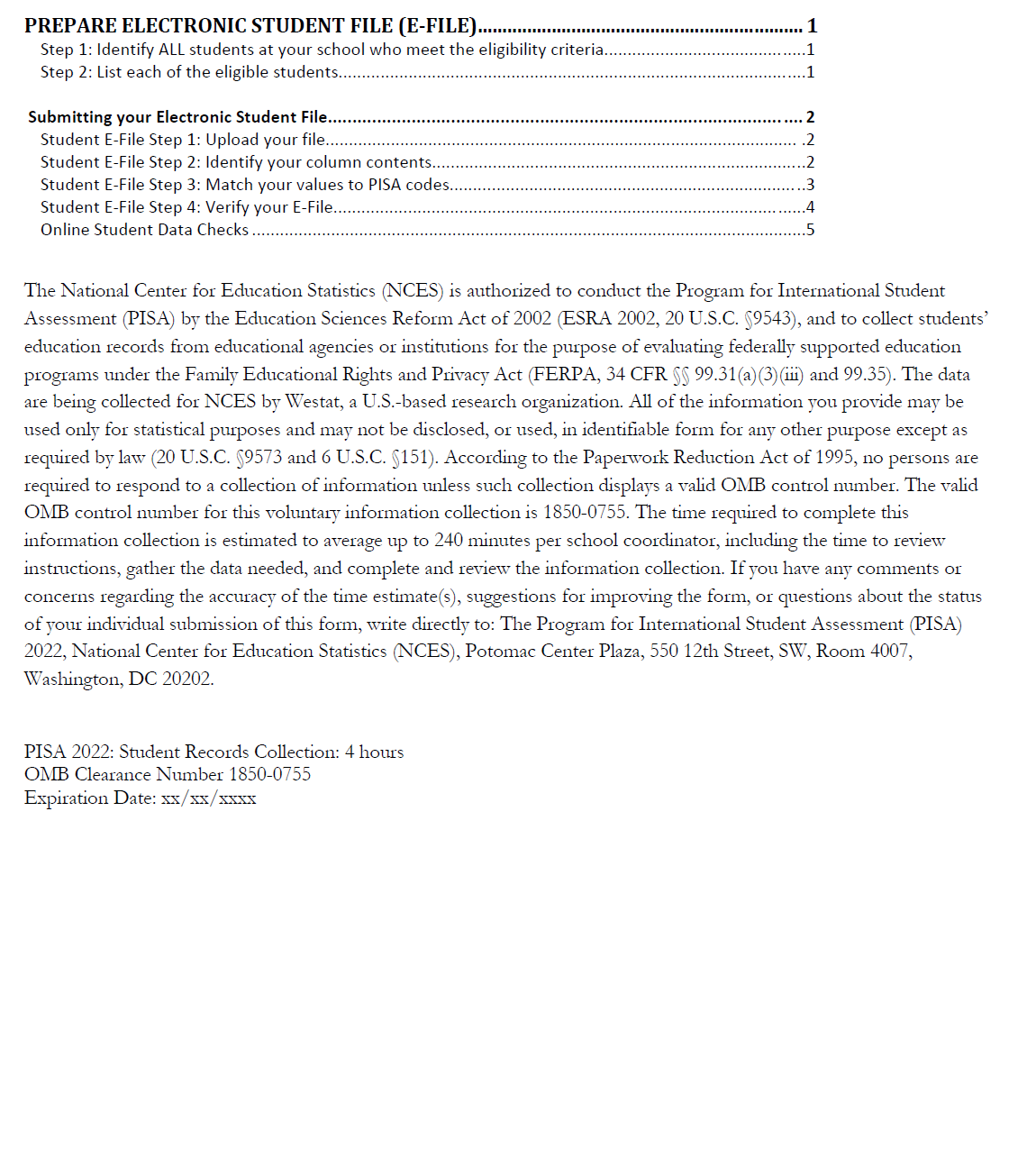
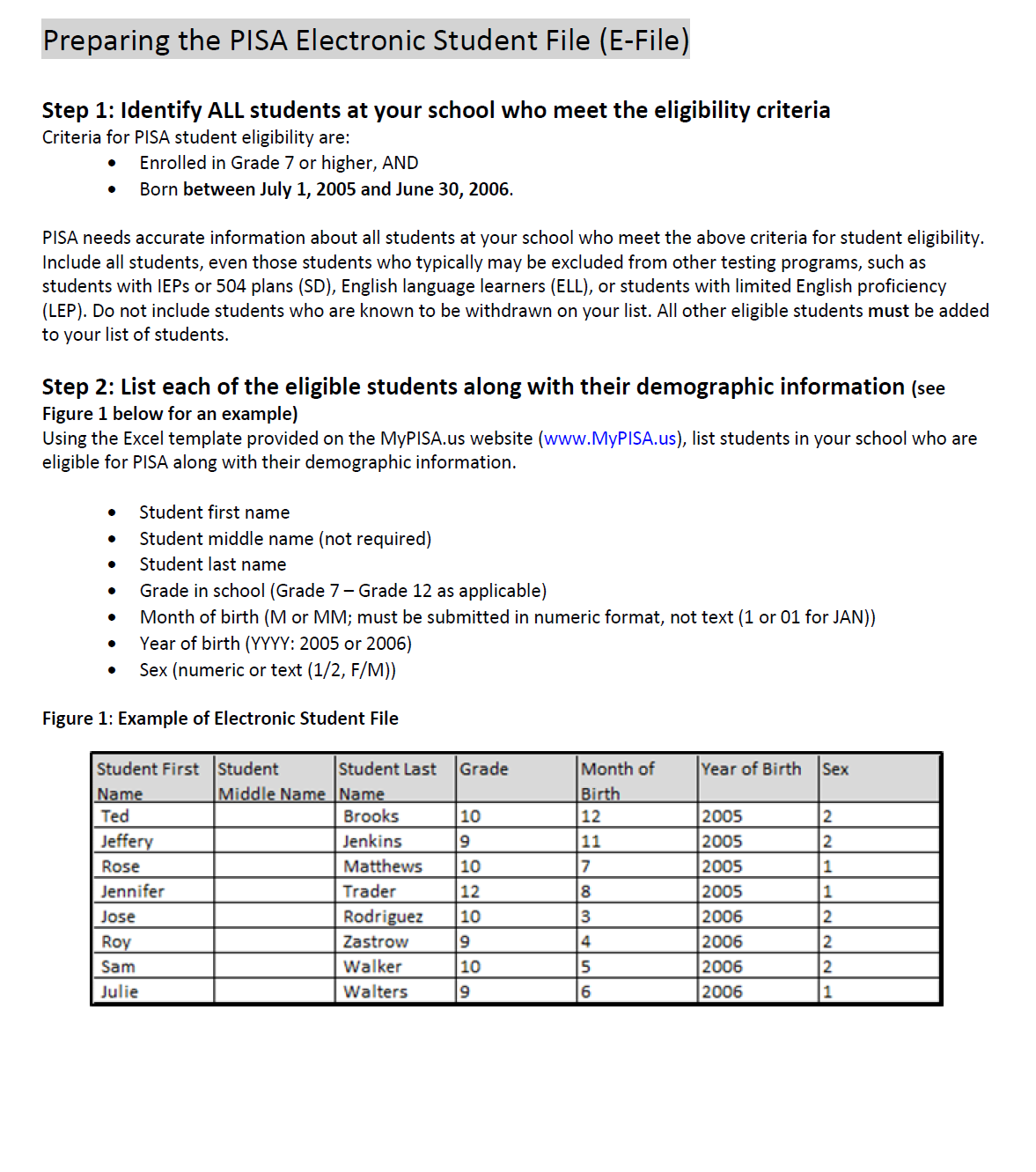
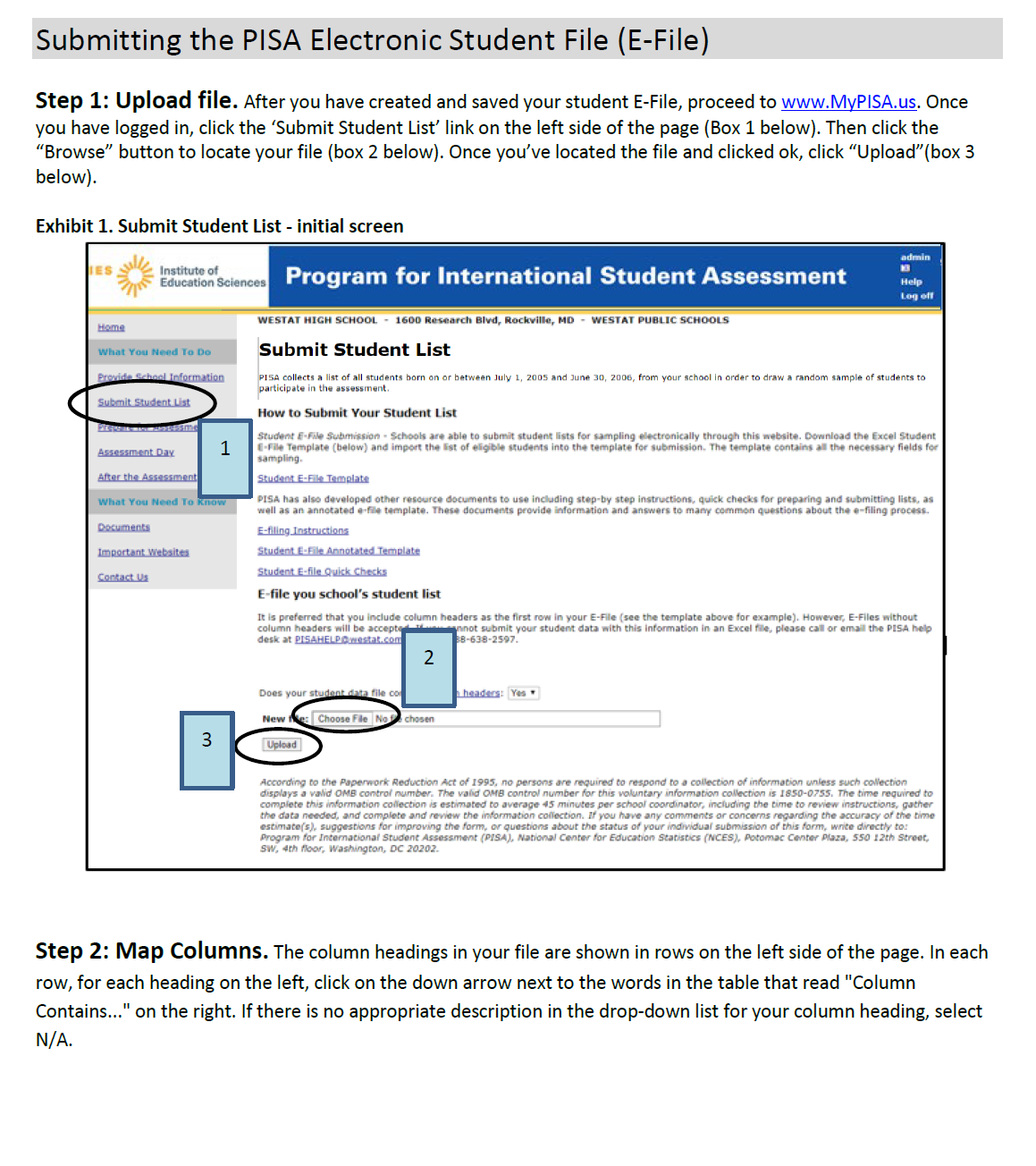
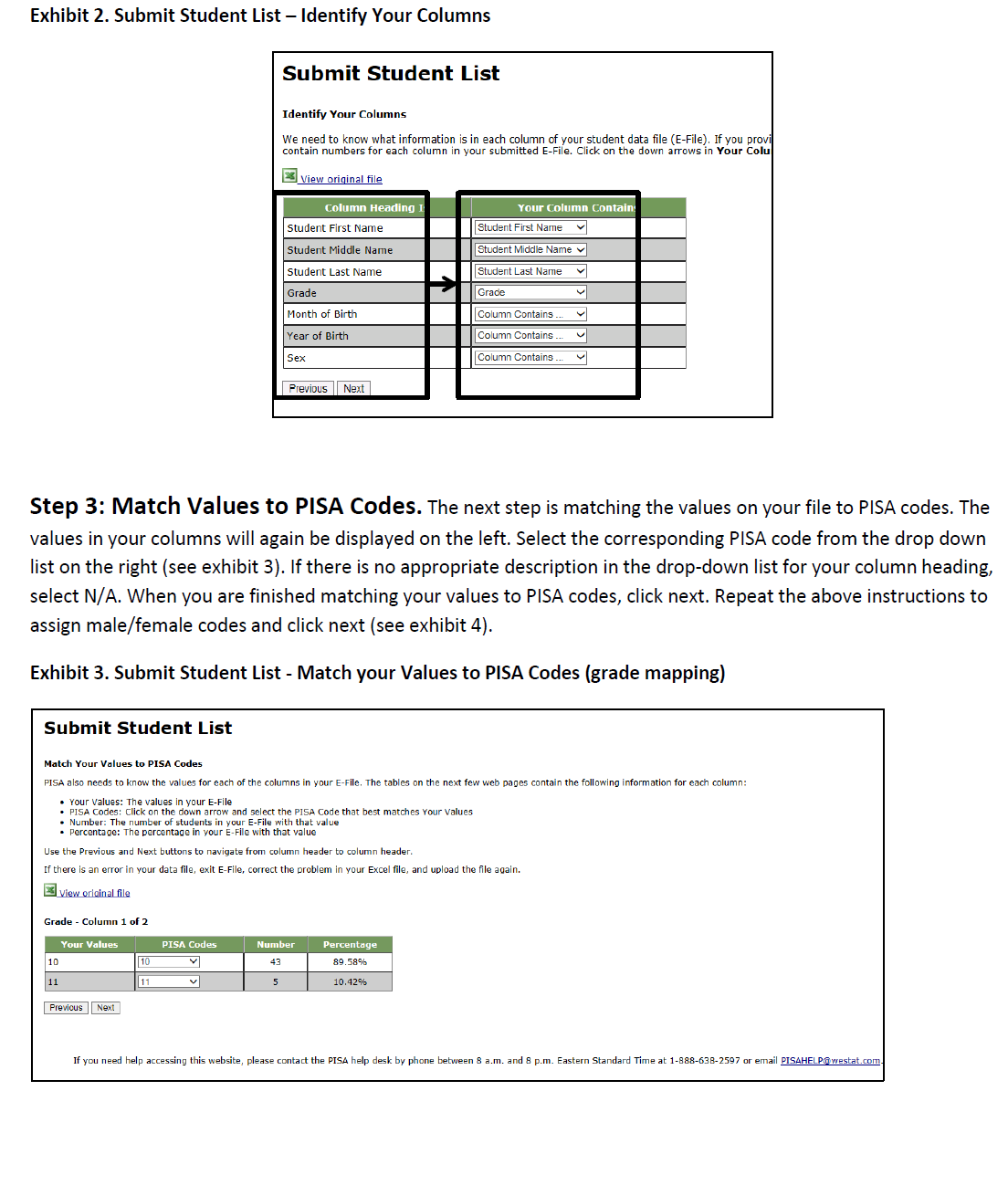
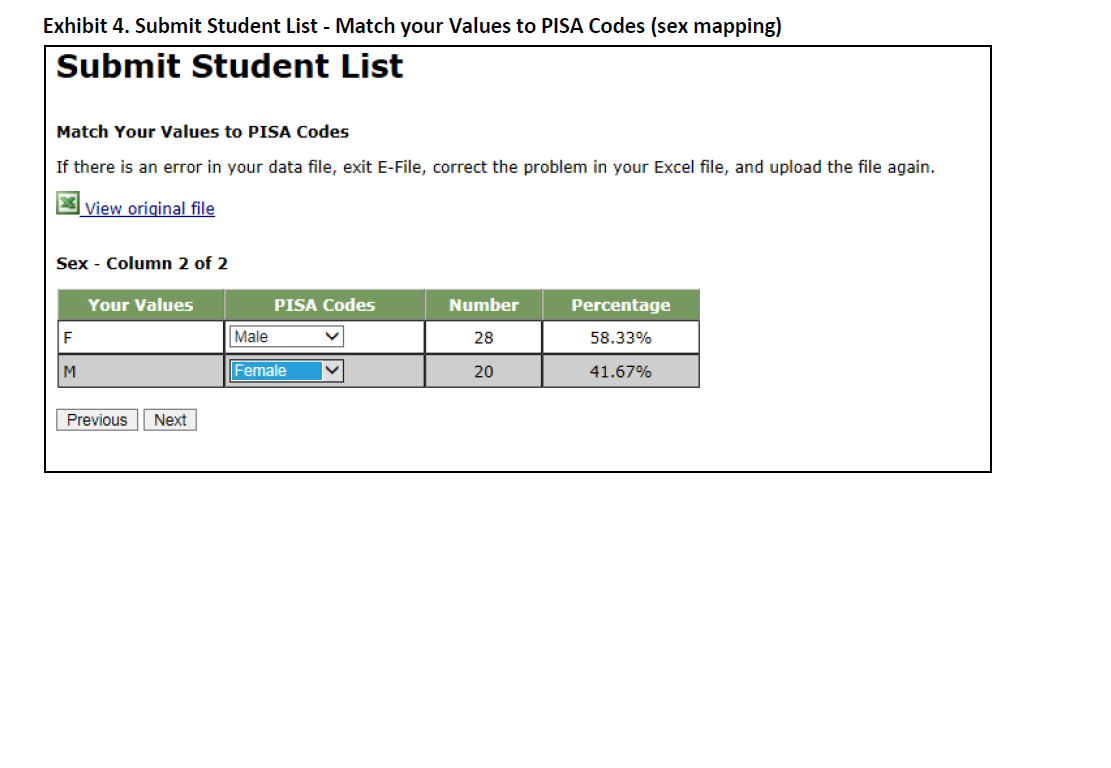
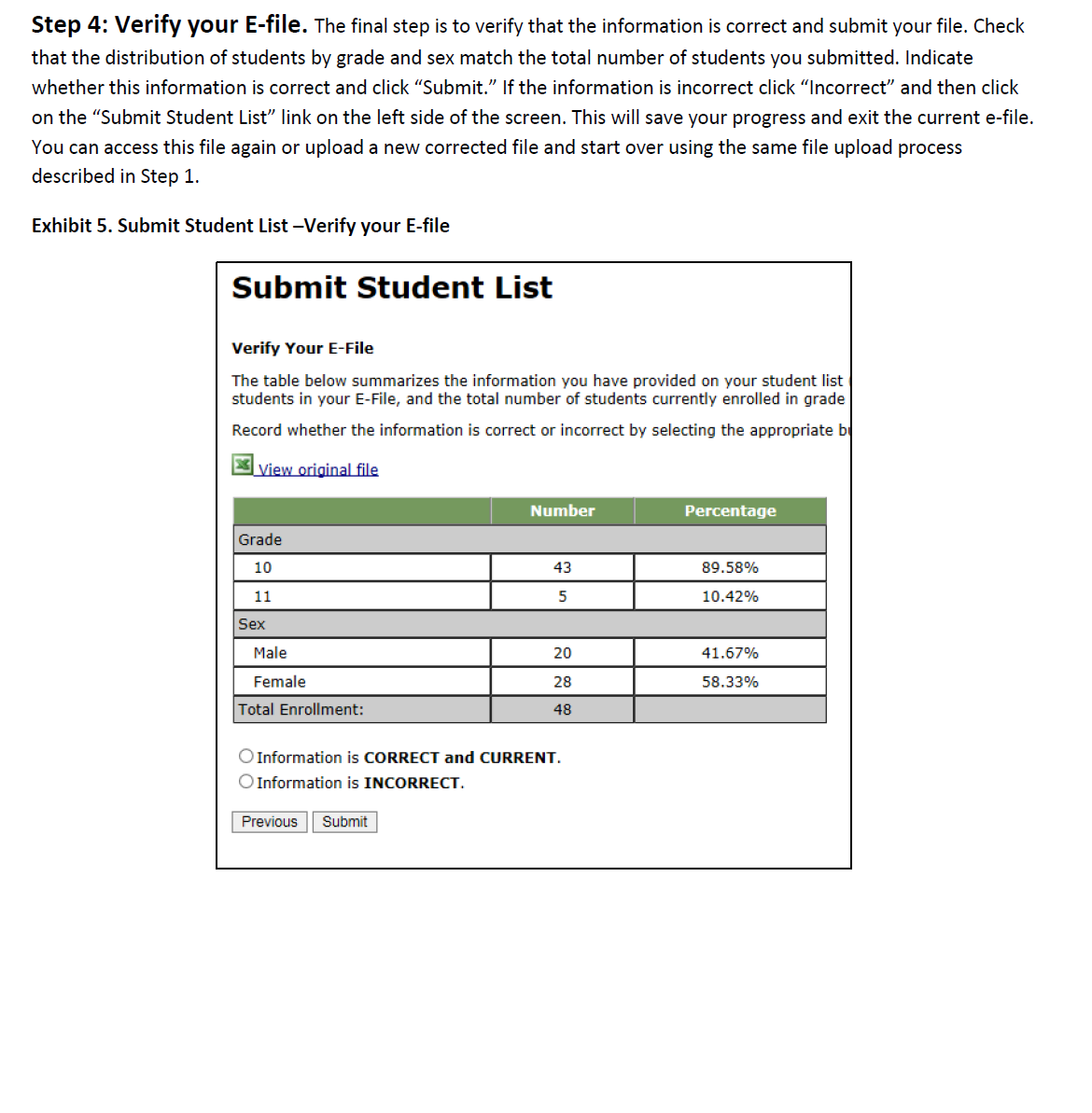
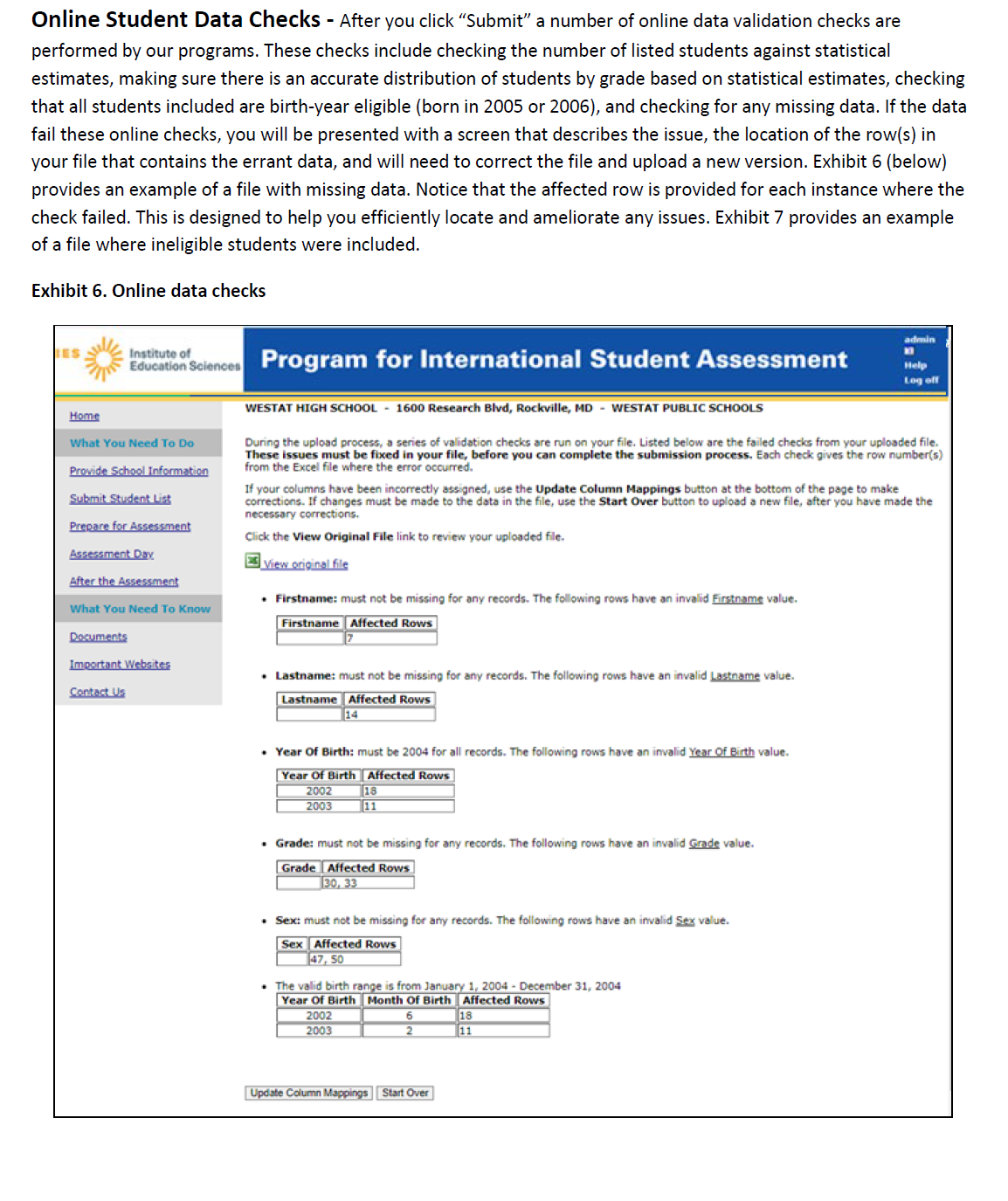
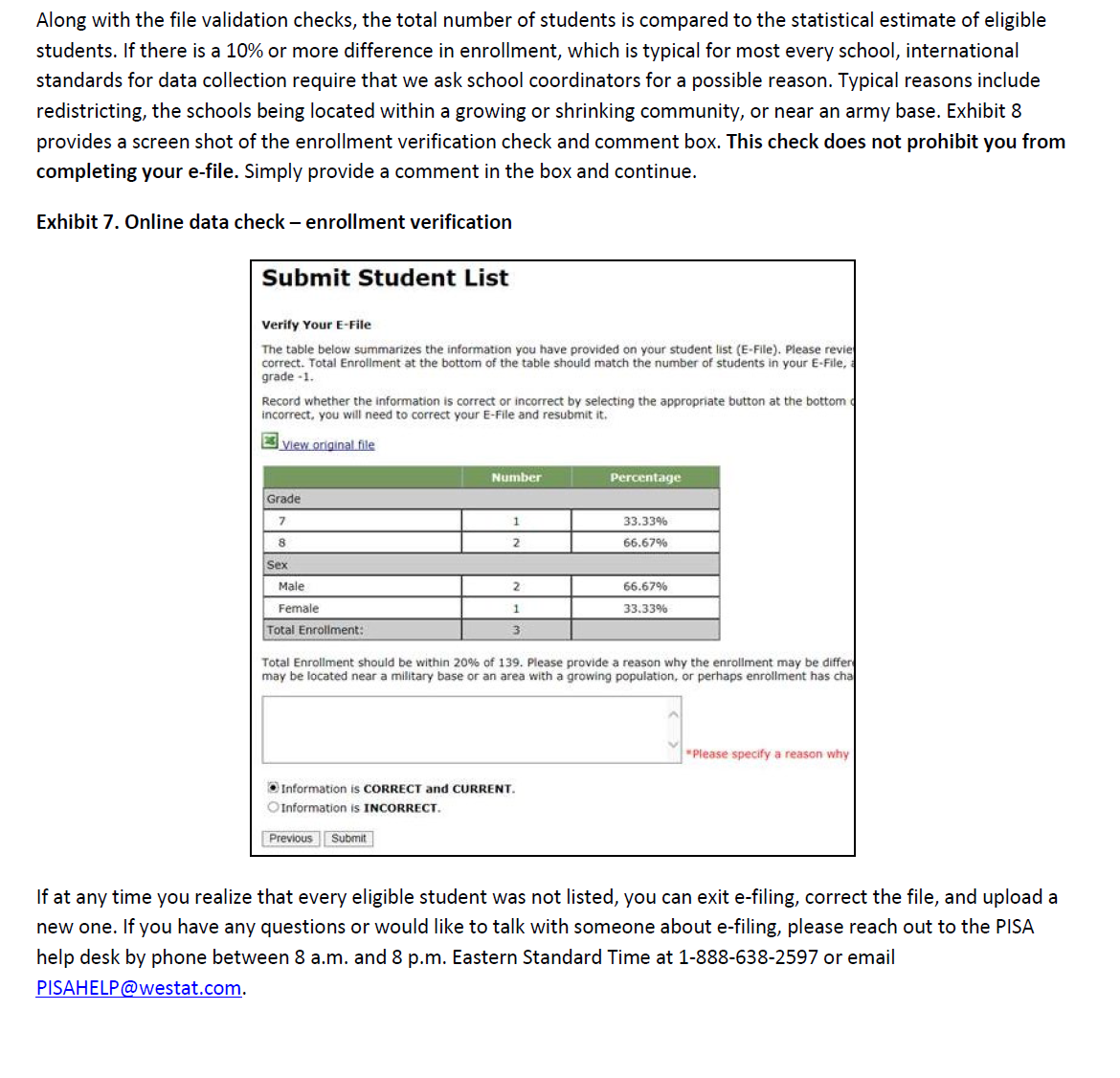
PISA project website for School Coordinators and schools
The following screenshots have been updated for the PISA 2022 field test and show the web content of MyPISA.us for schools and school coordinators with text for each screen shown below the screen.
MyPISA.us is described in Part B of the main study package.
MyPISA.us – Login page
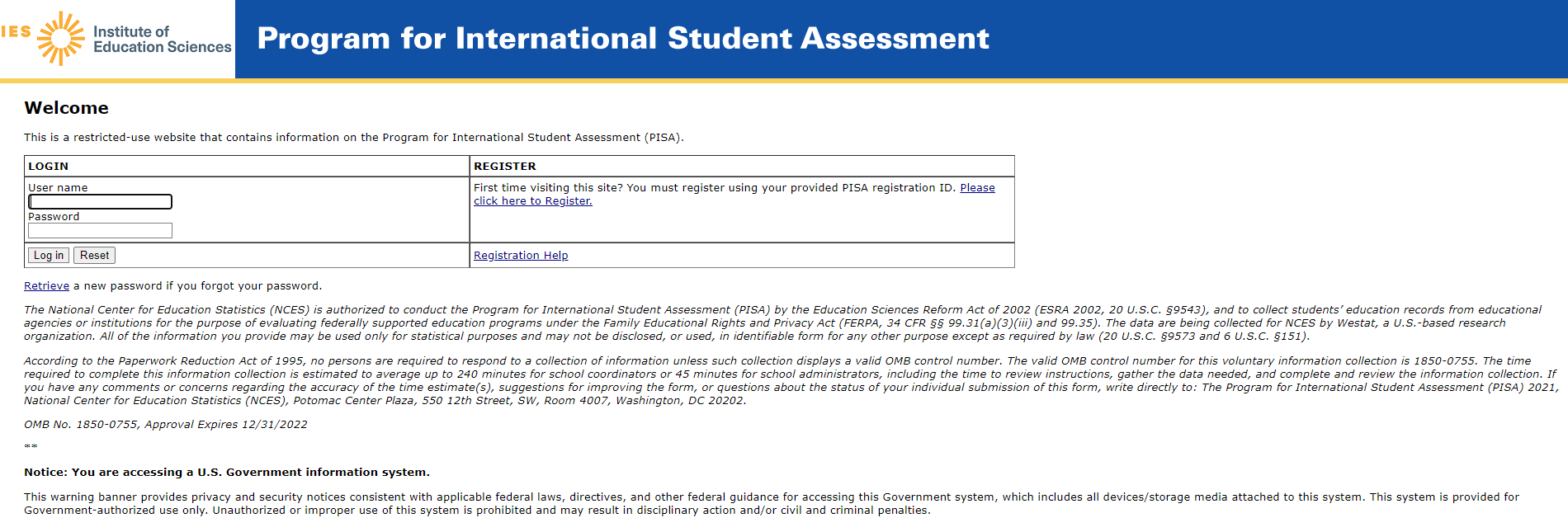
This screen is the login page for the MyPISA.us site. It provides a login function, a way for new users to register on the site using supplied credentials, and a way to retrieve a password. The text of the page as it will appear for MyPISA 2022 is shown below.
Welcome
This is a restricted-use website that contains information on the Program for International Student Assessment (PISA).

Retrieve a new password if you forgot your password.
The National Center for Education Statistics (NCES) is authorized to conduct the Program for International Student Assessment (PISA) by the Education Sciences Reform Act of 2002 (ESRA 2002, 20 U.S.C. §9543), and to collect students’ education records from educational agencies or institutions for the purpose of evaluating federally supported education programs under the Family Educational Rights and Privacy Act (FERPA, 34 CFR §§ 99.31(a)(3)(iii) and 99.35). The data are being collected for NCES by Westat, a U.S.-based research organization. All of the information you provide may be used only for statistical purposes and may not be disclosed, or used, in identifiable form for any other purpose except as required by law (20 U.S.C. §9573 and 6 U.S.C. §151).
According to the Paperwork Reduction Act of 1995, no persons are required to respond to a collection of information unless such collection displays a valid OMB control number. The valid OMB control number for this voluntary information collection is 1850-0755. The time required to complete this information collection is estimated to average up to 240 minutes for school coordinators or 53 minutes for school administrators, including the time to review instructions, gather the data needed, and complete and review the information collection. If you have any comments or concerns regarding the accuracy of the time estimate(s), suggestions for improving the form, or questions about the status of your individual submission of this form, write directly to: The Program for International Student Assessment (PISA) 2022, National Center for Education Statistics (NCES), Potomac Center Plaza, 550 12th Street, SW, Room 4007, Washington, DC 20202.
OMB No. 1850-0755, Approval Expires 12/31/2022
Notice: You are accessing a U.S. Government information system.
This
warning banner provides privacy and security notices consistent with
applicable federal laws, directives, and other federal guidance for
accessing this Government system, which includes all devices/storage
media attached to this system. This system is provided for
Government-authorized use only. Unauthorized or improper use of this
system is prohibited and may result in disciplinary action and/or
civil and criminal penalties.
If you need help accessing this website, please contact the PISA help desk by phone between 8 a.m. and 8 p.m. Eastern Standard Time at 1-888-638-2597 or email [email protected].
MyPISA.us – Home – Welcome to PISA
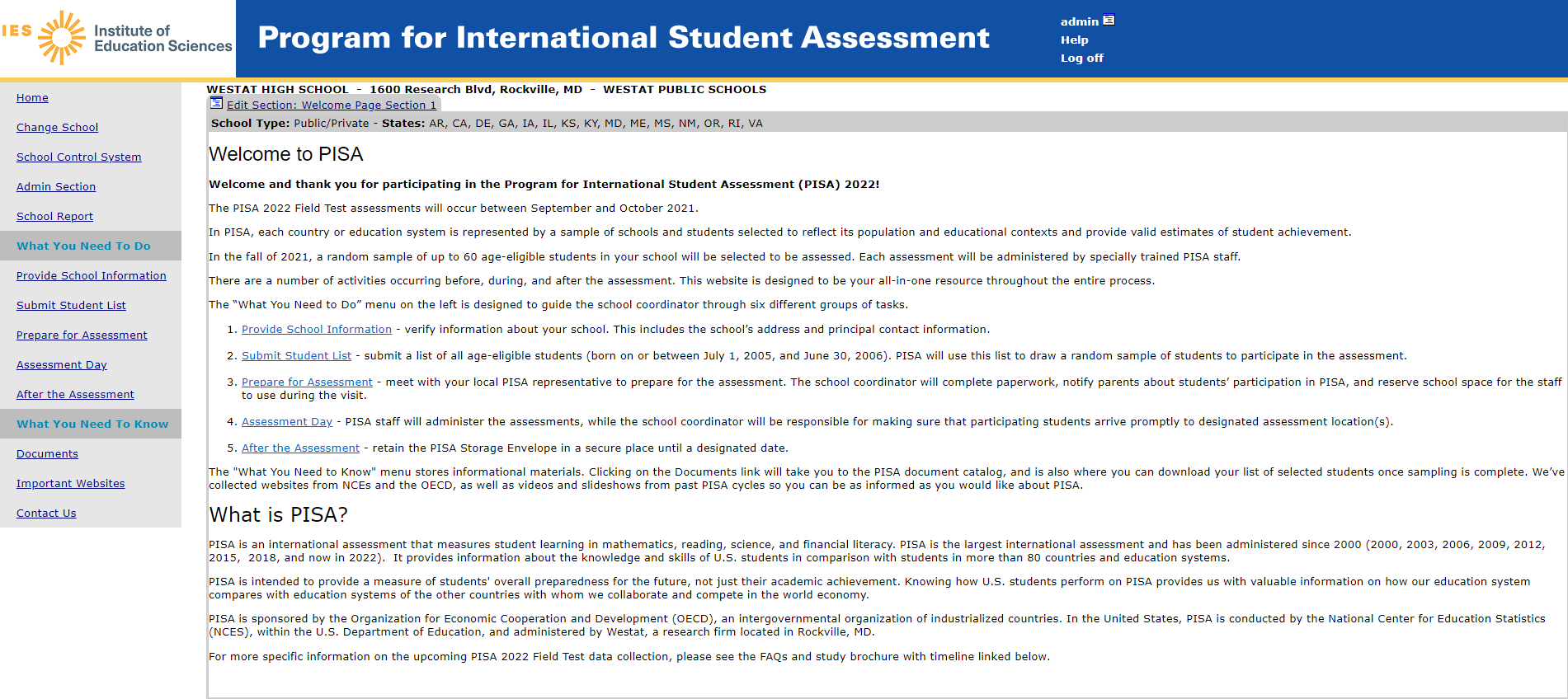
This screen is the Welcome page for the MyPISA.us site. It provides overview information about the survey and navigation to specific areas of the site. The text of the page as it will appear for MyPISA 2022 is shown on the following page.
Welcome to PISA
Welcome and thank you for participating in the Program for International Student Assessment (PISA) 2022 Field Test!
The PISA 2022 Field Test assessments will occur between September and October 2021.
In PISA, each country or education system is represented by a sample of schools and students selected to reflect its population and educational contexts and provide valid estimates of student achievement.
In the fall of 2021, a random sample of up to 60 age-eligible students in your school will be selected to be assessed. Each assessment will be administered by specially trained PISA staff.
There are a number of activities occurring before, during, and after the assessment. This website is designed to be your all-in-one resource throughout the entire process.
The “What You Need to Do” menu on the left is designed to guide the school coordinator through six different groups of tasks.
Provide School Information - verify information about your school. This includes the school’s address and principal contact information.
Submit Student List - submit a list of all age-eligible students (born on or between July 1, 2005, and June 30, 2006). PISA will use this list to draw a random sample of students to participate in the assessment.
Prepare for Assessment - meet with your local PISA representative to prepare for the assessment. The school coordinator will complete paperwork, notify parents about students’ participation in PISA, and reserve school space for the staff to use during the visit.
Assessment Day - PISA staff will administer the assessments, while the school coordinator will be responsible for making sure that participating students arrive promptly to designated assessment location(s).
After the Assessment - retain the PISA Storage Envelope in a secure place until a designated date.
The "What You Need to Know" menu stores informational materials. Clicking on the Documents link will take you to the PISA document catalog, and is also where you can download your list of selected students once sampling is complete. We’ve collected websites from NCES and the OECD, as well as videos and slideshows from past PISA cycles so you can be as informed as you would like about PISA.
What is PISA?
PISA is an international assessment that measures student learning in mathematics, reading, science, and financial literacy. PISA is the largest international assessment and has been administered since 2000 (2000, 2003, 2006, 2009, 2012, 2015, 2018, and now in 2022). It provides information about the knowledge and skills of U.S. students in comparison with students in more than 80 countries and education systems. PISA is intended to provide a measure of students' overall preparedness for the future, not just their academic achievement. Knowing how U.S. students perform on PISA provides us with valuable information on how our education system compares with education systems of the other countries with whom we collaborate and compete in the world economy.
PISA is sponsored by the Organization for Economic Cooperation and Development (OECD), an intergovernmental organization of industrialized countries. In the United States, PISA is conducted by the National Center for Education Statistics (NCES), within the U.S. Department of Education, and administered by Westat, a firm located in Rockville, MD.
For more specific information on the upcoming PISA 2022 Field Test data collection, please see the FAQs and study brochure with timeline linked below.
If you need help accessing this website, please contact the PISA help desk by phone between 8 a.m. and 8 p.m. Eastern Standard Time at 1-888-638-2597 or email [email protected].
MyPISA.us – Provide School Information


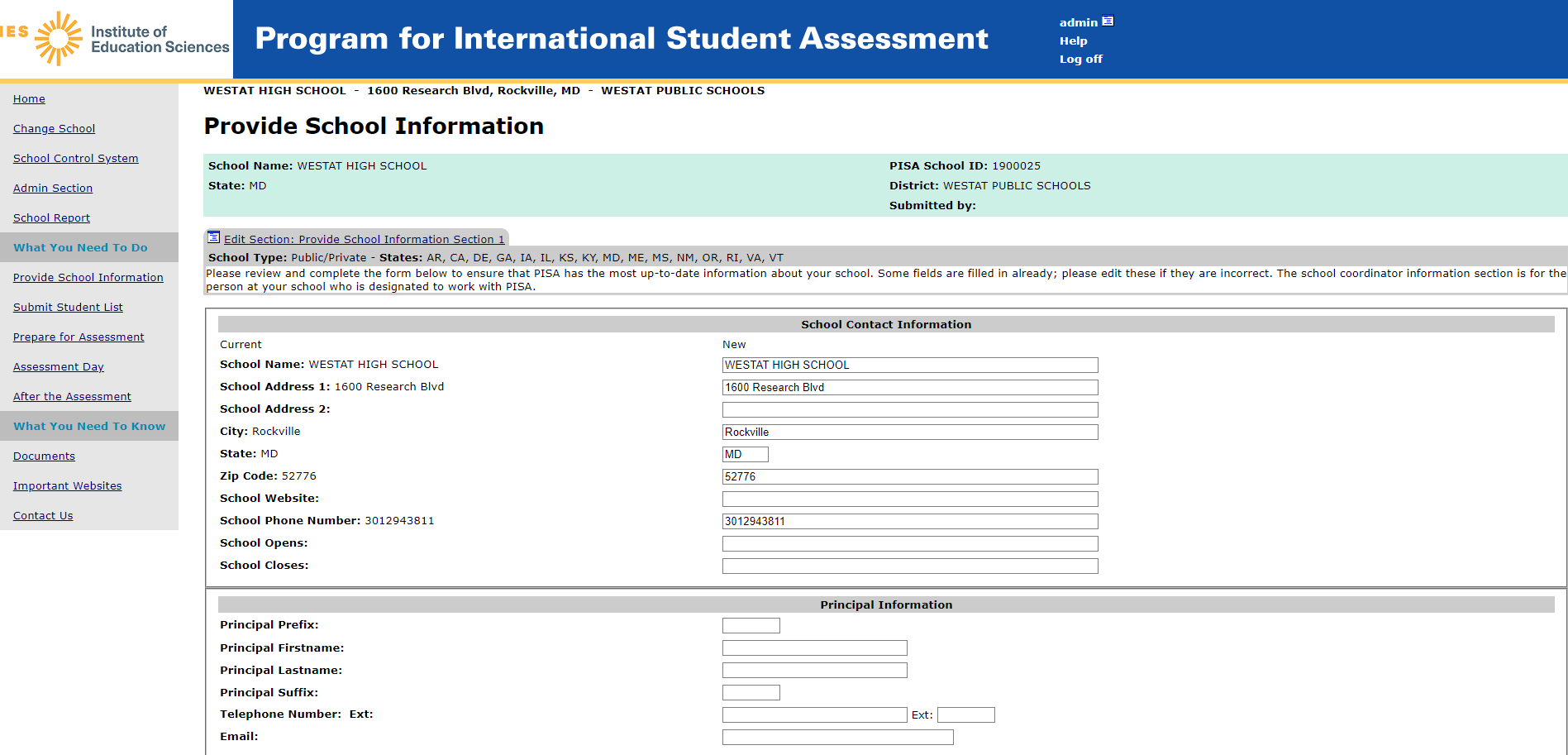
This screen provides information about the school. This information is already populated first from the sampling information and then updated by the NAEP State Coordinators or PISA Recruiters. The text of the page as it will appear for MyPISA 2022 is shown on the following page.
Provide School Information
School Name: WESTAT HIGH SCHOOL |
PISA School ID: 0500025 |
State: MD |
District: WESTAT PUBLIC SCHOOLS |
|
Submitted by: David Kastberg |
Please review and complete the form below to ensure that PISA has the most up-to-date information about your school. Some fields are filled in already; please edit these if they are incorrect. The school coordinator information section is for the person at your school who is designated to work with PISA.
![]()
School Contact Information |
|
Current |
New |
School Name: School |
|
School Address 1: Address |
|
School Address 2: |
|
City: City |
|
State: State |
|
Zip Code: 12345-6789 |
|
School Website: |
|
School Phone Number: 555-555-5555 |
|
School Opens: |
|
School Closes: |
|
Principal Information |
|
Principal Prefix: Mr. |
|
Principal Firstname: First |
|
Principal Lastname: Last |
|
Principal Suffix: |
|
Telephone Number: Ext: |
|
Email: [email protected] |
|
School Coordinator Information |
|
School Coordinator Prefix: Ms |
|
School Coordinator Firstname: First |
|
School Coordinator Lastname: Last |
|
School Coordinator Suffix: |
|
School Coordinator's Title: Coordinator |
|
Telephone: 555 555 5555 Ext: |
|
Fax: |
|
Email: [email protected] |
|
School Characteristics |
|
First Day of School (2019-2020 school year): |
|
Year Round School: |
|
Date school returns from spring break (2020): |
|
Last day of school for the year (2020): |
|
According to the Paperwork Reduction Act of 1995, no persons are required to respond to a collection of information unless such collection displays a valid OMB control number. The valid OMB control number for this voluntary information collection is 1850-0755. The time required to complete this information collection is estimated to average 15 minutes per school coordinator, including the time to review instructions, gather the data needed, and complete and review the information collection. If you have any comments or concerns regarding the accuracy of the time estimate(s), suggestions for improving the form, or questions about the status of your individual submission of this form, write directly to: Program for International Student Assessment (PISA), National Center for Education Statistics (NCES), Potomac Center Plaza, 550 12th Street, SW, 4th floor, Washington, DC 20202.
If you need help accessing this website, please contact the PISA help desk by phone between 8 a.m. and 8 p.m. Eastern Standard Time at 1-888-638-2597 or email [email protected].
MyPISA.us – Submit Student List – How to Submit Your Student List
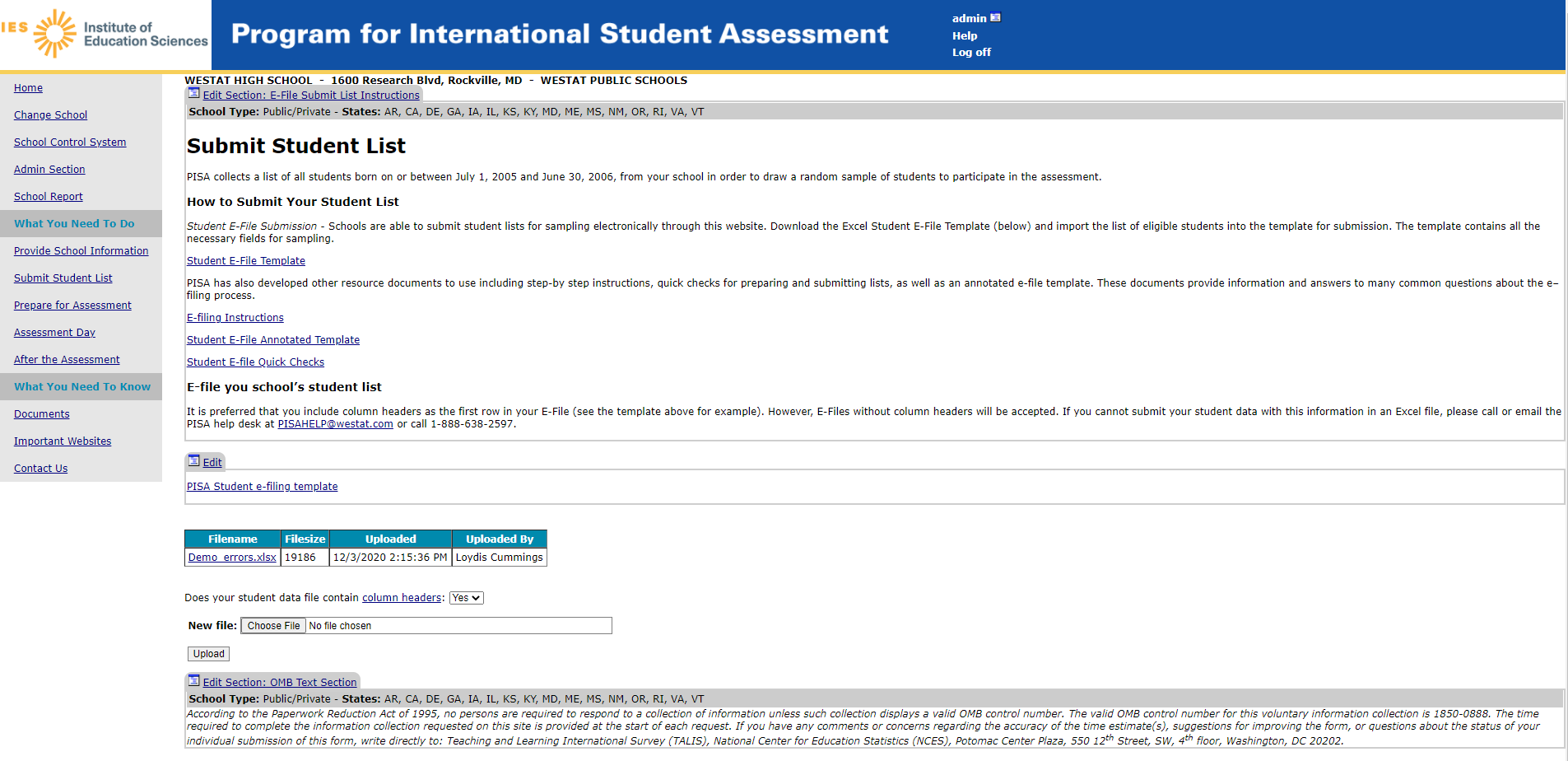
This screen provides the E-file instructions and template and is where the school coordinator will securely upload the completed student list. The birth date range will be changed to “born on or between July 1, 2005 and June 30, 2006”.
Submit Student List
PISA collects a list of all students born on or between July 1, 2005 and June 30, 2006, from your school in order to draw a random sample of students to participate in the assessment.
How to Submit Your Student List
Student E-File Submission - Schools are able to submit student lists for sampling electronically through this website. Download the Excel Student E-File Template (below) and import the list of eligible students into the template for submission. The template contains all the necessary fields for sampling.
Student E-File Template
PISA has also developed other resource documents to use including step-by step instructions, quick checks for preparing and submitting lists, as well as an annotated e-file template. These documents provide information and answers to many common questions about the e–filing process.
E-filing Instructions
Student E-File Annotated Template
Student E-file Quick Checks
E-file you school’s student list
It is preferred that you include column headers as the first row in your E-File (see the template above for example). However, E-Files without column headers will be accepted. If you cannot submit your student data with this information in an Excel file, please call or email the PISA help desk at [email protected] or call 1-888-638-2597.
The following statement will be added to the screen above to state the estimated time to complete and submit the student list.
According to the Paperwork Reduction Act of 1995, no persons are required to respond to a collection of information unless such collection displays a valid OMB control number. The valid OMB control number for this voluntary information collection is 1850-0755. The time required to complete this information collection is estimated to average 53 minutes per school coordinator, including the time to review instructions, gather the data needed, and complete and review the information collection. If you have any comments or concerns regarding the accuracy of the time estimate(s), suggestions for improving the form, or questions about the status of your individual submission of this form, write directly to: Program for International Student Assessment (PISA), National Center for Education Statistics (NCES), Potomac Center Plaza, 550 12th Street, SW, 4th floor, Washington, DC 20202.
If you need help accessing this website, please contact the PISA help desk by phone between 8 a.m. and 8 p.m. Eastern Standard Time at 1-888-638-2597 or email [email protected].
MyPISA.us – Prepare for Assessment
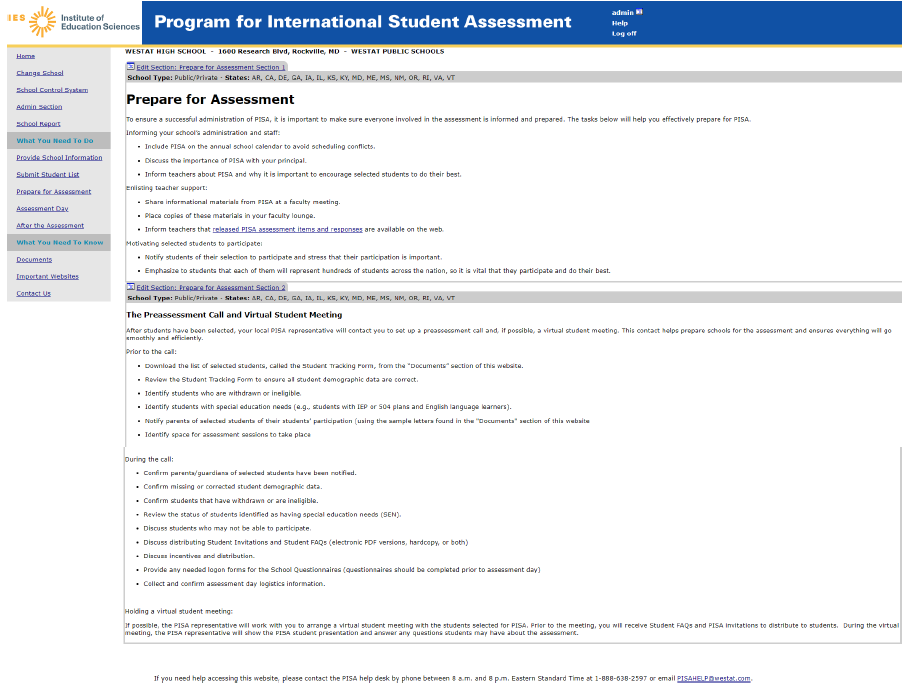
This screen provides information and suggestions for preparing for the survey including discussing the survey with school staff, and providing materials. The text of the page as it will appear for MyPISA 2022 is shown on the following page.
Prepare for Assessment
To ensure a successful administration of PISA, it is important to make sure everyone involved in the assessment is informed and prepared. The tasks below will help you effectively prepare for PISA.
Informing your school’s administration and staff:
Include PISA on the annual school calendar to avoid scheduling conflicts.
Discuss the importance of PISA with your principal.
Inform teachers about PISA and why it is important to encourage selected students to do their best.
Enlisting teacher support:
Share informational materials from PISA at a faculty meeting.
Place copies of these materials in your faculty lounge.
Inform teachers that released PISA assessment items and responses are available on the web.
Motivating selected students to participate:
Notify students of their selection to participate and stress that their participation is important.
Emphasize to students that each of them will represent hundreds of students across the nation, so it is vital that they participate and do their best.
The Preassessment Call and Virtual Student Meeting
After students have been selected, your local PISA representative will contact you to set up a preassessment call and, if possible, a virtual student meeting. This visit helps prepare schools for the assessment and ensures everything will go smoothly and efficiently.
Prior to the call:
Download the list of selected students, called the Student Tracking Form, from the “Documents” section of this website.
Review the Student Tracking Form to ensure all student demographic data are correct.
Identify students who are withdrawn or ineligible.
Identify students with special education needs (e.g., students with IEP or 504 plans and English language learners).
Notify parents of selected students of their students’ participation (using the sample letters found in the "Documents" section of this website).
Identify space for assessment sessions to take place.
During the call the PISA representative will:
Confirm parents/guardians of selected students have been notified.
Confirm missing or corrected student demographic data.
Confirm students that have withdrawn or are ineligible.
Review the status of students identified as having special education needs (SEN).
Discuss students who may not be able to participate.
Discuss distributing Student Invitations and Student FAQs (electronic PDF versions, hardcopy, or both).
.
Discuss incentives and distribution.
Provide any needed logon forms for the School Questionnaires (questionnaires should be completed prior to assessment day).
Preview the testing location(s).
Collect and confirm logistics information.
Discuss COVID-19 protocols
Holding a virtual student meeting:
If possible, the PISA representative will work with you to arrange a virtual student meeting with the students selected for PISA. Prior to the meeting, you will receive Student FAQs and PISA invitations to distribute to students. During the virtual meeting, the PISA representative will show the PISA student presentation and answer any questions students may have about the assessment.
If you need help accessing this website, please contact the PISA help desk by phone between 8 a.m. and 8 p.m. Eastern Standard Time at 1-888-638-2597 or email [email protected].
MyPISA.us –Assessment Day
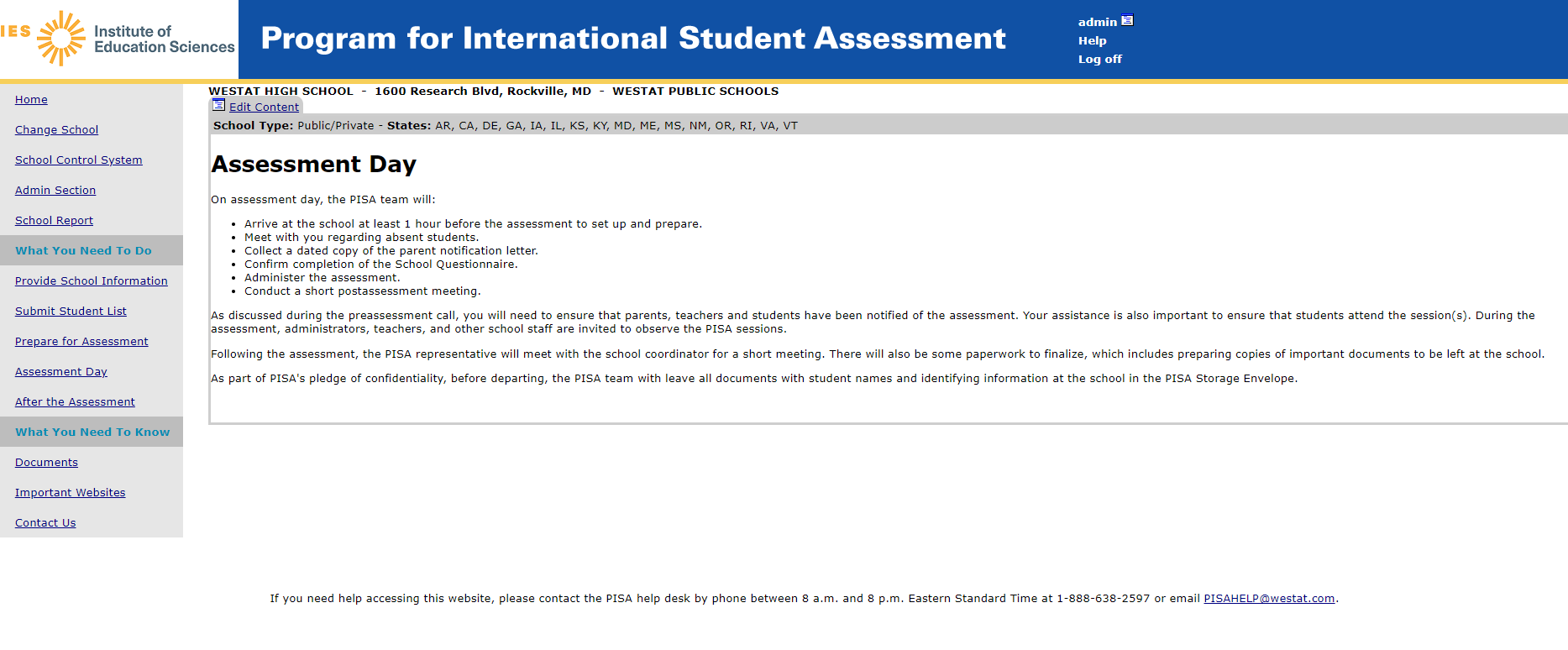
This page lists the activities of the PISA assessment team on assessment day. The text of the page as it will appear for MyPISA 2022 is shown below.
Assessment Day
On assessment day, the PISA team will:
Arrive at the school at least 1 hour before the assessment to set up and prepare.
Meet with you regarding absent students.
Collect a dated copy of the parent notification letter.
Confirm completion of School Questionnaires.
Perform confirmed COVID-19 protocols before, during and after the assessment
Administer the assessment.
Conduct a short postassessment meeting.
As discussed during the preassessment call, you will need to ensure that parents and students have been notified of the assessment. Your assistance is also important to ensure that students attend the session(s). During the assessment, administrators, teachers, and other school staff are invited to observe the PISA sessions.
Following the assessment, the PISA representative will meet with the school coordinator for a short meeting. There will also be some paperwork to finalize, which includes preparing copies of important documents to be left at the school.
As part of PISA's pledge of confidentiality, before departing, the PISA team with leave all documents with student names and identifying information at the school in the PISA Storage Envelope.
The PISA Team will practice the COVID-19 protocols as outlined in the PISA COVID-19 Protocols document and confirmed in the preassessment call, as well as any additional local protocols required by your school.
If you need help accessing this website, please contact the PISA help desk by phone between 8 a.m. and 8 p.m. Eastern Standard Time at 1-888-638-2597 or email [email protected].
MyPISA.us – After the Assessment
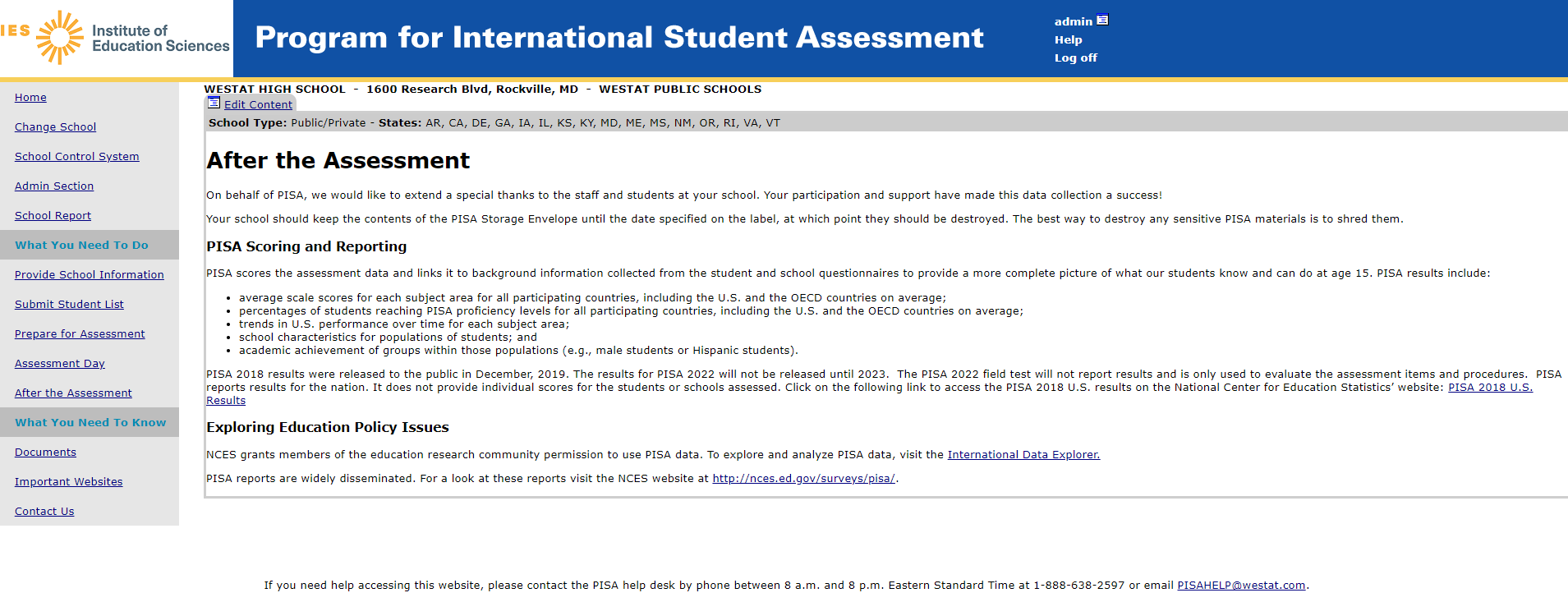
This screen provides information about post-assessment activities such as scoring of assessment data and reporting plans. The text of the page as it will appear for MyPISA 2022 is shown on the following page.
After the Assessment
On behalf of PISA, we would like to extend a special thanks to the staff and students at your school. Your participation and support have made this data collection a success!
Your school should keep the contents of the PISA Storage Envelope until the date specified on the label, at which point they should be destroyed. The best way to destroy any sensitive PISA materials is to shred them.
PISA Scoring and Reporting
PISA scores the assessment data and links it to background information collected from the student and school questionnaires to provide a more complete picture of what our students know and can do at age 15. PISA results include:
average scale scores for each subject area for all participating countries, including the U.S. and the OECD countries on average;
percentages of students reaching PISA proficiency levels for all participating countries, including the U.S. and the OECD countries on average;
trends in U.S. performance over time for each subject area;
school characteristics for populations of students; and
academic achievement of groups within those populations (e.g., male students or Hispanic students).
PISA 2018 results were released to the public in December, 2019. The results for PISA 2022 will be released in 2023. The PISA 2022 field test will not report results and is only used to evaluate the assessment items and procedures. PISA reports results are for the nation. It does not provide individual scores for the students or schools assessed. Click on the following link to access the PISA 2018 U.S. results on the National Center for Education Statistics’ website: PISA 2018 U.S. Results
Exploring Education Policy Issues
NCES grants members of the education research community permission to use PISA data. To explore and analyze PISA data, visit the International Data Explorer.
PISA reports are widely disseminated. For a look at these reports visit the NCES website at http://nces.ed.gov/surveys/pisa/.
If you need help accessing this website, please contact the PISA help desk by phone between 8 a.m. and 8 p.m. Eastern Standard Time at 1-888-638-2597 or email [email protected].
MyPISA.us – Documents
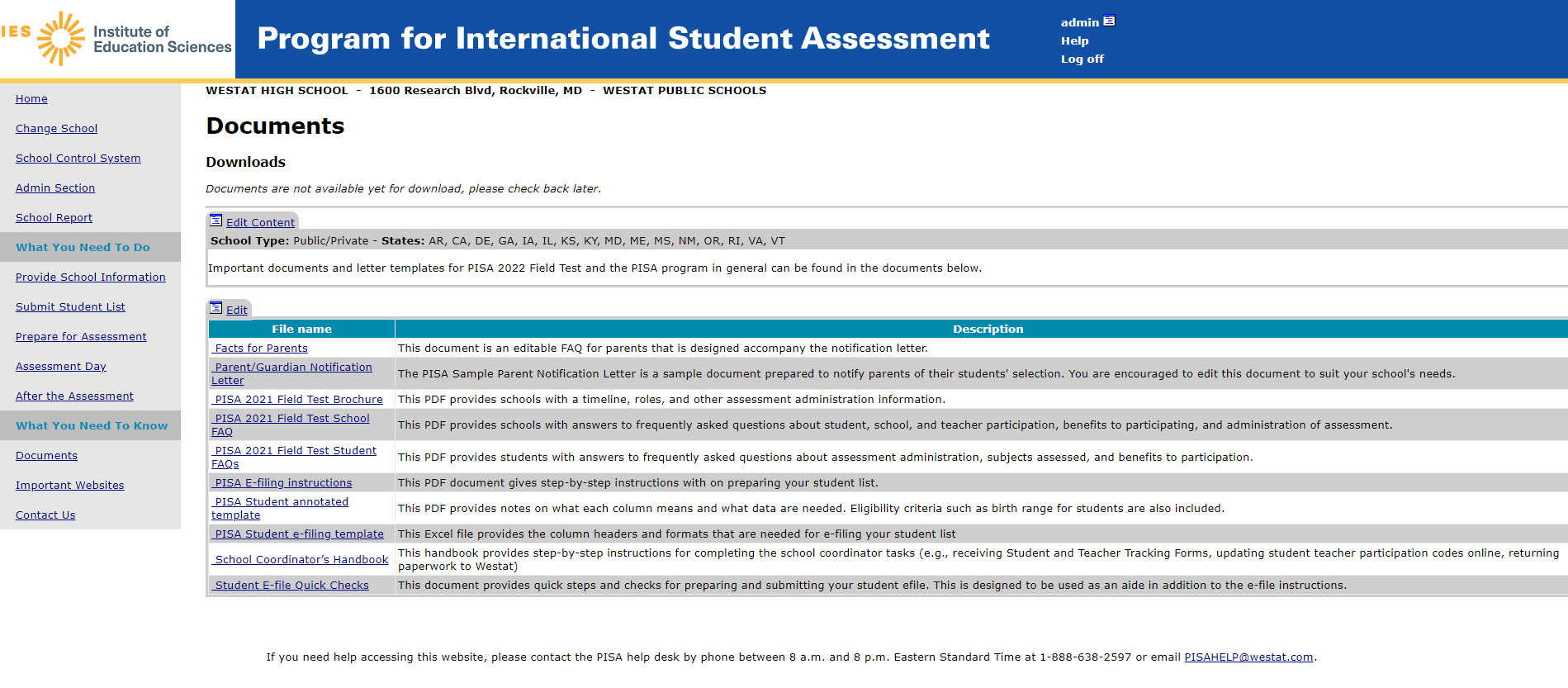
This screen provides links to documents for PISA. These documents will be updated to reference and point to PISA 2022 field test documents. The text of the page as it will appear for MyPISA 2022 is shown on the following page.
Documents
Download your school's Questionnaire Logon Forms and Student Tracking Form here: Download SC1
Download your school’s Session Attendance Forms here: Download SC2
Important documents and letter templates for the PISA 2022 Field Test and the PISA program in general can be found in the documents below.
|
If you need help accessing this website, please contact the PISA help desk by phone between 8 a.m. and 8 p.m. Eastern Standard Time at 1-888-638-2597 or email [email protected].
MyPISA.us – Important Websites
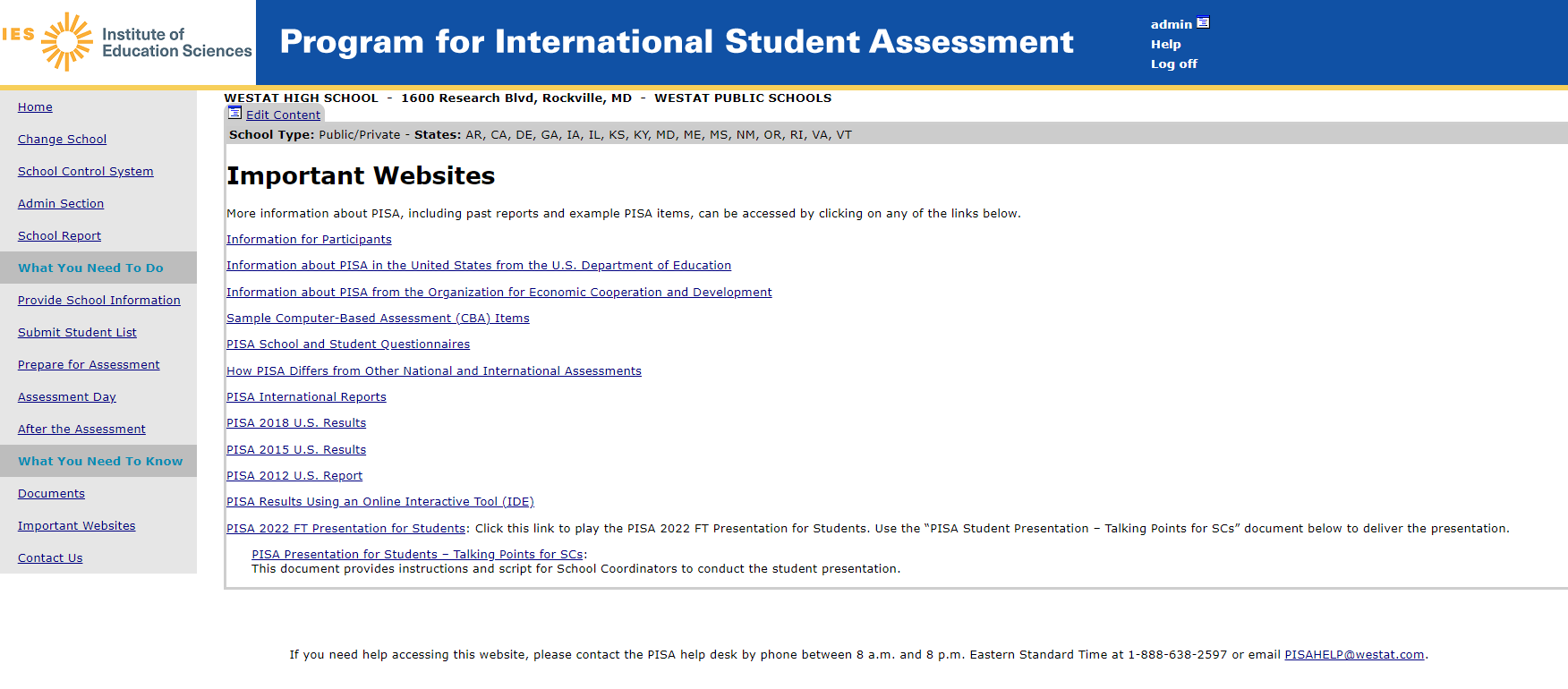
Important Websites
More information about PISA, including past reports and example PISA items, can be accessed by clicking on any of the links below.
Information about PISA in the United States from the U.S. Department of Education
Information about PISA from the Organization for Economic Cooperation and Development
Sample Computer-Based Assessment (CBA) Items
PISA School and Student Questionnaires
How PISA Differs from Other National and International Assessments
PISA Results Using an Online Interactive Tool (IDE)
Presentation for Students - PISA 2022 Field Test: Click this link to play the PISA 2022 Presentation for Students.
If you need help accessing this website, please contact the PISA help desk by phone between 8 a.m. and 8 p.m. Eastern Standard Time at 1-888-638-2597 or email [email protected].
MyPISA.us – Contact Us
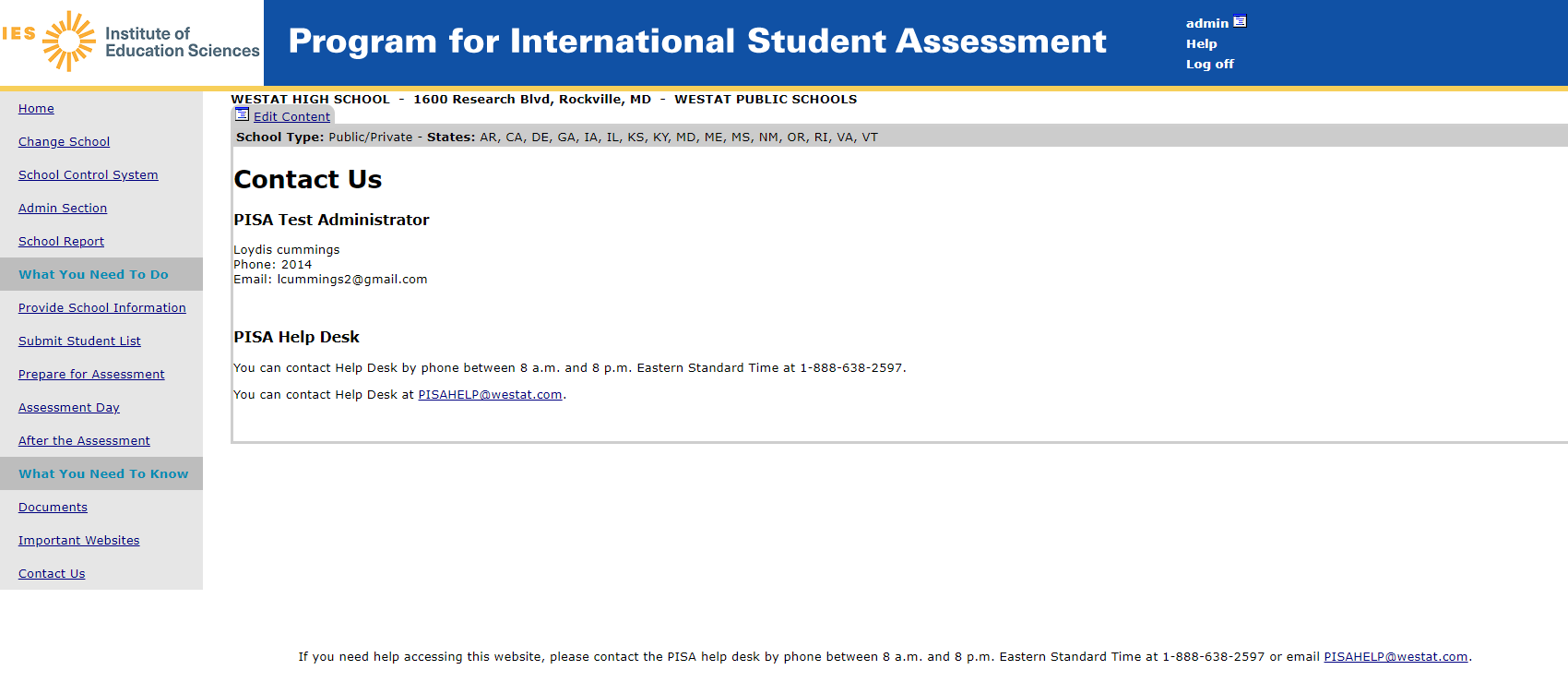
Contact Us
PISA Test Administrator
No TA designated for your account.
[This field is filled once Test Administrators are hired and assigned to work areas]
PISA Help Desk
You can contact Help Desk by phone between 8:00 am and 8:00 pm Eastern Standard Time at 1-888-638-2597.
You can contact Help Desk at [email protected].
If you need help accessing this website, please contact the PISA help desk by phone between 8 a.m. and 8 p.m. Eastern Standard Time at 1-888-638-2597 or email [email protected].
PISA 2022 Field Test Student Presentation Video
This presentation video is designed to both inform students of the details and importance of the study and to motivate them to participate and do their best. The presentation video is planned to be approximately 9 minutes in length or less. The video provides the following information:
an overview of what PISA is and its goals internationally;
describes what students need to do
demonstrations of how to work with PISA computer-based items; and
where to find more information about PISA.
The link to the PISA 2021 field test video is:
https://players.brightcove.net/1232842447001/default_default/index.html?videoId=6122652201001
This video is currently being remade to accommodate the changes in dates and also the new IES style guidelines. An updated version will be included in the next change request, in spring/summer 2021.
The final video will be 508 compliant and will include subtitles.
PISA 2022 Field Test Student Video Script
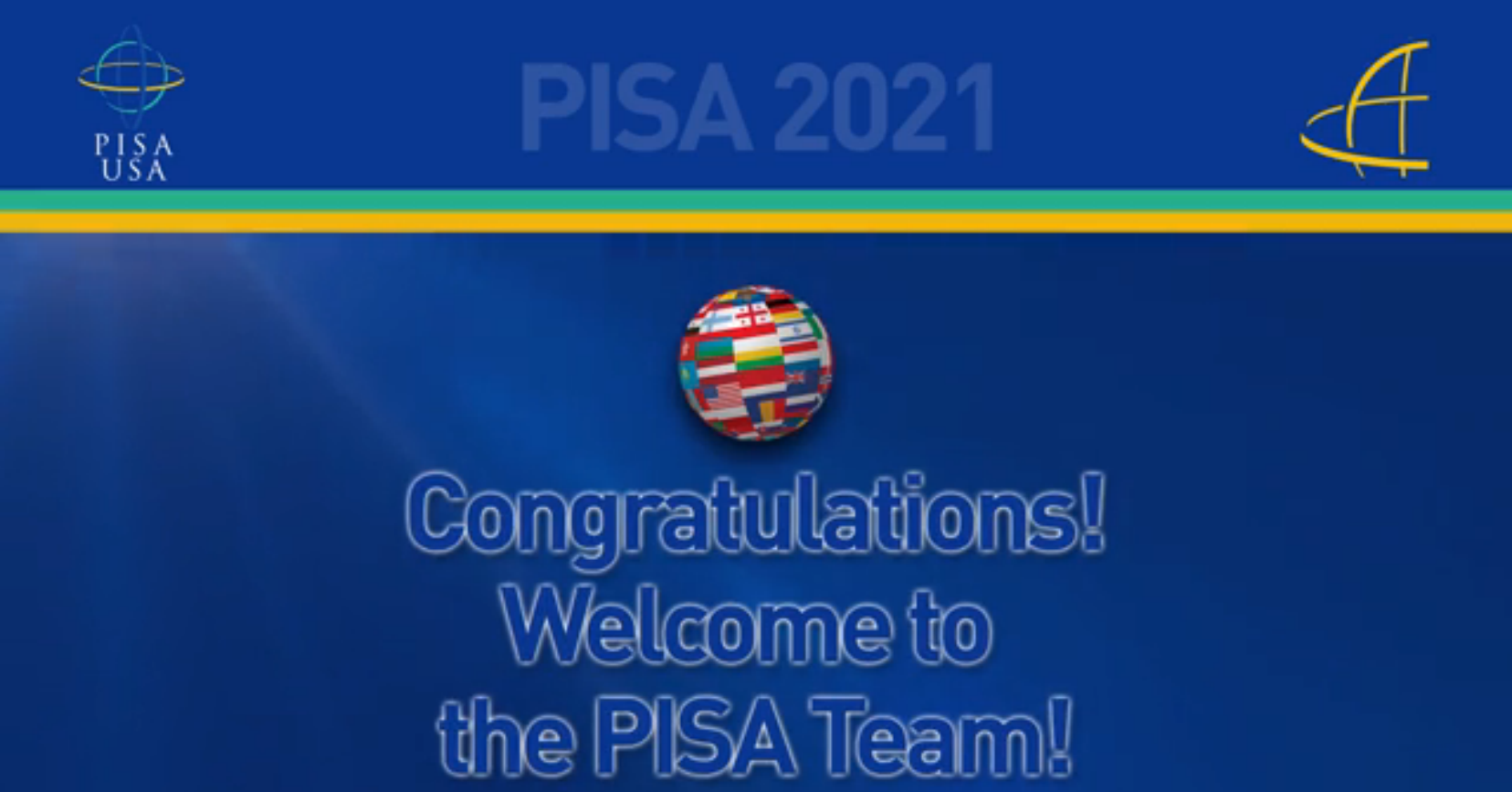
Welcome, and thank you for attending this presentation on PISA, the Program for International Student Assessment. Congratulations! You are among a select few students from across the nation that will join students from more than 80 countries and education systems around the world participating in PISA. This presentation will provide some background information and what you can expect on assessment day. To get started let’s look at a brief overview of PISA.
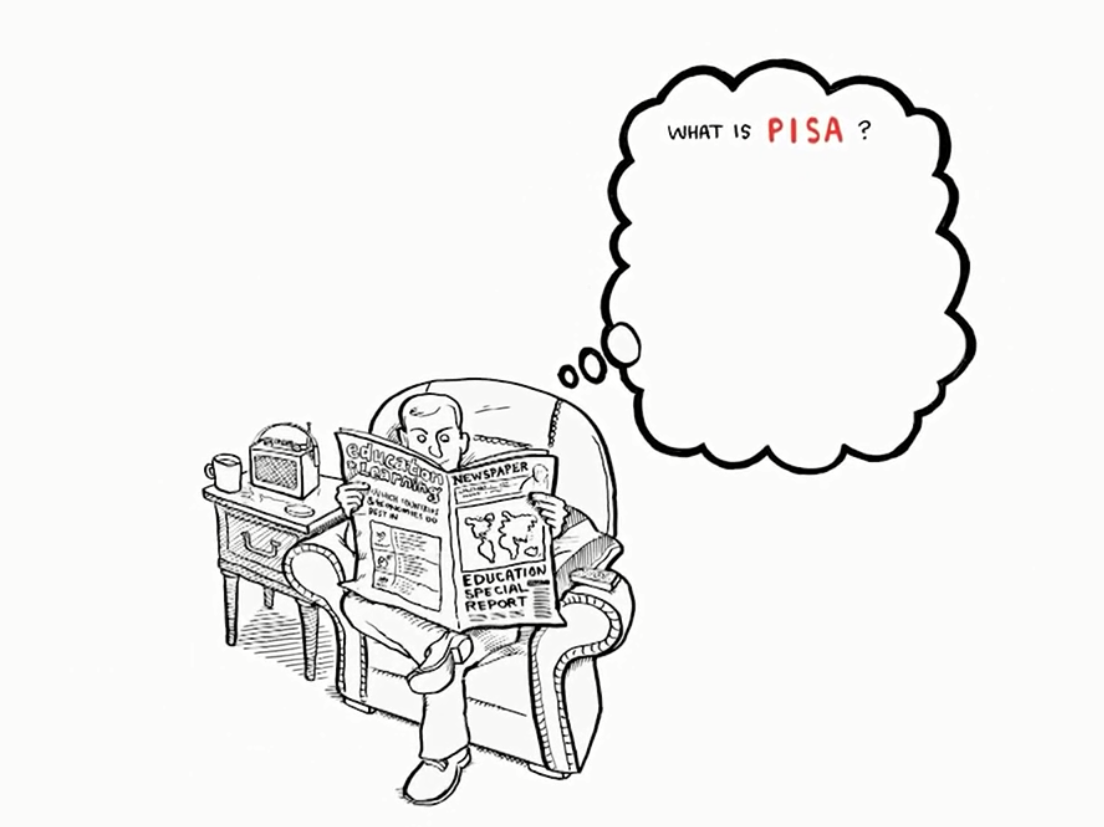
[OECD video segment:]
What is PISA? PISA is an acronym that stands for the Program for International Student Assessment. It's the brainchild of the OECD - and what's the OECD? It's another acronym that stands for the Organization for Economic Cooperation and Development. The OECD brings together 34 countries with the aim of developing better policies for better lives.
In the late-1990s, countries that are members of the OECD came up with the idea to measure whether 15 year-olds around the world are well-prepared to participate in society. We chose 15 year-olds, rather than 12 or 17 year olds, because most 15 year olds are about to complete their compulsory education.
Experts in the field of education from around the world work together to create a two-hour test that focuses on core subjects, like reading, mathematics, and science. Participating countries decided to administer this test every three years and to rotate the main focus of the test among the three core subjects.
All very well, but testing students is nothing new, so what's so special about PISA?
PISA surveys are designed to find out whether students can use what they have learned in school and apply that knowledge to real-life situations and problems. PISA is less interested in knowing whether the students can repeat - like parrots - what they have been taught in class. Rather, the survey is designed to find out whether, for example, students can use the reading skills they have learned at school to make sense of the information they find in a book, a newspaper, on a government form, or in an instruction manual.
But the point of PISA is not to tell each individual student how well he or she has mastered a set of skills. Instead, PISA results are analyzed and extrapolated to the national level.
Picture one student sitting at a desk in a classroom somewhere taking the PISA test. Now, zoom out as though you're on the space shuttle and you can see the entire country in which that student is sitting. That's what PISA does with its test results.
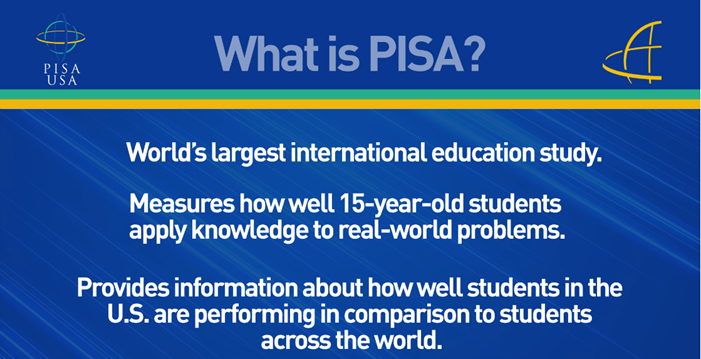
Adding on to what you just heard….
PISA is the world’s largest international education study with more than 500,000 students participating in each cycle.
It measures how well 15-year-old students apply what they’ve learned in and out of school to real-world problems in reading, science, mathematics, and financial literacy.
PISA provides information about how well students in the United States are performing in comparison to students in countries around the world.
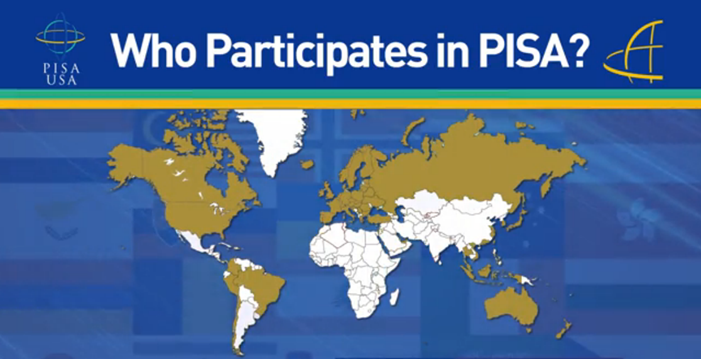
So, which countries participate in the largest international education study in the world?
To understand how far-reaching PISA is, let’s take a look at this map.
You can think of PISA as an Olympics of the mind. Countries and education systems from every continent, except Antarctica, participate in PISA – in total more than 80 countries and education systems participate in PISA.
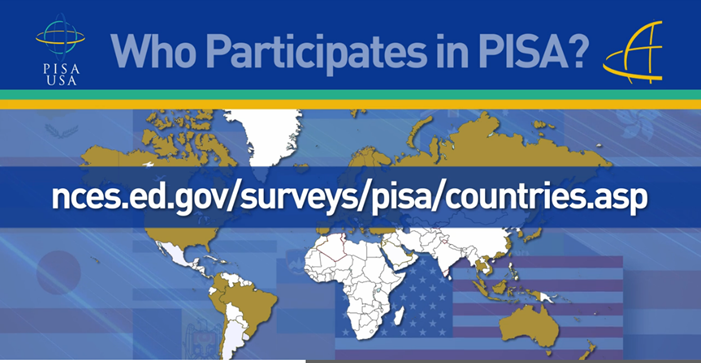
The National Center for Education Statistics website provides a list of each of the countries and education systems that are participating, and provides a look at historical participation in PISA.
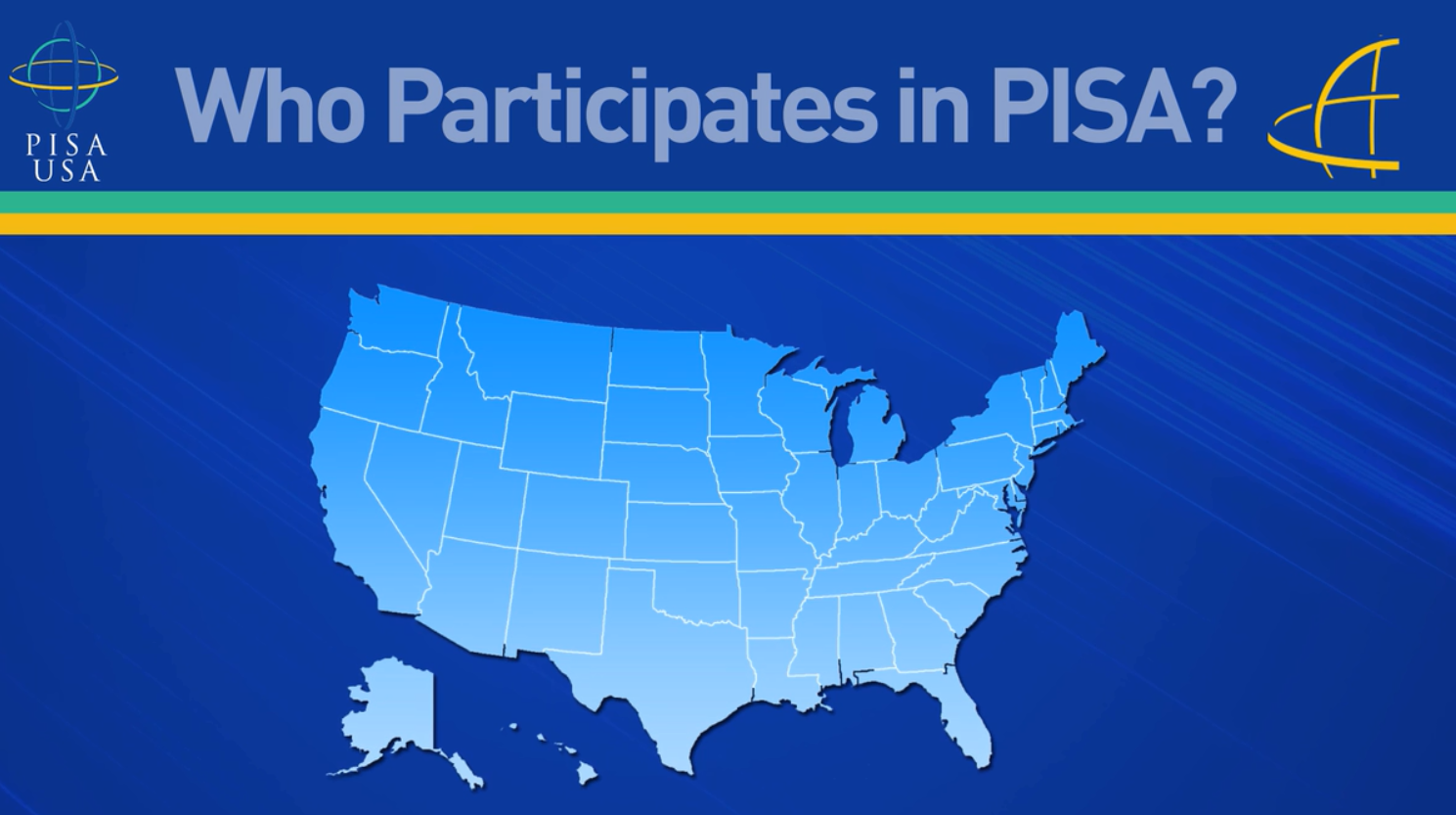
Who participates in PISA within the United States? PISA samples schools across the country to take part in the assessment. Not every school in every state is asked to participate, since PISA relies on a sample of students and schools to represent all the students and schools like them across the country.
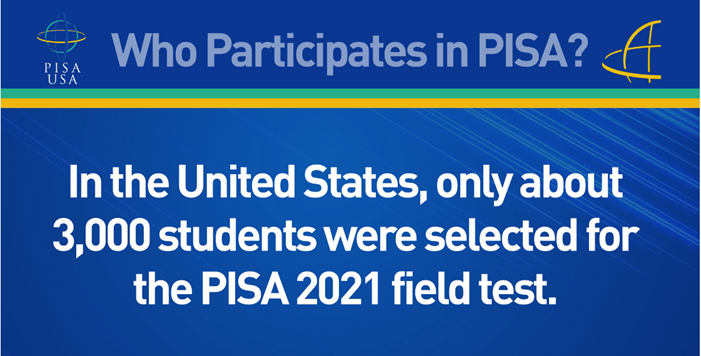
In the United States, only about 3,000 students were selected for the PISA 2022 field test. The PISA 2022 field test, conducted in the fall of 2021, is a small scale trial run of the PISA 2022 assessment.
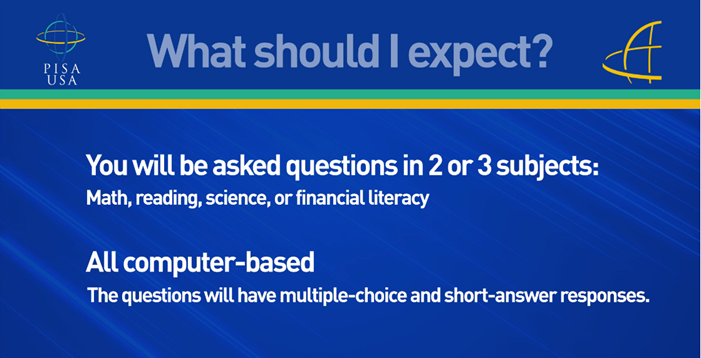
On assessment day, you will be asked questions in two or three subjects -- math, reading, science, or financial literacy. The questions will be based on real-life situations. Remember, PISA is about applying the knowledge you have learned in and out of school, and not just memorizing facts. In a few moments we will show you a sample PISA item.
PISA is completely computer-based. Assessment questions will be multiple-choice and short-answer. There are no essays or extended writing responses.
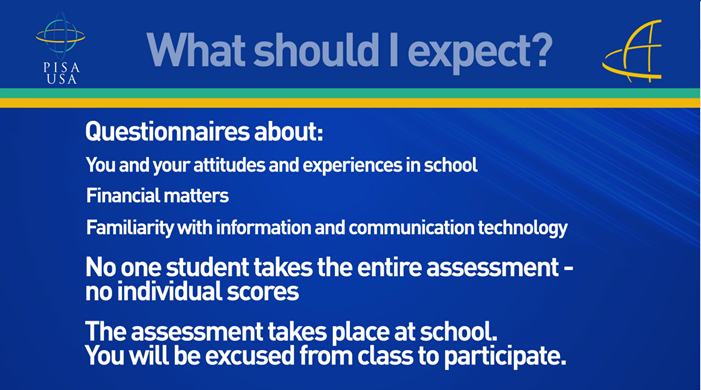
After the main assessment, you will be asked to complete questions about your attitudes and experiences in school, experience with financial matters, and your familiarity with information and communication technology. This helps policymakers learn more about students’ experiences and attitudes and how they relate to students’ level of knowledge and skills.
Because no one student takes the entire assessment, unlike many tests you take, you will not get your own score on PISA.
PISA takes place at your school. You will be excused from class during the PISA assessment.
Now, let’s take a look at an example item from previous PISA tests, and what you can expect to see on assessment day.
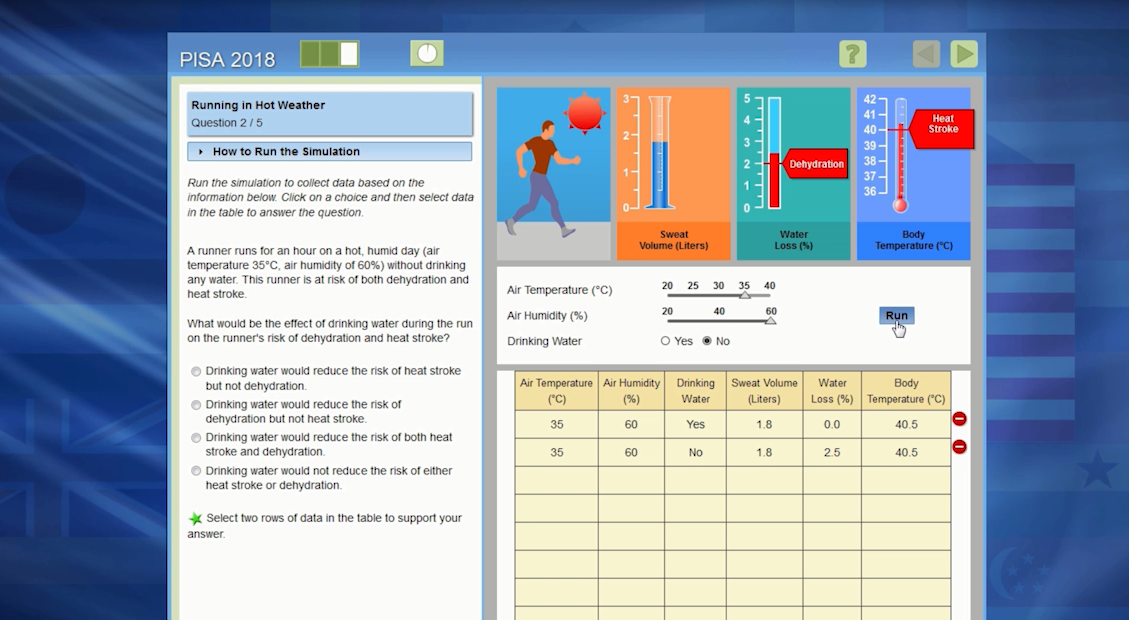
PISA items are presented in a layout in which the question, or description of the problem, is presented on the left side of the screen.
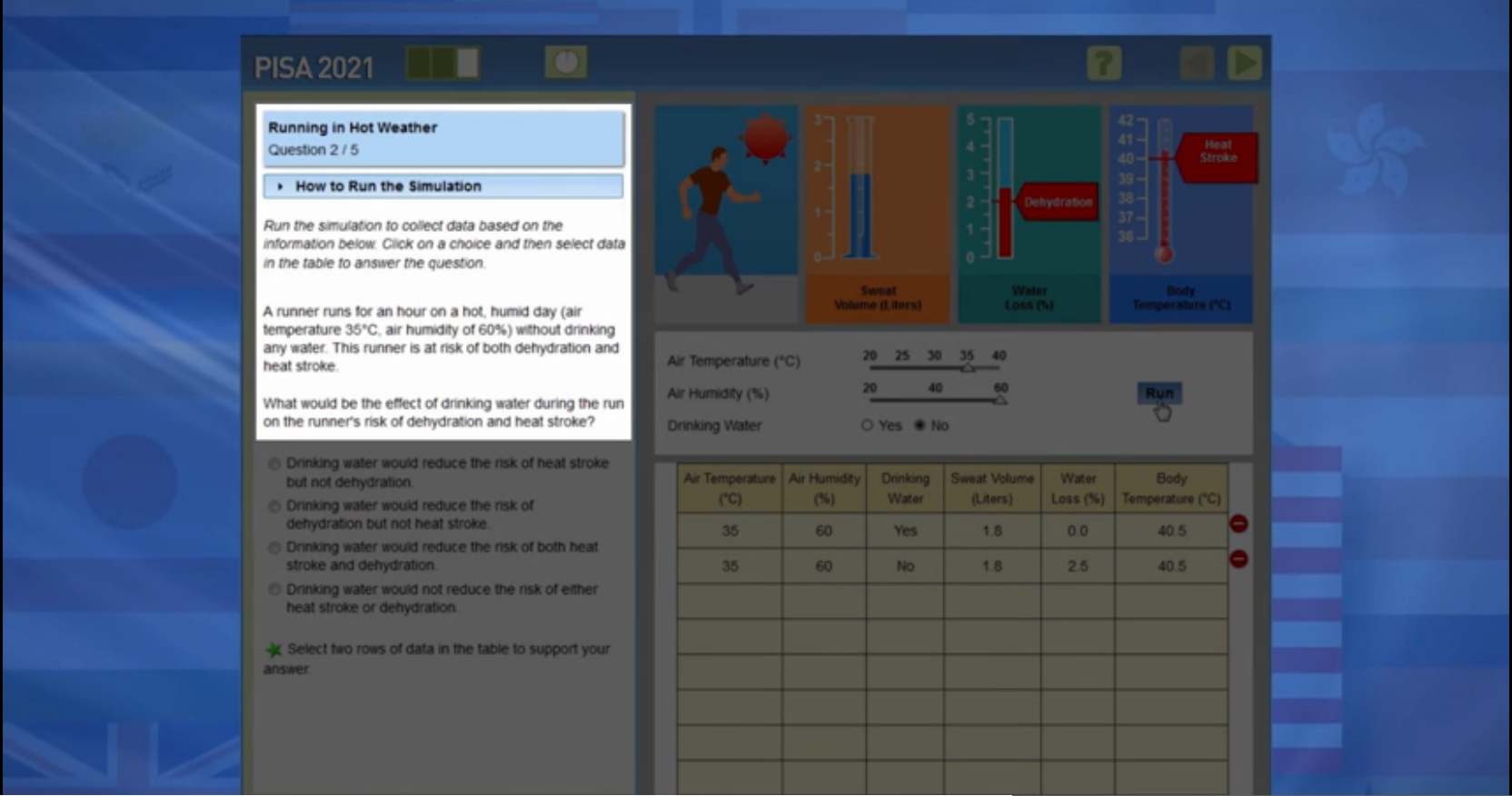
[highlight the left panel where question text is presented.]
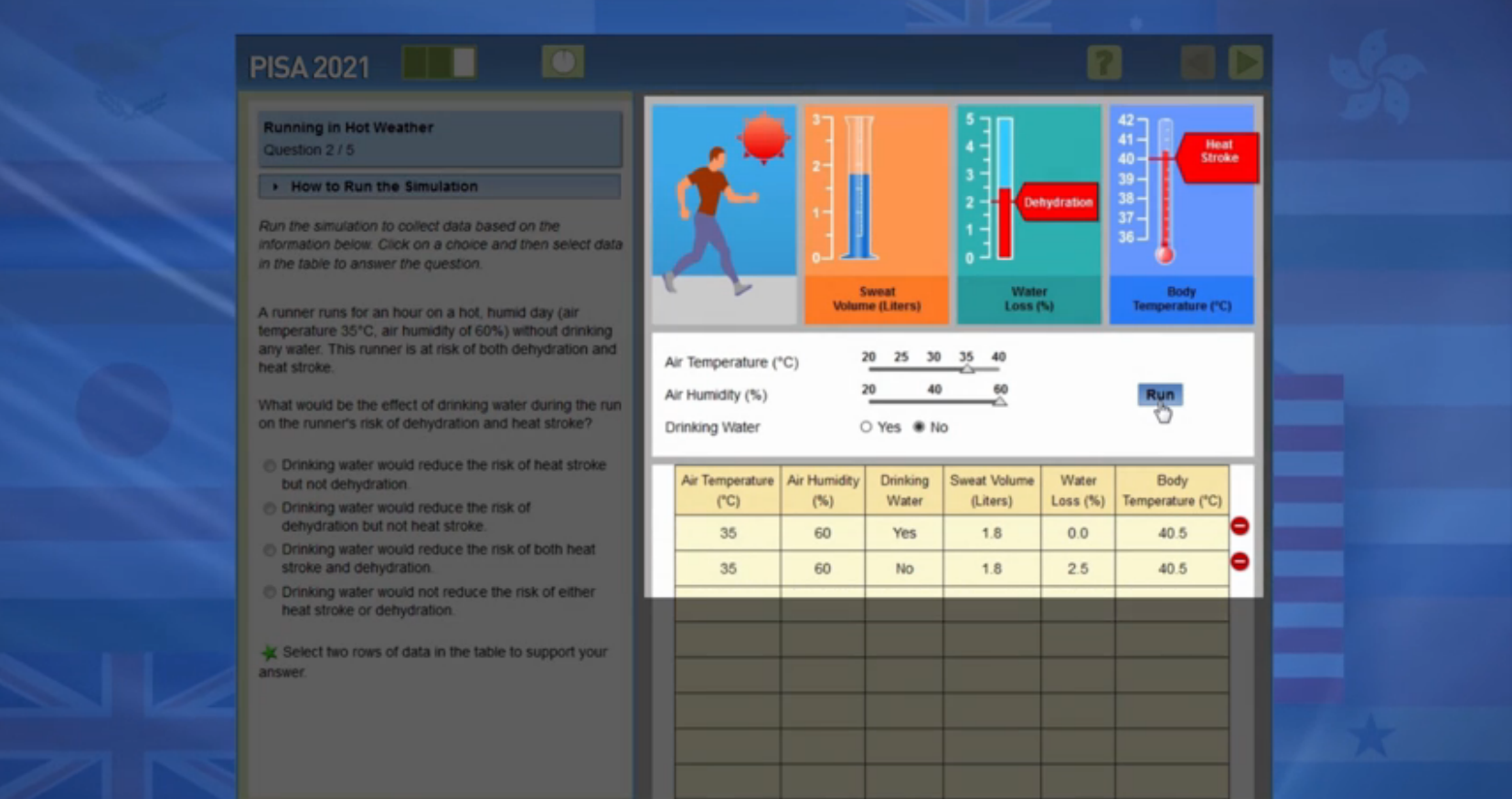
and the information you will use to answer the question is provided on the right side of the screen.
[highlight the right panel where simulation is presented.]
Many of the PISA questions are designed to simulate experiments, letting you manipulate different variables or conditions to produce data that will help you answer the question.
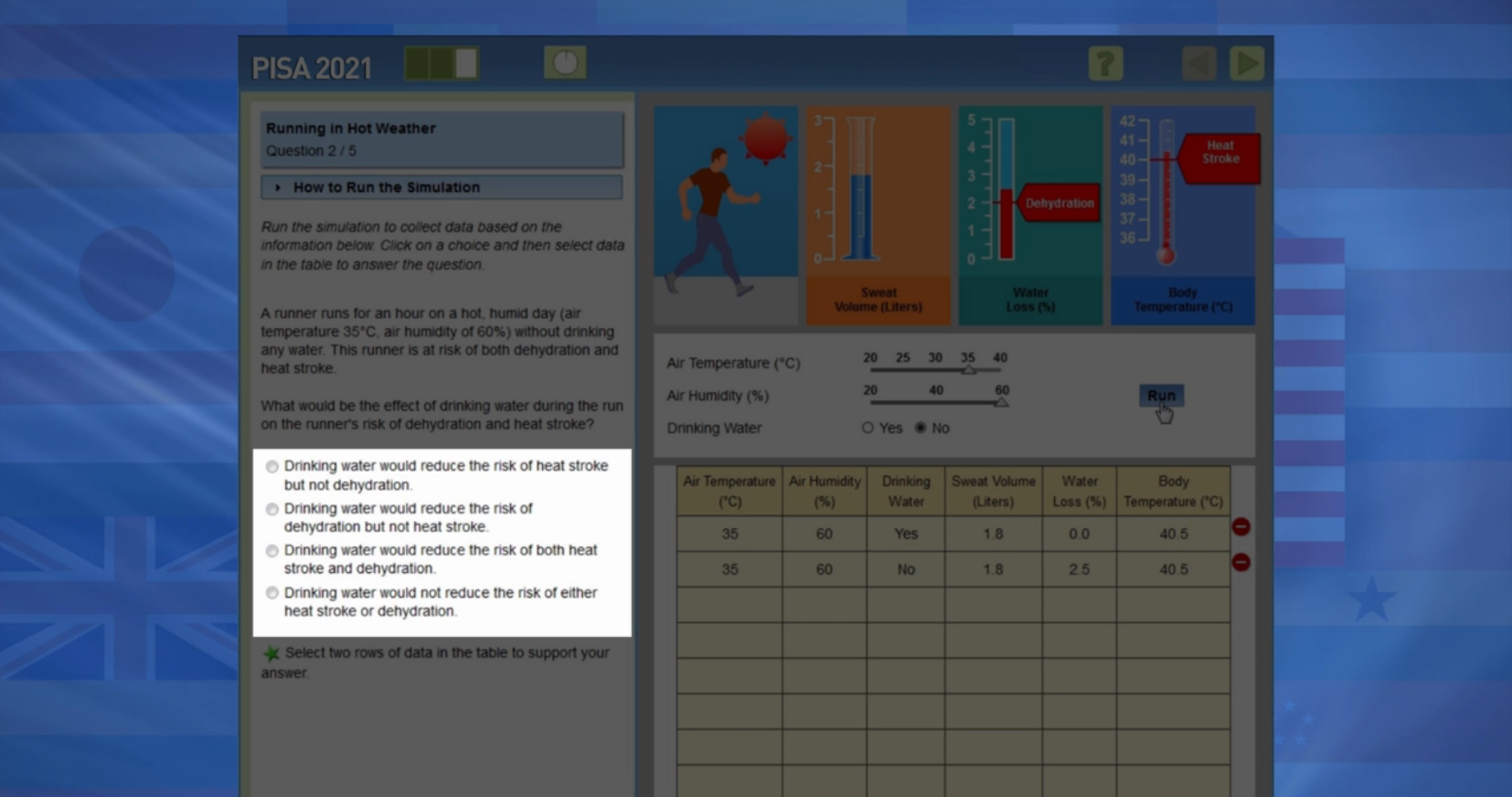
To answer questions, you will select an answer from a list of possible answers or enter a short a response.
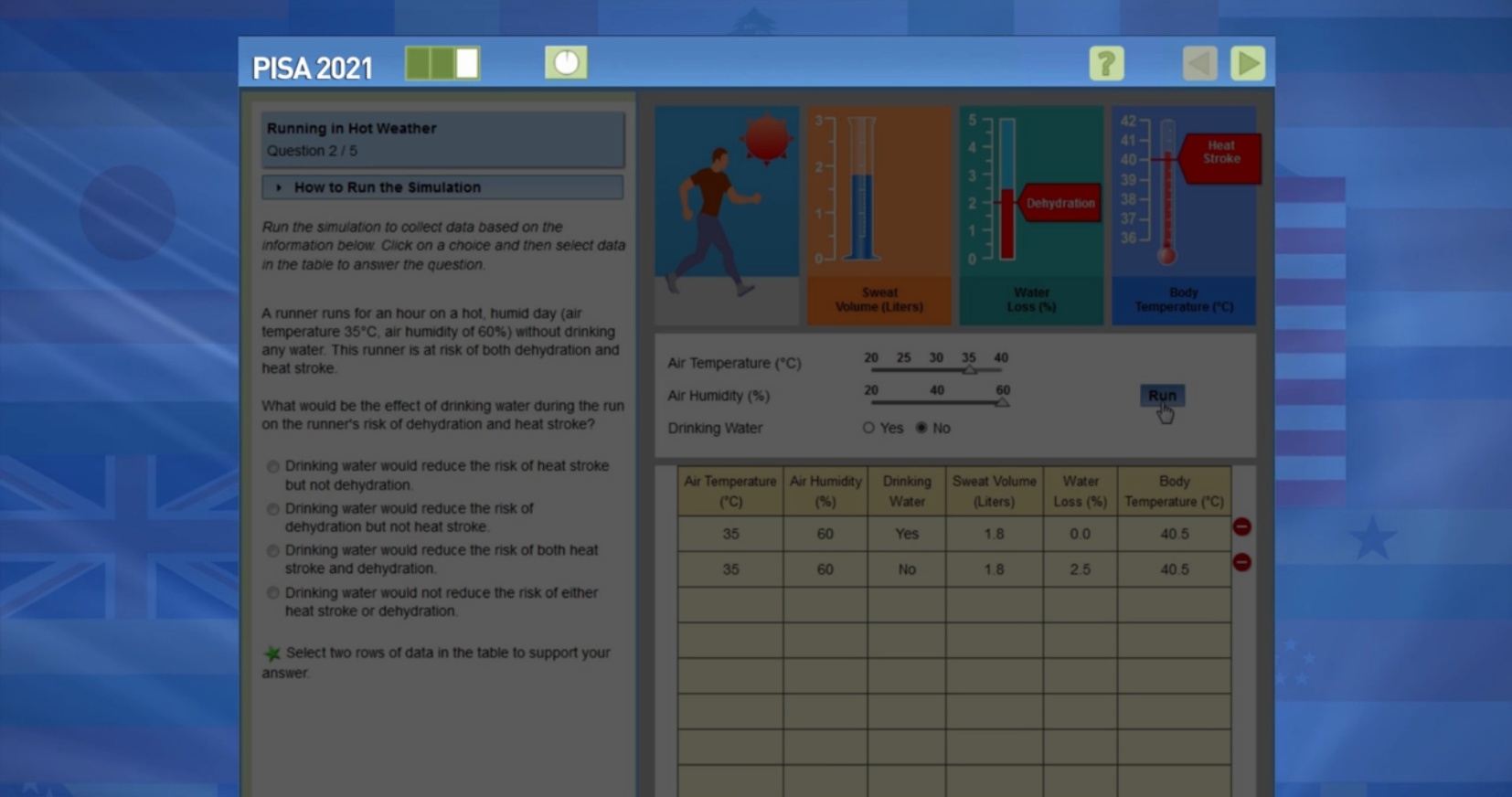
At the top of the screen, there are other tools available to you to answer PISA questions, including:
[highlight the top bar of the screen.]
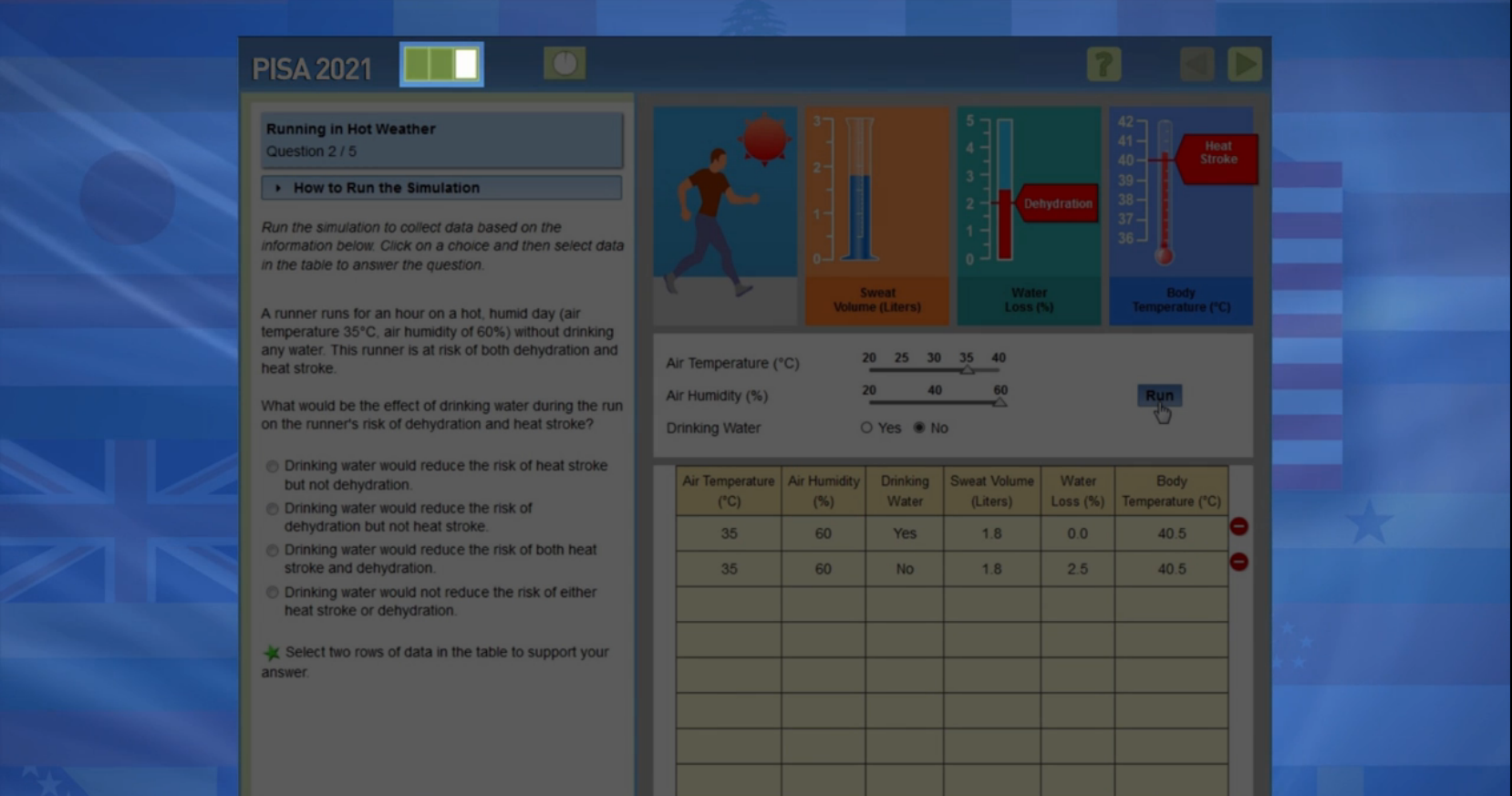
An indicator that shows your current progress in the assessment,
[highlight the green and white bars next to the PISA 2022]
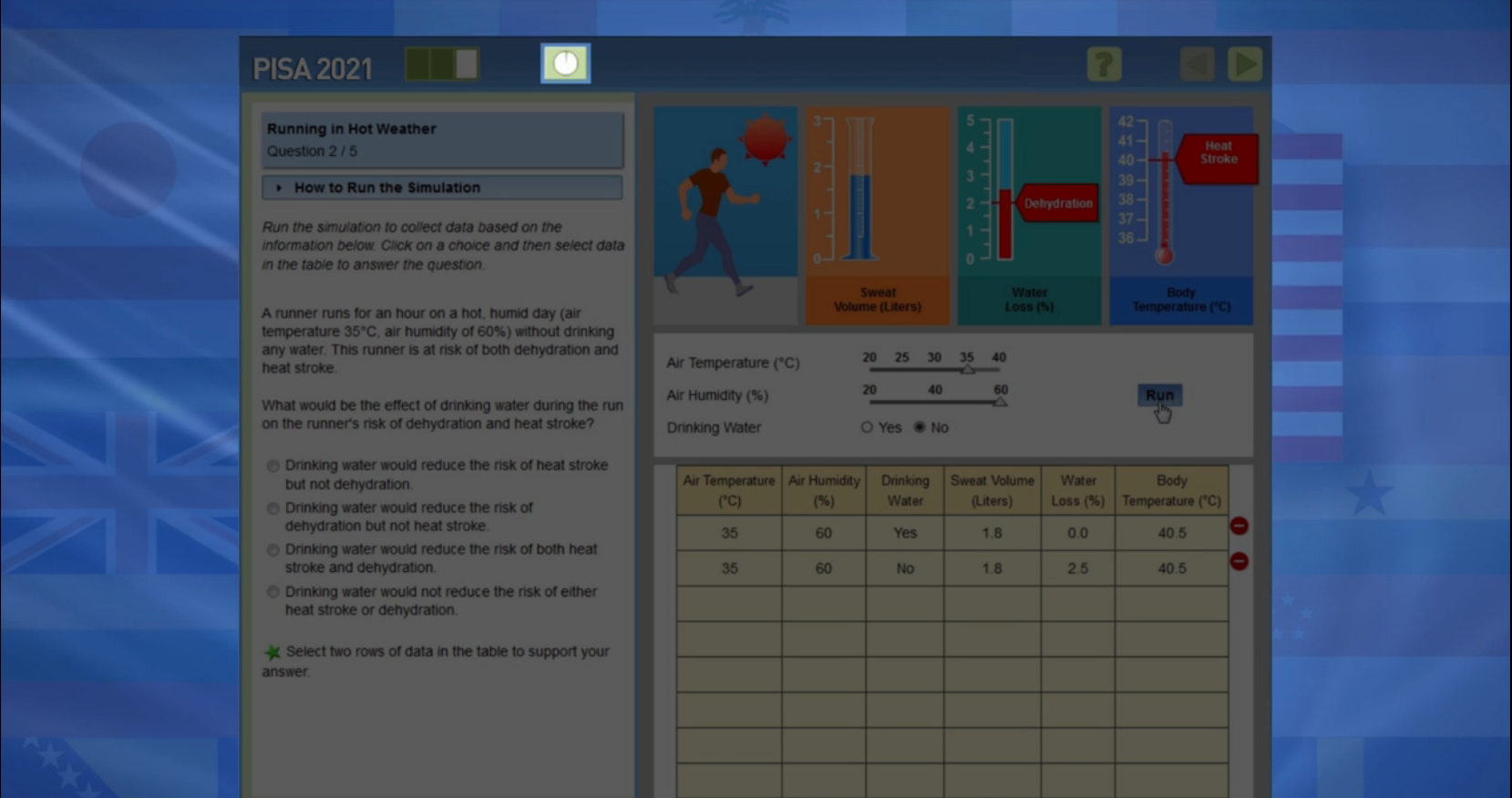
A timer that shows you how much time you have left to work,
[highlight the circle]
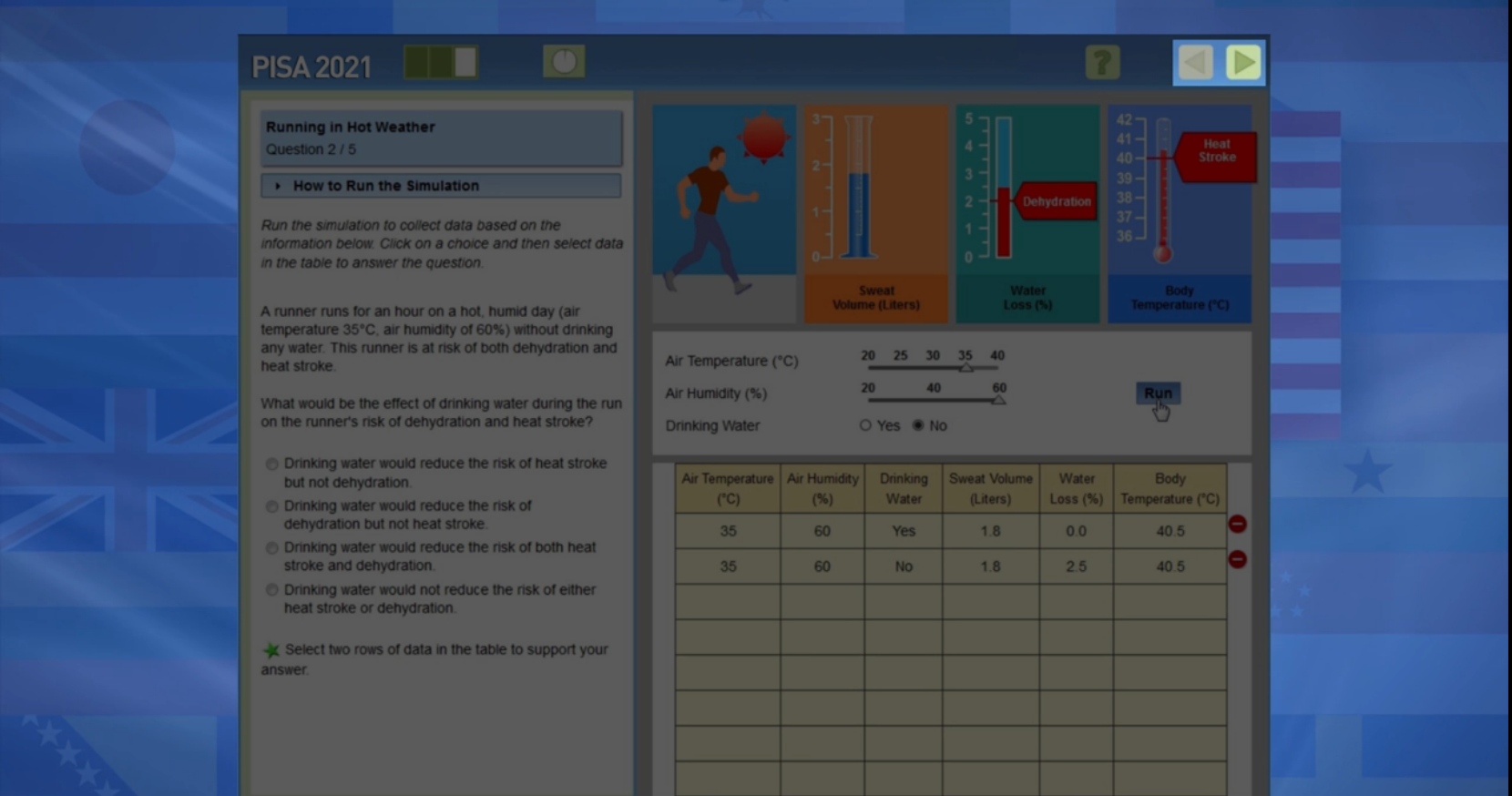
Navigation buttons that take you to the next question or back to the previous question,
[highlight the arrows]

And, for some items, if you see a question mark near the arrow buttons, there is additional information available to you in a Help Screen.
[highlight the question mark]
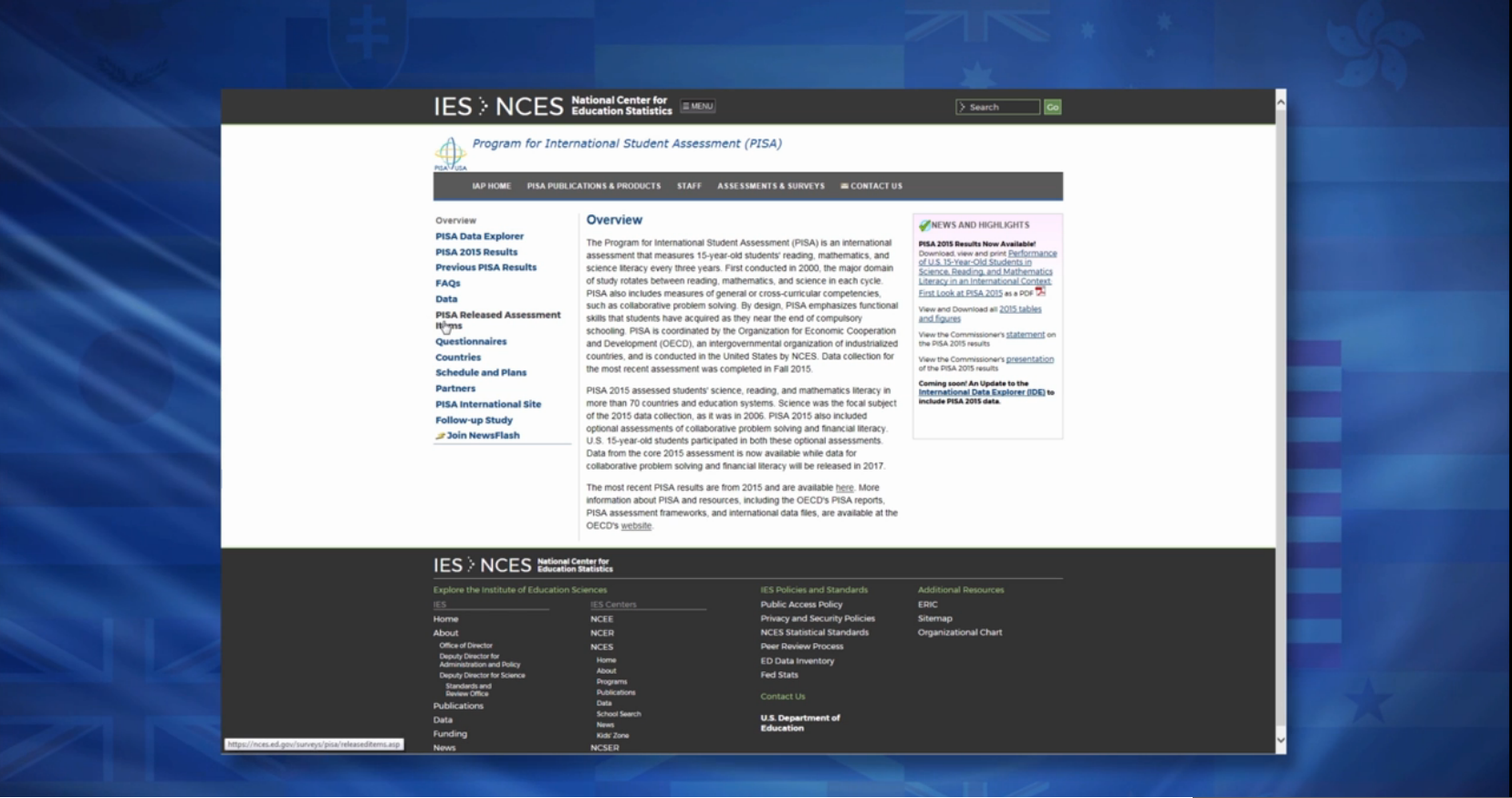
[Transition to the NCES PISA study site. No voice. See next screen.]
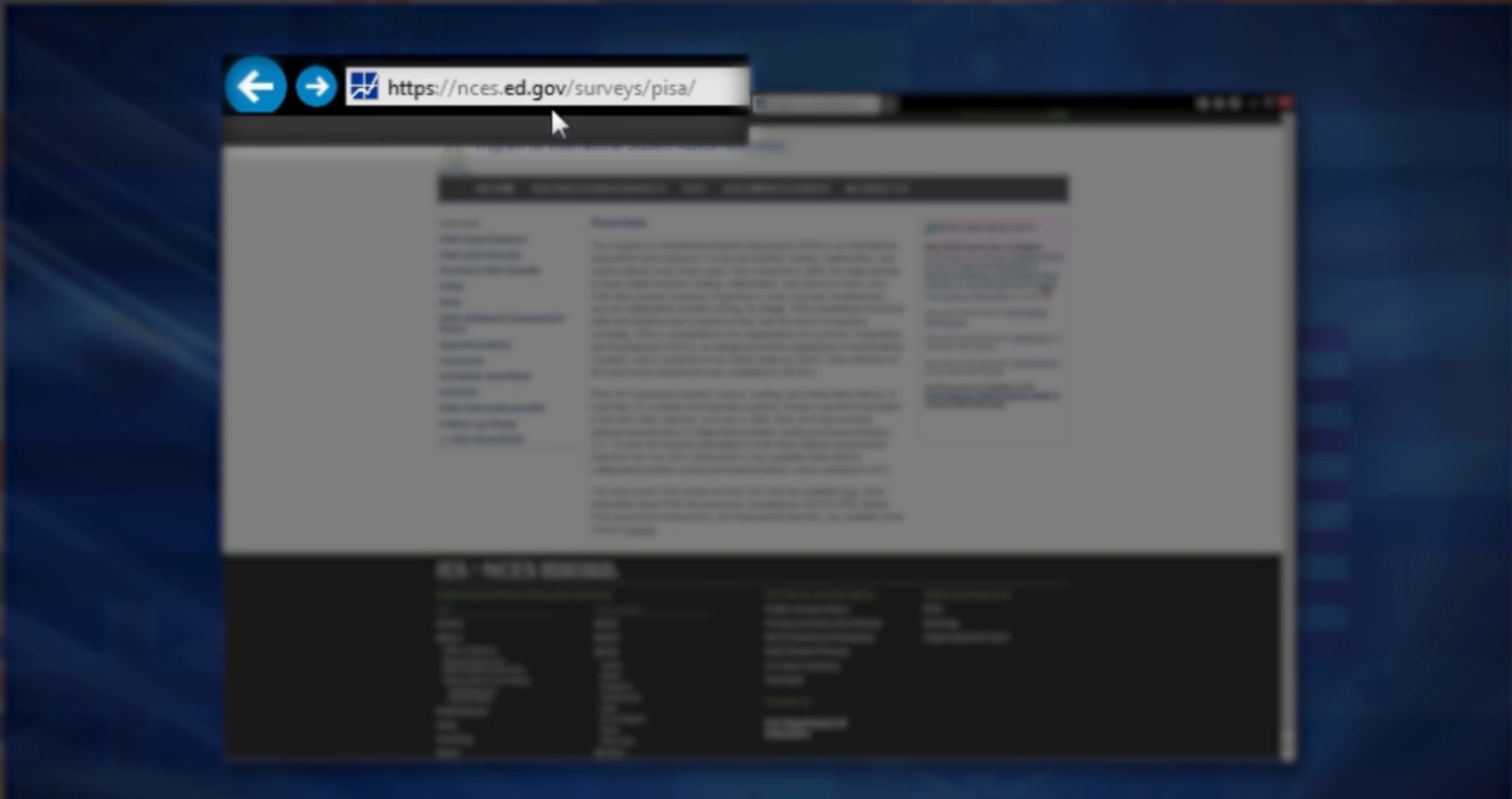
[Highlight the NCES PISA web address.]
The International studies website at NCES has questions that are similar to the ones you will take during the PISA test.

[Website address shrinks back and study page is clear]
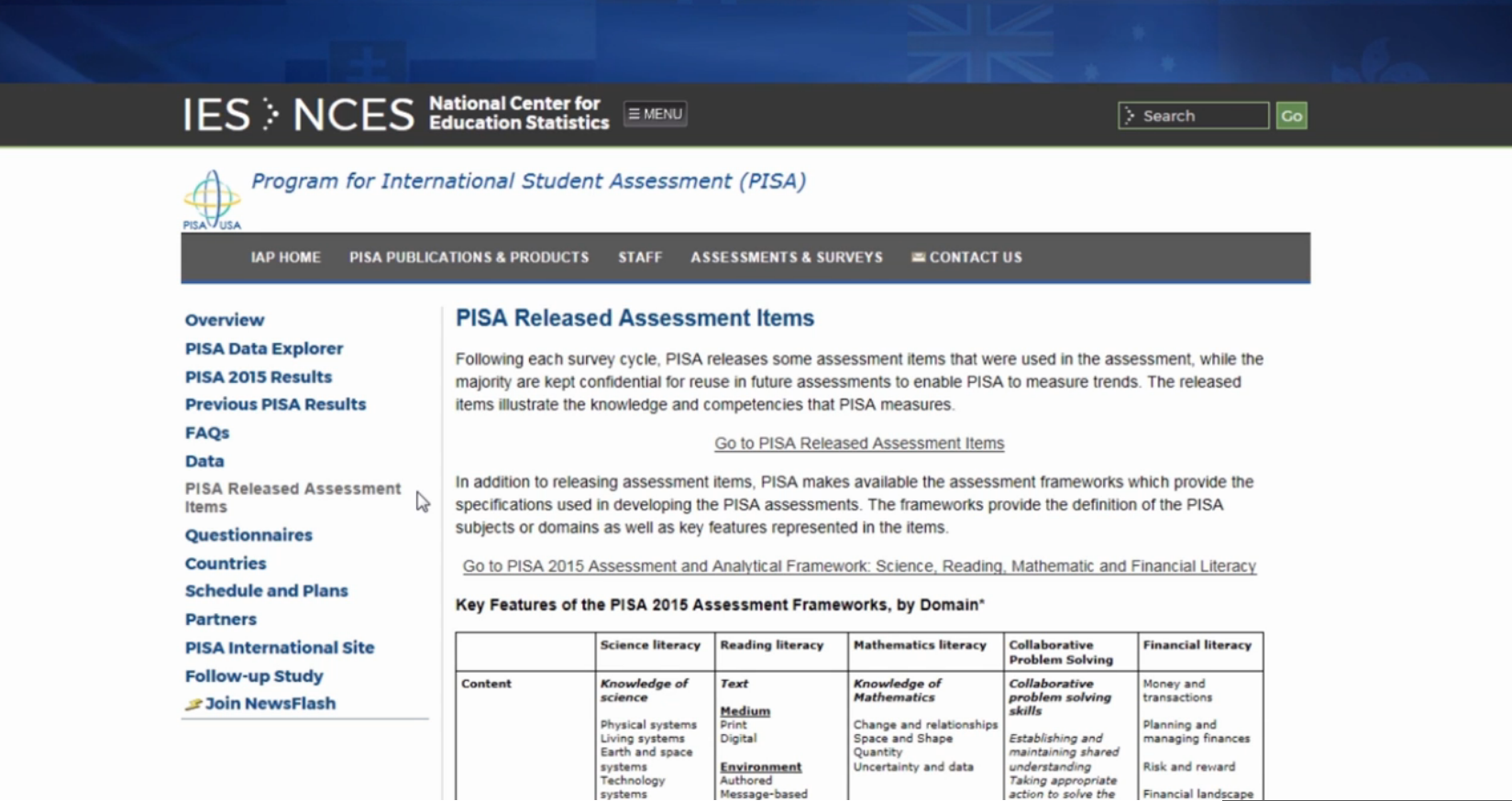
There are a few computer items that can be shared publically. Assessment items that are scheduled to be used again cannot be shared publically because they are confidential, and doing so would jeopardize the results.
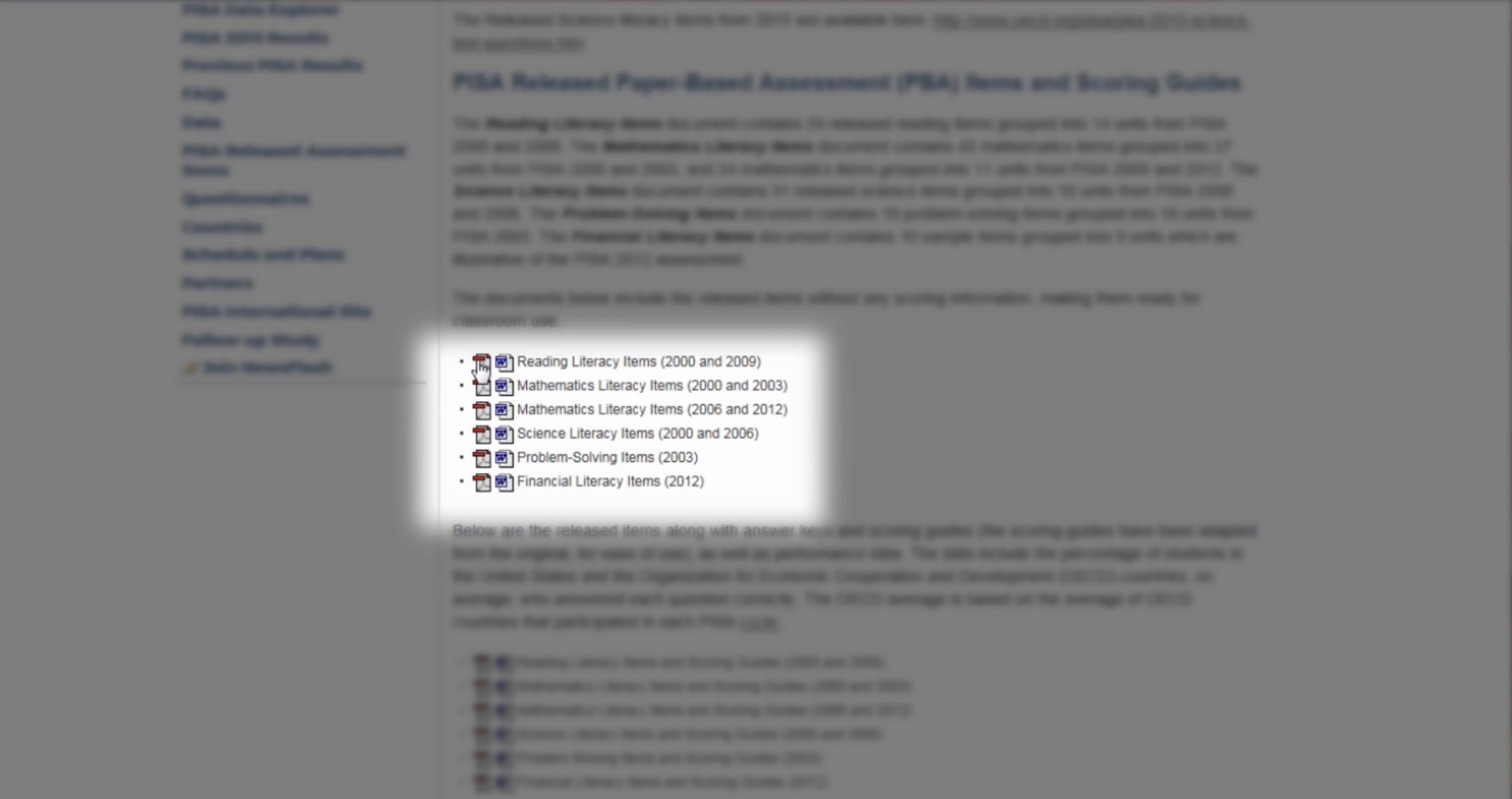
On the NCES released items page, you can click on the word version or PDF version of released items.
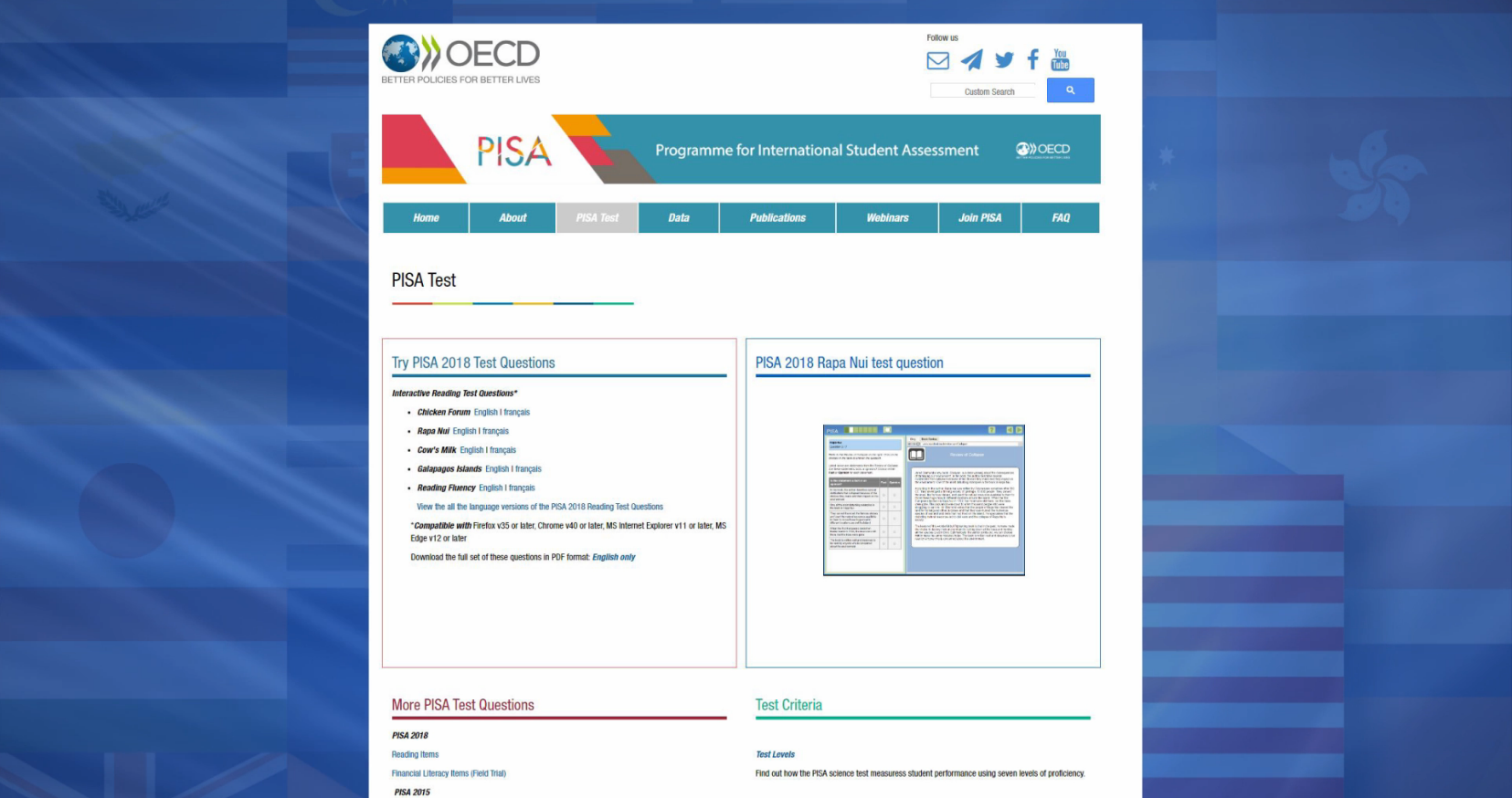
Another PISA resource with released assessment items and recent PISA results is the OECD website.
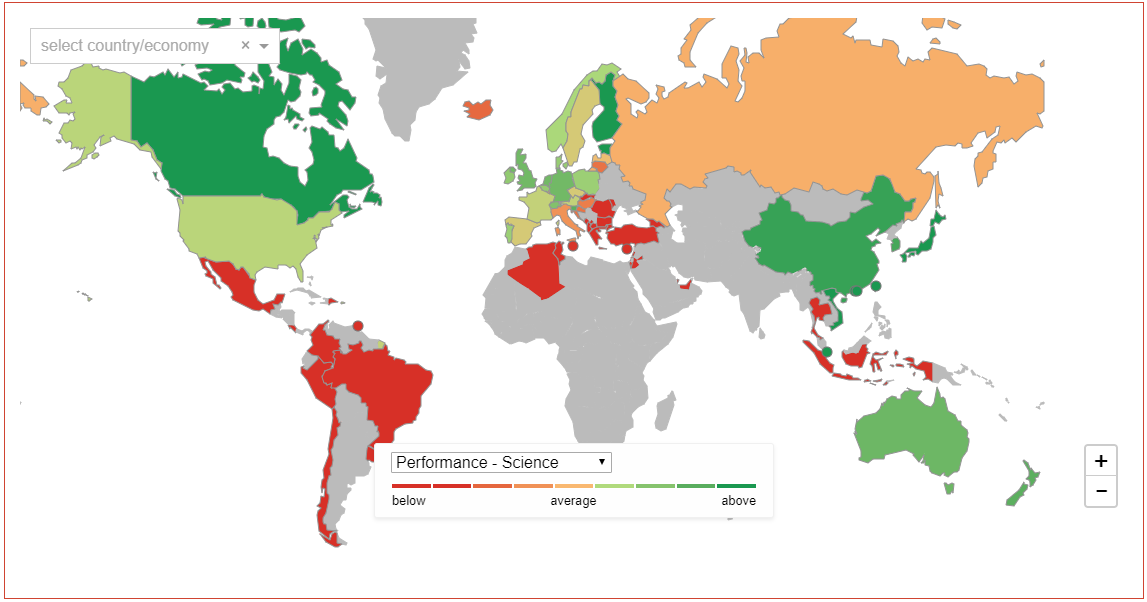
The OECD website for PISA includes interactive maps,…
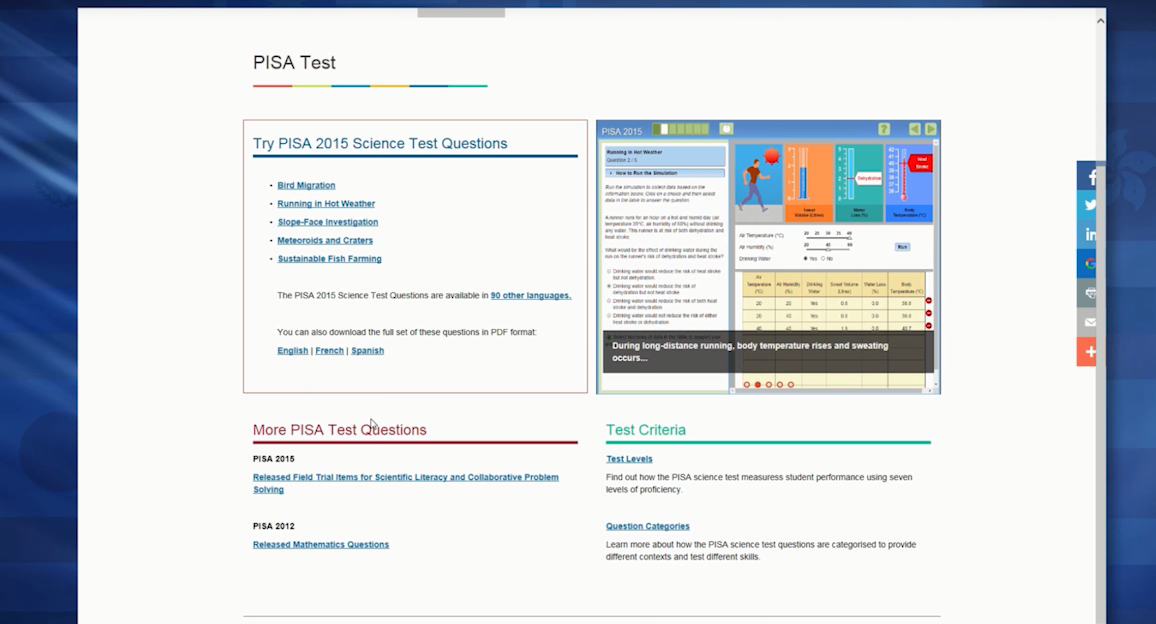
…released items,
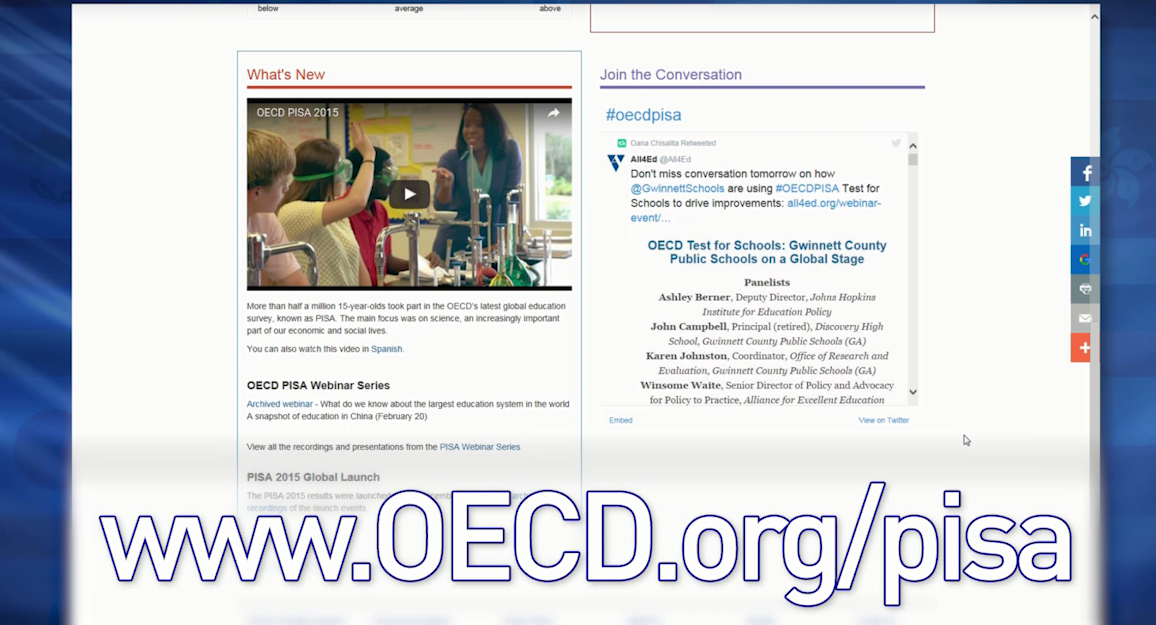
…and other PISA information and videos.
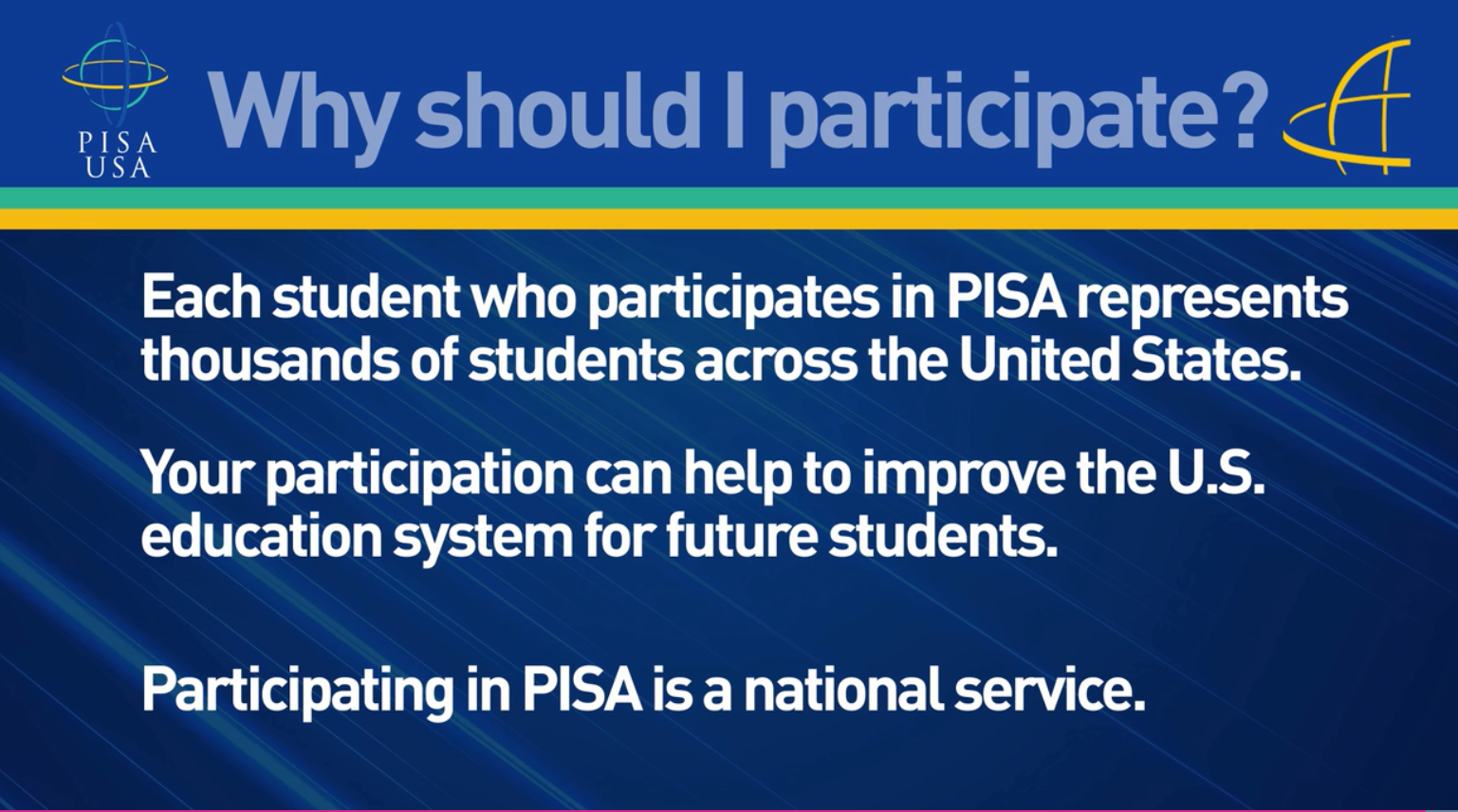
You play a crucial role in the success of PISA because you are the most important part!
Each student who takes part represents thousands of students across the nation.
Your participation can help improve the U.S. education system for future students.
AND you are also performing a national service.
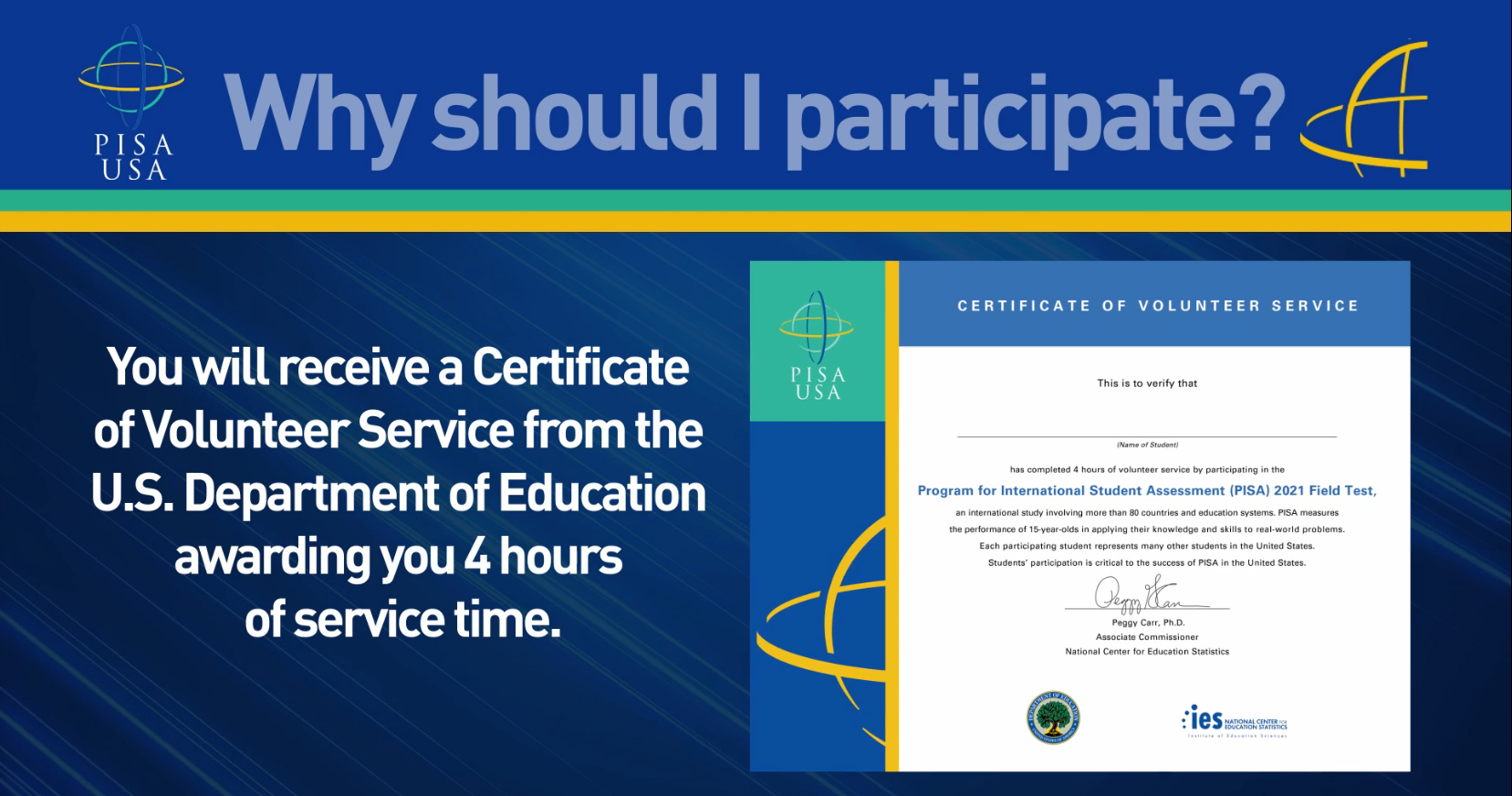
As a thank-you for participating:
You will receive a Certificate of Volunteer Service awarding you 4 hours of service time.
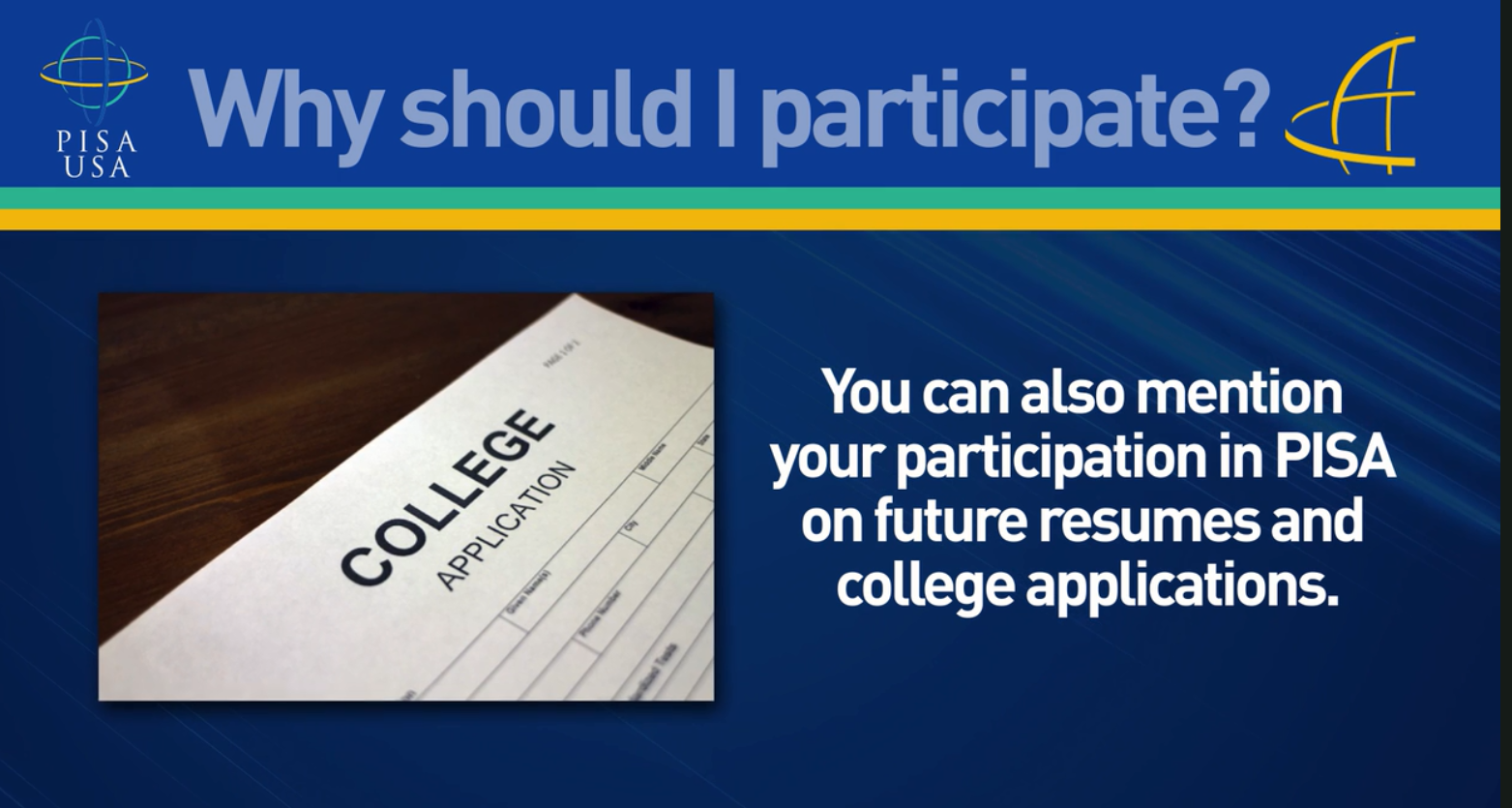
You can mention your participation in PISA on future resumes and college applications as an important assessment to which you contributed.
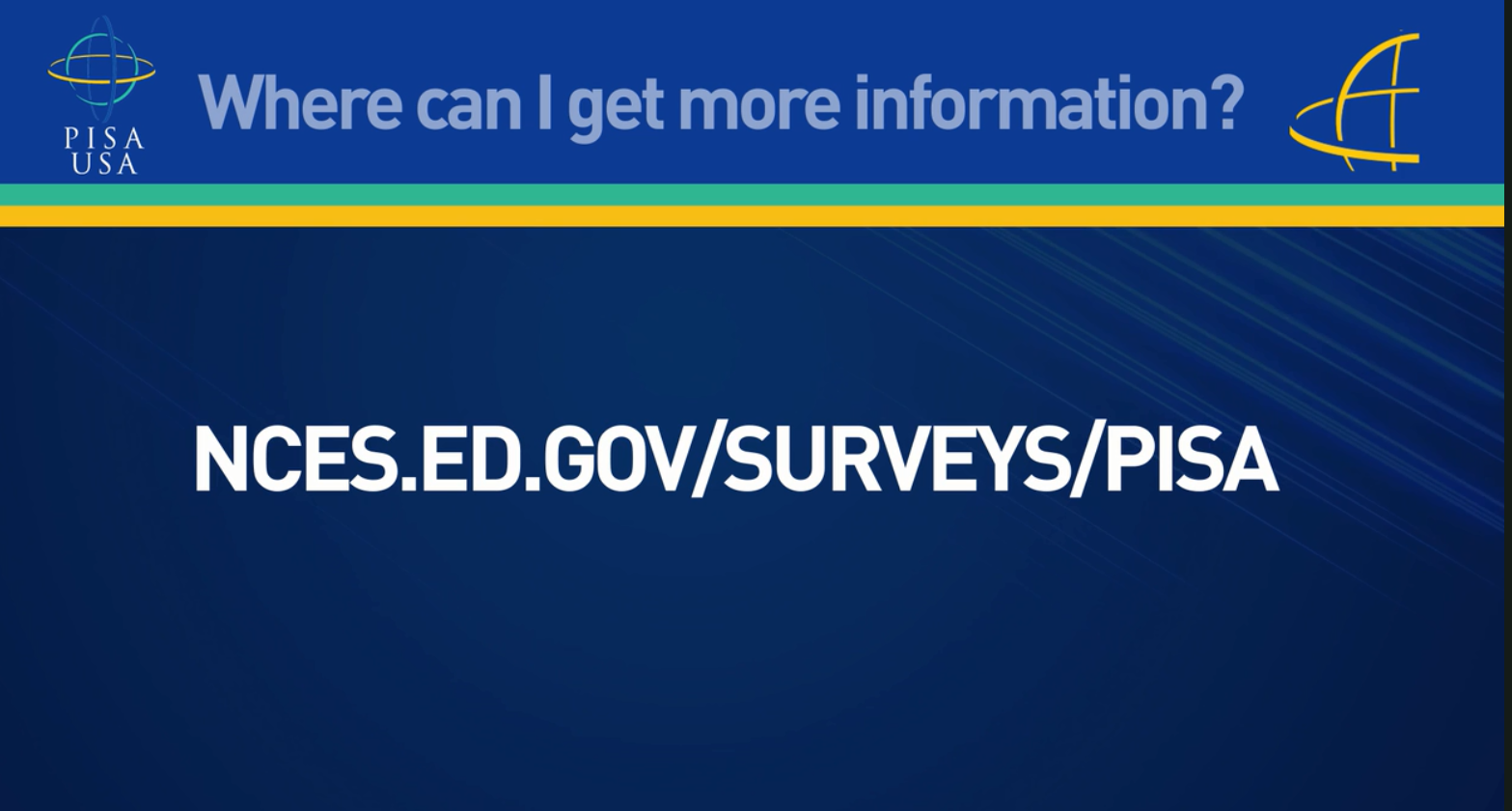
There is a lot of information about PISA. It is most easily found on the PISA website at the National Center for Education Statistics.
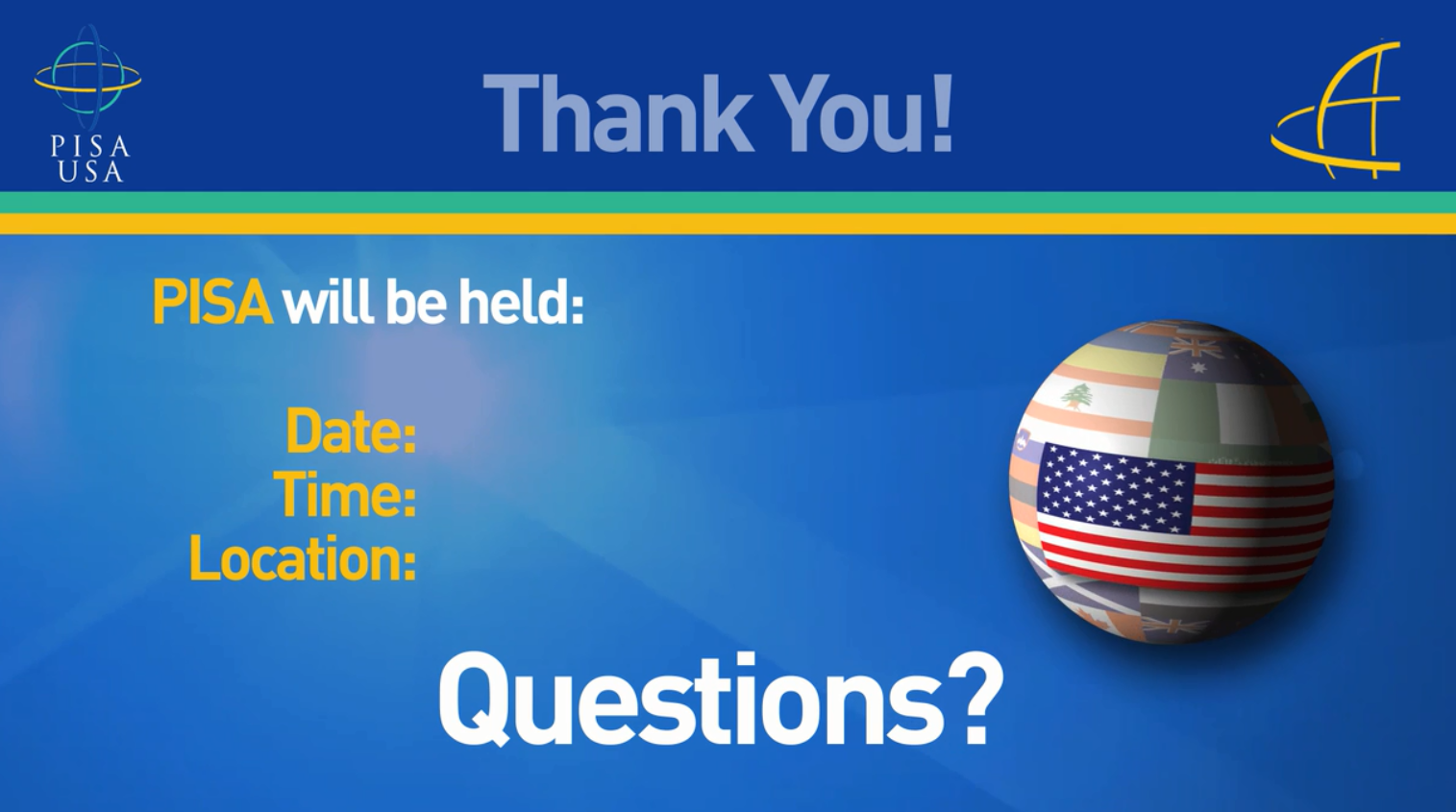
Thank you for your time and participation in PISA. Your PISA School Coordinator or Test Administrator will now share with you the details of when PISA is happening in your school.
| File Type | application/vnd.openxmlformats-officedocument.wordprocessingml.document |
| Author | Bill DeBaun |
| File Modified | 0000-00-00 |
| File Created | 2021-03-02 |
© 2025 OMB.report | Privacy Policy











 Ext:
Ext: 


 Ext:
Ext: 
